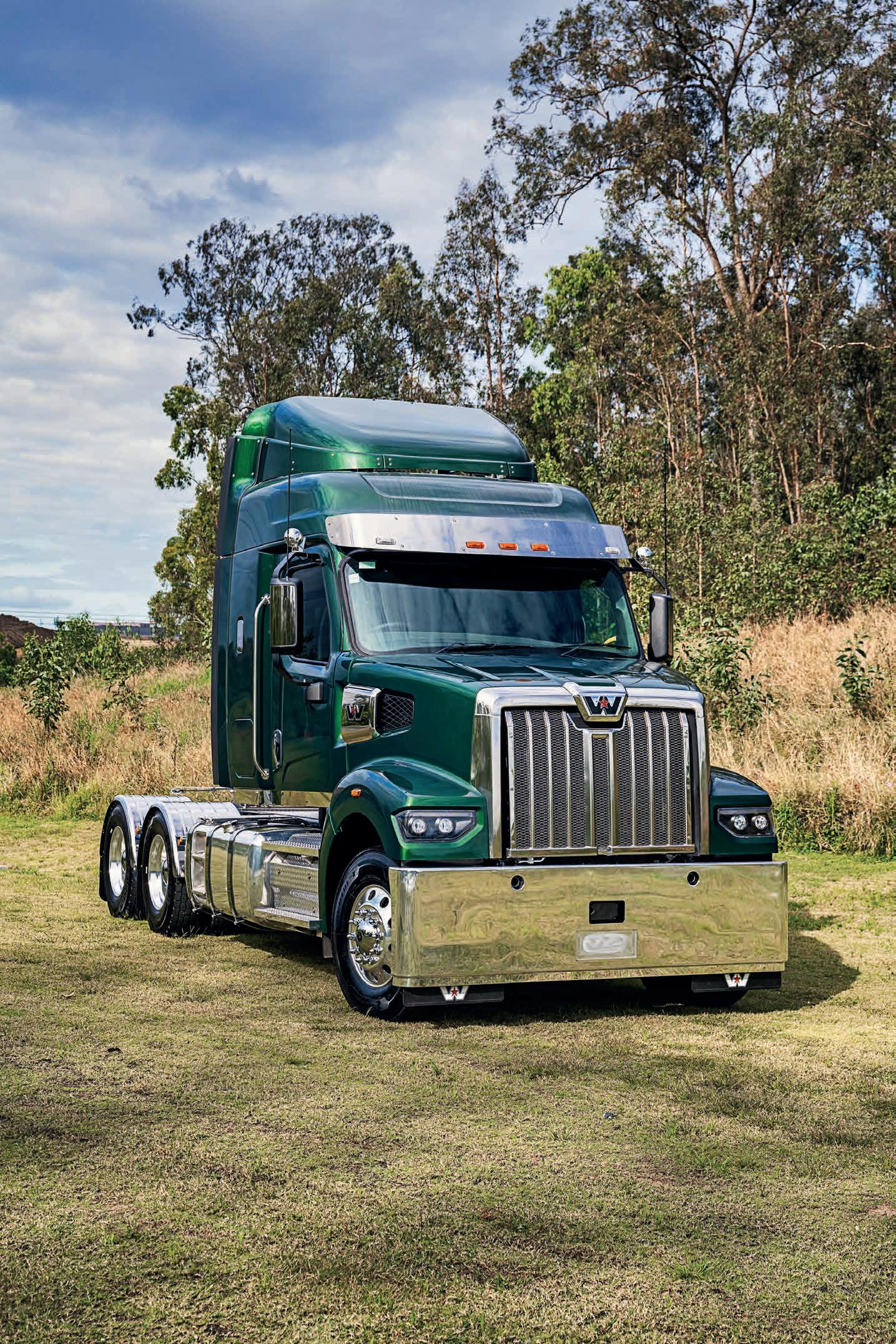

9771445115000 01 MAY/JUNE $8.95 including GST TRUCK OF THE YEAR AUSTRALASIA RURAL TRANSPORT RISING STAR TWO NEW ELECTRIC TRUCKS TRUCKS ON TEST AND THE WINNER IS….































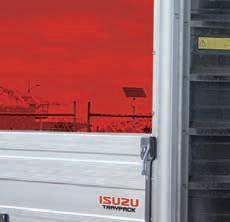





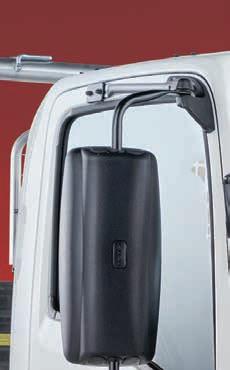
















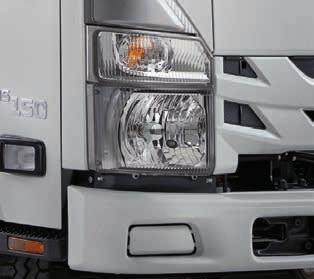








If you’re ready to get serious about tackling bigger jobs, grab yourself an NLR 45-150 AMT SWB Traypack from the Ready-to-Work range for $62,990† drive away. And to prove we aren’t playing, buy any NLR Traypack before June 30 and you’ll get $3,500* to spend on genuine accessories or a service agreement. So, now’s the time to trade up from your ute. Head to isuzu.com.au or visit your nearest Isuzu Truck Dealer now.






†O er One: NLR 45-150 AMT SWB Traypack (Promotion Truck) drive away between 1 April 2024 – 30 June 2024. Drive away price of $62,990 for the Promotion Truck includes GST, or a service agreement. Non-transferable or redeemable. Fleet and Government purchasers are not eligible. Visit isuzu.com.au for terms and conditions. FSA/ISZS2047 READY-TO-WORK NLR TRAYPACK RANGE Playtime’s over, get $3,500* to spend on extras. NLR 45-150 AMT SWB TRAYPACK
DRIVE † AWAY
$62,990









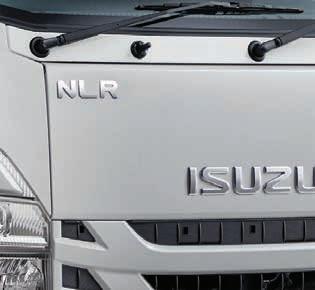















































































registration, government and statutory charges, and dealer delivery costs. *O er Two: Buy any Ready-to-Work NLR Traypack vehicle and receive $3,500 value for genuine accessories or a service agreement.
Versatility that’s good for business

DAF is a versatile all-rounder with the perfect combination of superior comfort and luxury for the driver and maximum vehicle efficiency for the operator. So, you need a truck for a hook lift system with excellent manoeuvrability and a high payload? There’s a DAF for that!
Whether your needs are distribution, long-distance haulage or construction, the versatility of DAF keeps you moving, and that’s good for business. DAF.COM.AU
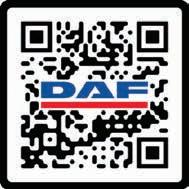
SEE DAF VERSATILITY IN ACTION DAF PURE EXCELLENCE
A PACCAR COMPANY DRIVEN BY QUALITY

14 AND THE WINNER IS….
The winner of the Truck of the Year Australia was announced and presented at the Teletrac-Navman Technical Maintenance and Safety Conference, recently, on 13 March 2024 in Christchurch, New Zealand.
22 SMOOTH RIDE IN THE CITY
This first test drive of the second generation Fuso eCanter demonstrates how city delivery in the latest electric truck is going to give the driver a smooth ride in the city.
30 THE ECONOMICS OF TRUCKING’S CARBON ZERO
Looking at the realities which will face transport operations as they migrate across from fossil fuel dependency to the zero carbon economy, one of experts in the field examines some possible scenarios.
48 CLOSING LOOPHOLES EXPLAINED
In her report back to the Livestock and Bulk and Rural Carriers Association conference, the Executive Director of the Australian Livestock and Rural Transporters Association, Rachel Smith’s speech saw the recent act passed in Federal Parliament on closing loopholes explained.
54 TAKING PBS FORWARDS
One of the most influential movers in the development of Performance Based Standards explains how the scheme is preparing for the next twenty years, taking PBS forwards and developing it further.
50 GETTING ALL THE ELECTRONICS TO TALK TO EACH OTHER
Trucking operators are now adding more and more electronic equipment to their combinations and need to ensure they can all talk to each other when needed, especially when they are used for compliance.
Contents ISSUE 140
ADELAIDE DARWIN PERTH MACKAY SYDNEY MELBO URN E BR IS BANE NEWCASTLE/HUNTER VALLEY TAMDELE, 21 Hakkinen Road, Wingfi eldSA 5013 Ph. 08 8347 1222 email sales@gitsham.com.au web www.gitsham.com.au Mobile Sales and Service Ph. 08 8927 0986 email info@isridarwin.com.au web www.isridarwin.com.au 408 Welshpool Road, Welshpool WA 6106 Ph. 08 9361 7646 email info@mmtisri.com.au web www.mmtisri.com.au 110-120 Maggiolo Drive, Paget QLD 4740 Ph. 07 4952 1844 email admin@isrimky.com.au web www.isriseatsmackay.com.au 510 Victoria Street, Wetherill Park NSW 2164 Ph. 02 9756 6199 email isri@isri.com.au web www.isri.com.au Unit 1/569 Somerville Rd, Sunshine West VIC, 3020 Ph. 03 9311 5544 email sales@isrisunshine.com.au web www.isri.com.au 3/120 Gardens Drive, Willawong QLD 4110 Ph. 07 3275 2044 email sales@isribrisbane.com.au web www.isribrisbane.com.au Unit 2/13 Hinkler Ave, Rutherford NSW 2320 Ph 02 4932 0600 email sales@hvss.com.au web www.isri.com.au ISRI: DEALERS

A NORMAL ELECTRIC TRUCK
The integration between the new technologies and the driver interface makes taking a trip in the new Mercedes Benz eActros more like driving a normal electric truck 38

A RISING RURAL STAR IS NAMED
In its second year, the Rural Transport Rising Star Award attracted another group of young people who are going to take the rural transport industry onwards and upwards into a, hopefully, bright future.
Standard Issue
46 ALRTA COMMITTED TO DRIVING CONTINUOUS IMPROVEMENT TO ANIMAL WELFARE STANDARDS
Driver and animal welfare continues to be a principal issue for the Australian Livestock and Rural Transporters Association and its members, writes Executive Director Rachel Smith.
49 NHVR TRANSITIONS INTO QUEENSLAND REGULATION
The NHVR is now seen across Queensland, following the transition of heavy vehicle safety services, writes Sal Petroccitto OAM, NHVR CEO.
68 CHARGING AHEAD
From my experience truck manufacturers overexaggerate the capabilities of their electric vehicles, reckons PowerTorque’s European Correspondent, Will Shiers.
72 HEADING INTO THE TRUCKING FUTURE
Industry stalwart, Bob Woodward, looks back on the developments in technology and wonders. Over the past 35 years there has been significant improvements in productivity longer combinations with heavier axle groups within the Australian road transport fleet. Increased axle group mass has been concurrent with developments in suspension systems, longer new combinations have resulted from research and broadened knowledge of vehicle dynamics.
76 WORN HANGER REPAIR
Hangers are not an item that normally wear. However, they may become gouged or worn from a loose pivot bolt or wear washers that have worn through.
78 REFRIGERATION TRANSITION PART THREE
In this final instalment of our three part series of articles exploring the transition of refrigerated transport across to zero emission running, we will explore some of the solutions we will see on our roads in the near term.
the brand behind the brands
• Supporting drivers for more than 50 years
• Seating – on a higher level


0297566199 isri@isri.com.au
www.isri.com.au
ISRI SEATS 44
ATA CALLS FOR FWC FOCUS
The Australian Trucking Association has called on the federal government and the Fair Work Commission to ensure that truckies are getting a fair go in the new laws included in the Closing Loopholes Bill.
ATA Chair David Smith raised concerns over payment terms and fuel surcharges in its road transport contract chain orders. The FWC now has powers to make decisions on such matters.
The call arrived after the ATA’s February meeting.
“Payment terms and fuel surcharges are a longstanding problem for trucking businesses,” he says.
“We believe the industry and the TWU should be able to achieve a common position on these issues for the commission to consider.”
TWU National Secretary Michael Kaine supports David’s notion.
“Dangerous practices such as elongated payment times that push unsustainable financial risk onto transport operators and owner drivers on wafer-thin margins will be first cab off the rank,” he says.
The ATA and TWU will work together to ensure the FWC sets fair guidelines on these issues, as well as employees’ ‘right to disconnect’ when not on the job.
PAVING THE WAY FOR THE FUTURE OF HEAVY ELECTRIC VEHICLES
Queensland is paving the way for the future of heavy electric vehicles with the recent announcement of the state government’s next step in its Zero Emission Heavy Vehicle Network Map.
Heavier electric vehicles are set to be allowed to drive on certain freight routes in the state – predominantly in South East Queensland – with an eye on the further distribution and manufacturing of bigger and more powerful electric trucks in the state. State transport minister Bart Mellish says that Queensland wants to become a nationwide and global leader in the uptake of heavy electric trucks.
“This announcement will put Queensland on the map as a leader in future electric truck manufacturing,” he says.
“As transport is one of the main contributors to Queensland’s emissions, zero emission heavy vehicles can make a significant contribution to meeting Queensland’s targets to reduce emissions by 30 per cent below 2005 levels by 2030 and achieving net zero emissions by 2050.” There are risks that have to be considered regarding the additional mass of these vehicles, but the state
government reaffirms that zero emissions heavy vehicles are the future of the state.
This will allow electric vehicles with a steer axle mass of up to eight tonnes on freight roads in Queensland.
This has already allowed a company like Followmont Transport, a Brisbanebased organisation, to take delivery of the country’s first Volvo FH Electric.
The FH Electric prime mover only arrived in Australia a week before the handover in anticipation of the changing of the heavy electric vehicle rules.
It will be tasked with shuttling trailers between Followmont’s Eagle Farm depot, servicing major accounts around Brisbane and running overnight linehaul to the company’s Toowoomba and Sunshine Coast depots.
The 540kWh, 666hp FH Electric prime mover is currently rated to 44 tonnes and has a range of up to 300km on a single charge. A 60kW charger has been installed on site at Followmont’s head office for overnight charging, with plans to install charging solutions further afield as the company seeks to increase reach and range.

8 NEWS & VIEWS POWERTORQUE May/June 2024
IMAGE: VOLVO GROUP AUSTRALIA
EFFECTS OF ROAD TOLL PRIVATISATION
The effects of toll road privatisation in New South Wales have come to the forefront after the release of the Independent Toll Review interim report by Professor Allan Fels on March 11.
According to the review, significant reform is needed after damage across a number of years and various legislation which has failed to ease the burden on motorists.
The review first began in the first half of 2023 when Professor Fels and Dr David Cousins were asked to independently assess the efficiency, fairness, simplicity and transparency of tolls.
The NSW government says that the price of tolls in NSW are simply too high, which discourages the efficient use of toll roads. Toll prices have been locked in for decades with a system that was designed with financial returns back to toll road operators in mind rather than managing traffic in the most efficient way.
Reforming Sydney’s vast road toll network will be a complex task, the government adds, spanning 13 different toll roads and 10 individual contracts, with two more toll roads under construction.
The range of the review’s
recommendations include a unified, network-wide price structure that is charged on a declining distancebased method to assist people who must travel further – specifically the millions of motorists in western Sydney who currently carry the largest burden and have the fewest public transport alternatives.
It also recommends creating a stateowned special purpose entity to set toll prices and improve competition, legislative changes to allow toll prices to be set independently of individual contracts, and engaging the Independent Pricing and Regulatory Tribunal (IPART) in oversight of toll price setting.
The review’s results, however, has spurred the Transport Workers Union (TWU) to label Sydney’s toll road system as an “out-of-control” crisis, with motorists to pay an estimated $195 billion in tolls between now and 2060.
TWU NSW/Qld state secretary Richard Olsen says the tolling system has spiralled out of control, placing an unbearable burden on road transport, becoming “highway robbery for transport workers”.
“It’s high time for major reforms that prioritise the livelihoods of owner-
MITSUBISHI FUSO AND HINO PROVIDE MERGER UPDATE
Mitsubishi Fuso and Hino Motors have provided an update on the advanced technology development collaboration between Daimler Trucks, Mitsubishi Fuso and Toyota Motor Corporation.
The vehicle manufacturer says the merger between itself and Mitsubishi Fuso has been extended after originally targeting March 2024.
Hino says the extension is due to the ongoing process of obtaining the necessary regulatory clearances and approvals.
Since May 2023 the four manufacturers have collaborated
on achieving carbon neutrality and strengthening the commercial vehicle business on a global scale based on a Memorandum of Understanding (MoU).
The MoU also outlines a plan between Mitsubishi Fuso and Hino to merge on an equal footing and collaborate in commercial vehicle development, procurement and production.
Hino says the companies have been discussing how it can work with Mitsubishi Fuso to improve business efficiency and enhance competitiveness.
They have also discussed
drivers over corporate profits. The New South Wales Government must step up and take decisive action to rein in the exorbitant toll costs,” Richard says.
“The current trajectory is unsustainable and unjust and the tolling companies’ exploitation of drivers must end. We demand immediate action to overhaul the system and better the well-being of transport workers.”
Despite Prof Fels last year stating that the review would not recommend ways to override long-term contracts to toll companies like Transurban, the TWU says the finances of private companies are being prioritised at the cost of drivers.
The TWU says the ongoing increases in the costs of toll roads creates an enormous financial burden for all transport workers. It adds that while just about every operating cost for owner-drivers has steadily increased over the years, none has increased more than toll roads.
The union points to Prof Fels statements, who made it clear “tolls need a big shake up. Major reforms, no holds barred and the New South Wales Government needs to take back control of tolls.”
how Daimler and Toyota can collaborate on further enhancing their technology development capabilities and promote Connected-Autonomous and Automated/Shared/Electric (CASE) technology across Japan and Asia.
Hino says merger discussions are progressing on a positive note and that the strategic objectives and logic of the proposed transaction continues to be valid, with the timing of the business integration set to be announced as soon as a reliable timeline for the pending investigations is available.
9 www.powertorque.com.au NEWS & VIEWS
NATROAD WELCOMES CALL FOR MORE REST AREAS
A Parliamentary committee has recommended that the NSW Government build more heavy vehicle rest areas in the state after an inquiry into the pressures on truck drivers.
The NSW Legislative Council Committee on Transport and the Arts released the report in February, which also called for an education program for motorists on the importance of rest areas to heavy vehicle drivers.
The inquiry made a number of recommendations for how the government can ease pressures on truck drivers, and also welcomed Austroads’ licence changes.
NatRoad CEO Warren Clark says the association is supportive of the inquiry’s recommendations.
“It is a big issue with our members, and we advocated strongly on their behalf,” he says.
“I’m happy to say the committee members got our message.
“Rest areas may not be the sexiest of topics to anyone outside our industry, but they are a preoccupation for many drivers for reasons of safety and complying with the rules.
“It’s not good enough that someone moves up the licence ladder on the basis of how long they’ve held a qualification.
“We have long held the view that drivers issued with a heavy vehicle licence must have the skill sets and experience needed to drive a heavy vehicle.
“We welcome the committee’s concurrence with that view and look forward to continuing to work with all governments towards a national competency-based licencing system,” says Warren.
NHVR TAKES OVER IN QUEENSLAND
The National Heavy Vehicle Regulator will begin the transition to take over road regulation in Queensland, following in the wake of the Queensland Department of Transport and Main Roads.
This will see the regulator become fully responsible for on-road compliance and enforcement in the state starting from April 20 this year.
NHVR CEO Sal Petroccitto says the organisation hopes to create consistent regulation for heavy vehicles nationwide to provide safer roads and work for drivers.
“The transition of heavy vehicle services in Queensland will complete our National Service Transition (NST) program – a huge accomplishment for our organisation,” he says.
“I am thrilled we are a step closer to achieving our aim, of having a consistent approach to compliance and enforcement from the roadside to interventions, borderless operations and delivering timely, national responses to critical
compliance issues.
“The transition will result in a more streamlined approach to how heavy vehicles are regulated across Australia, a journey that will have taken the NHVR almost 10 years to achieve.
“From April 20, on-road compliance, investigations, prosecutions and programmed heavy vehicle inspections will be some of the services currently provided by TMR to transfer across to the NHVR.
“This exciting milestone will see 165 roles added to the NHVR as part of our Northern Region, many of which will transfer across from TMR.”
The NHVR is also launching a new operation to improve safety in the construction industry.
It will be an on-road targeted operation, focused on mechanical safety and compliance with mass, dimension and loading requirements of heavy vehicles operating in support of the construction sector.
DAIMLER PUSHES AHEAD WITH NEW SAFETY SYSTEMS
Stricter safety regulations for trucks are set to come into effect as of July 2024 in Europe, and Daimler Truck is preparing accordingly with its latest safety systems.
All new vehicles introduced since July 2022 have had to comply with these new standards, which requires driver assistance systems on truck and bus models.
“The EU General Safety Regulation is an important step towards accident-free driving – our ‘Vision Zero’,” says Rainer Müller-Finkeldei, Head of Mercedes-Benz Trucks Product Development.
“We have been consistently pursuing this path for decades and are now setting new standards with
our enhanced safety assistance systems. And this with a view to the best possible accident prevention to protect drivers and all road users.”
The addition of systems including Active Brake Assist 6, Active Sideguard Assist 2, Front Guard Assist, Active Drive Assist 3 and Traffic Sign Assist have become standard on a number of models including the Actros model series, the new generation of the Actros L, the Arocs, Atego and Econic model series and Mercedes-Benz Special Trucks.
This all aims to lower the road toll on European roads, and eventually see these systems rolled out in all Daimler models across the world.
10 NEWS & VIEWS
POWERTORQUE May/June 2024
LBRCA ANNOUNCES 2024 YOUNG DRIVER OF THE YEAR
The Livestock, Bulk and Rural Carriers Association (LBRCA) has announced the winner of the 2024 LBRCA Young Driver of the Year award.
Charlie Pittman of Pittman Transport received the award at the LBRCA annual conference on February 23 to 24 which was held in Wagga Wagga.
Hailing from Orange, NSW the 25-year-old was recognised for his outstanding dedication to safety, excellence in best practices, and notable contributions to the road transport industry, earning him the much sought after accolade.
Growing up in a family immersed in the transport business for over a century, Charlie’s journey into the industry began after completing a business degree. He embraced the family legacy by actively engaging in the transport of livestock and bulk commodities throughout Australia.
“The job is really exciting as you
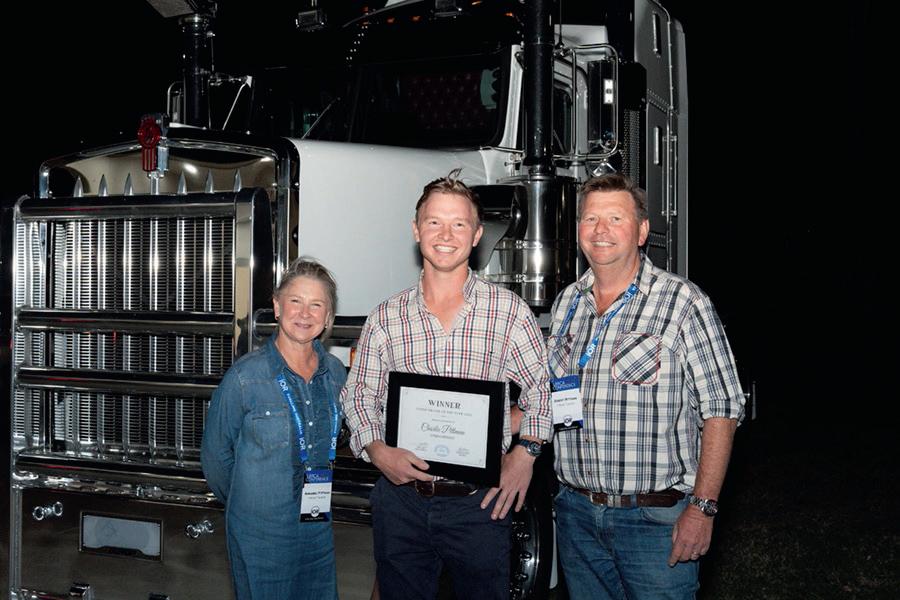
can be your own boss behind the wheel, and the opportunity to travel is also quite attractive,” he says.
“In the last three years, I have travelled through most of NSW and as far as Far North Queensland and Tasmania.”
Award initiator Lynley Miners congratulated Charlie on his outstanding best practice approach and commitment to driving and safety.
displays an exemplary work ethic, a proactive approach to safe work practices, and is a brilliant role model for the rural transport industry.
“The professionalism and leadership qualities Charlie possesses are a real win for our industry.
“He is hungry to learn and absorb every detail of the industry to be the best at what he does.”
HYUNDAI AND IVECO JOIN FORCES
A supply agreement has been reached between two major vehicle manufacturers as Hyundai and Iveco join forces. An Iveco-badged all-electric light commercial vehicle will become available in Europe, based on Hyundai’s eLCV.
The new vehicle will join Iveco Group’s electric light commercial vehicle lineup, enhancing its LCV portfolio alongside the widely sold Iveco Daily.
There was an agreement ceremony, held at Hyundai’s Seoul headquarters, which was attended by Jaehoon Chang, President and CEO of Hyundai Motor Company, Ken Ramírez, Executive Vice President and Head of Global Commercial Vehicle & Hydrogen Business at Hyundai Motor Company, Gerrit Marx, CEO
of Iveco Group, and Luca Sra, President, Truck Business Unit, Iveco Group.
Luca Sra says that the agreement is an exciting move for both companies.
“The unique partnership between Iveco Group and Hyundai Motor Company is making another significant step forward,” he says.
“The introduction of this new all-electric vehicle is particularly exciting for the European market, where urban and suburban distribution and delivery are crucial missions for logistics operators.
“We are confident that this agreement will not only strengthen our product offering but will also deepen our relationship with Hyundai, paving the way for continued collaborative projects that advance a more sustainable society.”
Hyundai and Iveco have been working in partnership since 2022, in which time they have developed and distributed a number of hydrogen-powered vehicles. This included the co-development of the eDaily FCEV and the launch of the E-Way FCEV city bus.
Under the partnership, Hyundai will manufacture and supply the Iveco-badged chassis cab for the European market and Iveco Group will locally customise and distribute the complete vehicles exclusively through its sales channels.
Iveco Group’s new product based on Hyundai’s Global eLCV platform will have its launch at this year’s IAA Transportation 2024, planned to be held from September 16–22, 2024, in Hannover, Germany.
11 www.powertorque.com.au NEWS & VIEWS
IMAGE: LBRCA
MITSUBISHI FUSO
LAUNCHES LIGHT-DUTY CANTER MODEL
The Japanese market has a new truck to look forward to, with the release of the light-duty Canter. It is the diesel model of the popular current eCanter model, which has enjoyed strong sales in the past year.
The new Canter will be available through MFTBC dealers and regional sales centres across Japan starting in February.
Mitsubishi Fuso says the new Canter model includes a redesigned interior for the first time in 14 years, with new design and functionality including a new dashboard and exit grips.
There is also a new 10-inch LCD panel, easy-to-use steering wheel switches, and a centre display that allows for operation of both navigation and radio via touch panel.
This Canter model also includes Fuso’s Active Sideguard Assist to help prevent collisions with pedestrians and cyclists, Active Brake Assist 5 and Active Attention Assist.
Its specs are as follows:
• Engine: 4P10+ 96kW(130PS)
• Transmission: 6-speed Duonic 2.0
• Standard Cab
• Wooden standard body
• All low floor
NEW CO2 FLEET EMISSION STANDARDS FOR EUROPEAN TRUCKS
Members of the European Union have reached an agreement on new CO2 fleet emission standards for trucks and buses across Europe.
These new standards will set figures for the allowable future emissions of CO2 from heavy vehicles. Emissions from trucks over 7.5 tons are required to be reduced by 45 per cent by 2030 – an ambitious goal.
Continuing into the coming decades, these emissions will then need to drop by 65 per cent by 2035, and 90 per cent by 2040 compared to a 2019 baseline.
Any trucks powered exclusively by e-fuels – be they electric or hydrogen – will be granted indefinite approval from the emissions requirements.
After EU state negotiators agreed in January that stricter emissions requirements would be necessary, this measure aims to provide legal certainty for both vehicle manufacturers and alternative fuel providers.
Currently, there are an estimated 921 hydrogen fuelling stations operating worldwide, with 37 new stations opening in Europe in 2023. This makes for a total of 265 stations across the continent, with Germany leading the way with 105.
According to H2stations.org, 92 per cent of the stations built

across the last 12 months in Europe are able to refuel heavy vehicles, making hydrogen trucking significantly more viable internationally.
Across the rest of the world, an additional 12 stations opened in Japan in 2023, 29 in South Korea, and seven in North America.
Australia’s first hydrogen refuelling station for trucks – located in Port Kembla in Wollongong, NSW – opened in July 2023, putting Australia on the map.
Most of the new hydrogen stations in Europe are designed to fuel heavy-duty vehicles, reflecting a shift in focus from fuel cell passenger cars to commercial vehicles, according to H2stations. Germany is also upgrading existing stations to serve heavyduty vehicles. Internationally, East Asia and the US are leading in the number of hydrogen fuelling stations.
ON BOARD ON SITE ON DEMAND


NEWS & VIEWS
LEFT HAND PAGE
IMAGE: AA+W/STOCK.ADOBE.COM
ALLISON EXPANDS SERVICE NETWORK
Global manufacturer of automatic transmissions systems Allison says its service network is continuing to expand as its list of customers continues to grow.
Australia is a major market for Allison. Its three local distribution and service partners include the likes of Heavy Automatics, Penske Australia and Transdiesel.
“While our distribution partners are increasing their service capabilities to support the growing number of Allison-equipped vehicles in Australia, our customers will continue to see value over the lifetime of their vehicles as Allison transmissions are more cost-effective due to lower maintenance,” said Robert Cavagnino, Head of Australia Sales at Allison Transmission.
“We design and manufacture a quality product and work very closely with our customers to be able to articulate what is needed for the harsh Australian environment, aiding resilient vehicles to overcome myriad challenges.”
Heavy Automatics, which has more than 100 Allison-trained staff working across Australia, recently opened a new 1,500 square metre service centre in Wacol, Queensland in June. Located within close proximity to vehicle equipment manufacturers, this presents even further expansion opportunities.
Penske Australia also opened a new site near the Gold Coast in September, while Transdiesel has also settled into its new flagship servicing centre, a 5500 square-metre facility in Epping, Victoria.
“Allison Automatics allow fleets to have drivers with varying levels of experience and with the drivetrain doing the work there’s less fatigue for the driver and more precise operation ability. This allows drivers to focus of the task at hand,” Robert said
“Allison’s superior performance encompasses startability, gradeability and steady acceleration, covering duty- cycles at higher average speeds.”
FUEL DELIVERY DRIVER LEADING THE WAY FOR INTERNATIONAL WOMEN’S DAY
Lowes Petroleum’s Alicia Waddingham may not be the typical image of a truckie – a 33-year-old single mother – but she’s breaking down walls and living her dream in the transport industry.
She’s been a driver for Lowes for a year now, making fuel deliveries anywhere within 100km of the depot. Having driven trucks for 13 years, Alicia says it’s like no other job in the world.
“What I like best about being behind the wheel is the freedom,” she says.
“Being out on the road and very much in control of my own day, listening to my own music. It’s like my own personal little office but on wheels – a moving office.
“Driving trucks is really like nothing else. It’s such a great job, because you’re not going to work and sitting in an office that doesn’t change. Even if you are seeing the same landscape every day it’s still somewhat different.”
Being a single mother has its challenges, but Alicia says Lowes has been very understanding and flexible with her hours.
She’s behind the wheel three days a week, and has the freedom to get home every night to her young daughter, which she says makes the job suit her life well.
“Clara is five years old, so it’s important I have a work life balance,” Alicia says.
“The hardest thing for any single mum is having a job and a child and trying to juggle the two. My knock off time can be anywhere from 2pm or 5pm so it’s very manageable and that my schedule allows me to be home every night is amazing.
“I am seeing more women drivers on the road these days as well as driving headers on the farms, so the word is getting out that this is a good career for women.”


NEWS & VIEWS
ALEMLUBE DIESEL FUEL
DISPENSING &
you
way. Available in capacities of 100L, 200L, 400L, 450L, 600L, 800L, 1,000L, 1,200L www.alemlube.com.au
STORAGE,
METERING KITSwith
all the

AND THE WINNER IS…
The winner of the Truck of the Year Australia was announced and presented at the Teletrac-Navman Technical Maintenance and Safety Conference, recently, on March 13 2024 in Christchurch, New Zealand.
Truck of the Year Australasia (ToYA) is judged by a jury consisting of the PowerTorque Editor, Tim Giles, New Zealand Trucking Media Editorial Director, Dave McCoid, FOCUS on Transport & Logistics Editorial Director, Charleen Clarke, long-time Australian trucking industry stalwart, Bob Woodward (who recently retired as the Australian Trucking Association’sChief Engineer), and Randolph Covich, Publisher of Deals on Wheels (New Zealand).
The new Western Star was in competition with two other contenders, in the form of the Volvo F-Series Electric and Scania’s Super Series. Any truck receiving a nomination as a ToYA candidate is being recognised for its
contribution to the standards of safety and efficiency of transport of goods by road in Australasia.
“I am thrilled to receive the 2024 Truck of the Year Australasia award on behalf of our Australia and New Zealand Western Star teams,” said Christie-Johnston. “Since we launched the all-new X-Series in late 2022, we’ve received outstanding feedback from everyone who has driven the trucks. From customers to media personnel, the response has been unanimous that the X-Series is a seriously premium package.”
Tim Giles talked about the way all the contenders brought major strengths to the competition. He ran through their strengths and the reasons for them being included in the short list.
“When it comes to pure engineering, the way Scania took what was an excellent and a frugal driveline and redesigned all of the components, taking them to another level, is very impressive. Volvo needed an electric alternative in the prime mover department, and came up with a solution which turned a good to drive, well-designed truck into a good to drive, well-designed truck that also achieves zero emissions,” said Tim at the TMS event.
“In the new X Series from Western Star, we see a completely different truck from its predecessor; the design brings the Western Star brand bang up to date. The X Series includes all of the latest goodies like the Detroit DT12 AMT, which has performed well from
14 TRUCK OF THE YEAR AUSTRALASIA
POWERTORQUE May/June 2024

the word go. For the traditionalist, there is still a Roadranger available, just to reassure us that the dying art of the truck driver is still with us.”
Looking into the Australasian truck market from a overseas perspective, Charleen admitted that this year’s competition was particularly challenging to judge. She was unable to attend the presentation, but sent her comments online.
“All three contenders are superb trucks,” said Charleen. “On the one hand, there was the Scania Super, a brilliant truck that proves the potential for the internal combustion engine. It does everything exceptionally well, but the potential for fuel savings is hugely appealing. This would definitely resonate with each and every transport operator.
“Then there was the Volvo. The company has done an astounding job of bringing e-mobility to truckers around the world. The FH is sublime in
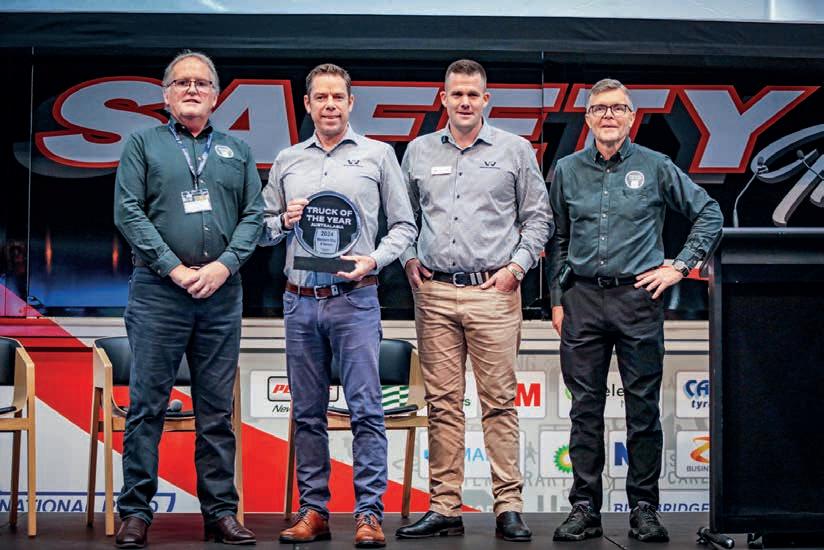
that a driver can just hop into it, drive the truck, and save the planet at the same time (yes, I know that’s a slight exaggeration).
“Finally, there was the Western Star X-Series. With its powerful driveline, better-than-ever safety features, comfortable and ergonomic cab, we all knew that the X-Series had to be in with a shot. The X-Series got the nod from me because it’s a huge leap forward for the brand. It’s
also probably the ultimate truck for Australasian transport operators, and it can be rolled out right now.”
Competition host for 2024, Dave McCoid felt the competition was really interesting this year, and had given the jury some difficult decisions to make, due to the fact that each truck was innovative in a different way.
“After a couple of difficult rounds of discussion all five of us involved in the selection process were unanimous the
15 www.powertorque.com.au
AUSTRALASIA
TRUCK OF THE YEAR
IMAGE: WESTERN STAR TRUCKS
L to R, Dave McCoid, Hamish Christie Johnston, Kurt Dein and Tim Giles.
IMAGE: NZ TRUCKING
TRUCK OF THE YEAR AUSTRALASIA
Western Star X-Series was this year’s winner,” said Dave. “The X-Series circumvents several steps in what would normally be the evolutionary path for a truck at the stage the previous model was at, but being able to tap into the Daimler Truck North America platform has catapulted the X-Series to the pointy end of the market.
“The result not only increases choice in the marketplace for those whose customers have stringent safety requirements, but also raises the industry sector bar for the average level of capability. It also extends the challenge to competitors whose premium bonneted products might not match the X-Series in some core capabilities. In terms of the New Zealand market, offering an 8x4 and the 450kW engine hits the nail on the head.
“And lastly, there’s also that
are, being proud and honouring it, and knowing there’s still an active market. Yes, I’m talking gauges, gear levers, and grain on the dash. The sun is most definitely setting on that era in the industry, but not just yet, if that’s what you want in your big, new, shiny Star. This is a well thought through marketwide offering.”
THE WINNER
For a fuller profile of the winning truck range, see the following article on page 18.
THE RUNNERS UP VOLVO F SERIES ELECTRIC
When looking at the contenders for the Truck of the Year Australasia, it was important to look at some of the new technologies coming through and see if there are any, which have reached the point where they look like they are going to be effective and have arrived
With the launch of the Volvo, heavy duty electric truck range late in 2023, the Australasian transport industry could see a viable alternative option on a model which is already one of the top selling trucks. The Volvo heavy duty range has been effective and grown in Australasian markets, now the company is offering a zero carbon emissions alternative to the current diesel range.
Two members of the ToYA jury, Tim Giles and Dave McCoid, got a chance to test drive a Volvo FH Electric at the end of 2023. This is a fully electric truck and one which will effectively change the emissions effect of the freight task, but it is an interim technology. This is not going to be the final product which Volvo will be offering to the market in the long-term as a zero carbon emissions alternative.
This first iteration of the Volvo heavy duty electric truck is a relatively small



16 POWERTORQUE May/June 2024
Kurt Dein, Head of Western Star Trucks
IMAGE: NZ TRUCKING



No offer of shares in Capricorn Society Limited (ACN 008 347 313) is made in this promotion. ALL THE PARTS YOU NEED IN THE ONE PLACE.
Generous
Find out more about the benefits of belonging to Australia’s largest coop for automotive.
One trade account Quick access to parts & services
Rewards Program No joining fee At Capricorn, we’ve done the hard work for you. With one consolidated trading account across thousands of suppliers, we’ve got all the parts and services you need to run a successful heavy vehicle business. It takes the hassle out of managing multiple payments – plus you’ll earn Capricorn Rewards Points for every dollar you spend, putting cash in your back pocket.
TRUCK OF THE YEAR AUSTRALASIA
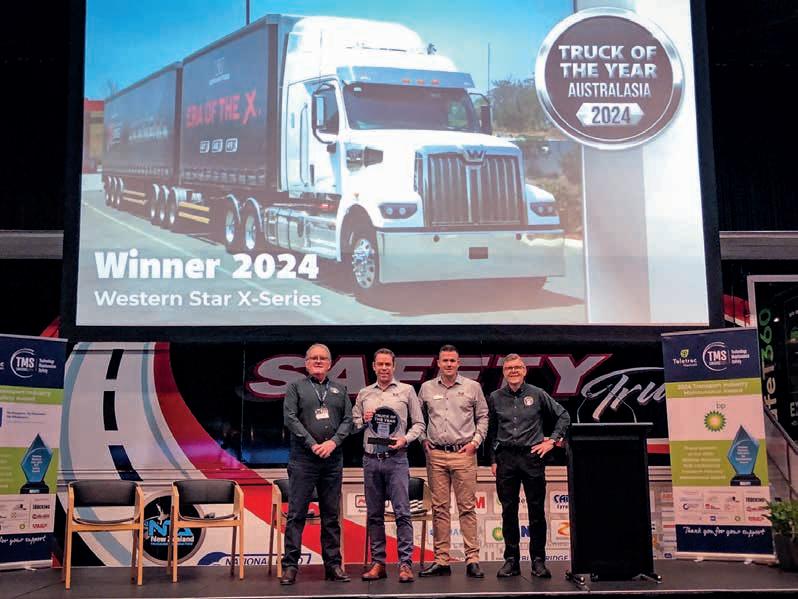
put, the Volvo engineers have looked at the current diesel Volvo FH, and removed the engine and associated accessories, then replaced them with all of the equipment required to create an electric driveline.
Having driven quite a few electric trucks in test drives in the last couple of years, it has become clear that one of the differentiating elements between trucks, is the way that the software and computers on board control the application of power through the driveline. Without this control the acceleration can be too quick and the driver’s head will smack into the headrest of the driver’s seat.
This system shows its quality in the fact that pressing the accelerator, simply enables the vehicle to move off in a controlled manner, gradually picking up speed until reaching the desired velocity. This truck moves with the smoothness and effortlessness we have come to associate with Volvo in recent years..However, the electric version of the FH does take this to another level.
SCANIA SUPER
In a truck test drive, PowerTorque took two Scania Super models out for a quick run. There was a Scania 460P Super pulling a single trailer and a Scania 560R Super pulling a fully loaded B-double set.
The return of the Super name is
a logical choice, it has been used historically by the brand when new engines were introduced and was often written somewhere on the front of the truck, in the past. The 13 litre engine in the two trucks tested is an all-new engine for Scania. This test drive included the 460hp version and the 560hp version, which taking the 13 litre into unknown territory.
There’s no EGR, but a two-stage SCR, the main dose is injected just after the turbocharger exhaust outlet near the exhaust brake flap where the exhaust gas is hot and turbulent. This better atomises the AdBlue for a more efficient clean up of NOx.
High compression engines tend towards higher ignition temperatures, in cylinder, leading to higher NOx

the point at which the power curve flattens out before rising slowly to maximum power between 1700 and 1800rpm.
On the 560hp version of this engine the torque maxes out at 2800Nm (2065ft lb) which is up there, in terms of torque, with many of the 15 and 16 litre engine available.
In a change which took many by surprise Scania have broken with a very long tradition and developed an AMT without any synchros. Opticruise has been though many iterations, always with synchros, but this new box is a revolutionary and not evolutionary step-up.
As part of the fuel saving design the AMT will only go up to 12th


18 POWERTORQUE May/June 2024
L to R, Dave McCoid, Hamish Christie Johnston, Kurt Dein and Tim Giles.
IMAGE: NZ TRUCKING
IMAGE: NZ TRUCKING
IMAGE: WESTERN STAR TRUCKS

A CLOSER LOOK AT THE TOYA WINNER
Launching a new truck range for a brand like the Western Star X Series can be a tricky task. Any renewal has to balance the need to retain the traditional strengths of a good-looking dependable robust truck, with the requirements to include all of the latest technology, in terms of driveline, electronics and comfort. This can be achieved by getting the small details right as well as the headline items. PowerTorque looks at the fine detail put into the Truck of the Year Australasia’s design and runs through the features drivers will notice.

There are a number of changes in the X Series that are unique to the Western Star brand in the Australian market. The truck which emphasises this point the best is the 48X a truck, which doesn’t exist anywhere else in that world.

When it comes to the 49X, it’s got the power hood, a larger bonnet with more internal volume than anything used in the US. The design includes a lot of features and improvements underneath which are needed for our higher temperatures and increased GCM which 49X will run at here in Australia, plus coping with the rougher roads.

20 TOYA WINNER
POWERTORQUE May/June 2024
IMAGES: WESTERN STAR TRUCKS

The bonnet is now made from a moulded resin instead of the previous fibreglass design. This makes it more flexible, and is claimed to be more durable and impact resistant than the previous model.

As a power plant, there’s the Detroit DD engine range, coupled with a choice of Allison auto, Eaton Roadranger and the Detroit DT12 AMT. The truck is a completely 12-volt system, as you would expect from a North American truck.
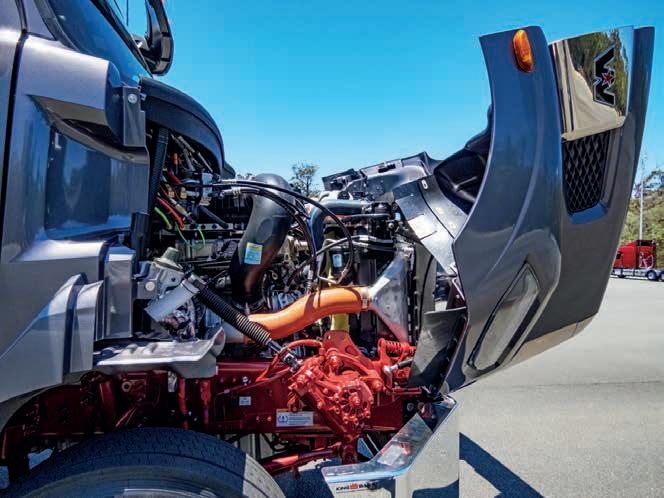

The larger cabins now available have come from the Daimler (Freightliner) catalogue, but when fitted, to retain durability, there are steel crossbeams fitted to maintain rigidity. These are exclusive to Western Star.
Climbing up into the new cabin the first thing you notice is the ’70 degree ingress’ which describes the way the aluminium steps are set back so that it’s not a vertical climb up into the cabin, it’s more like a set of stairs. There are five points of contact when you’re getting into the truck.

Of course, it would not be a new modern truck without the full multifunction steering wheel, with which we are becoming more and more familiar.

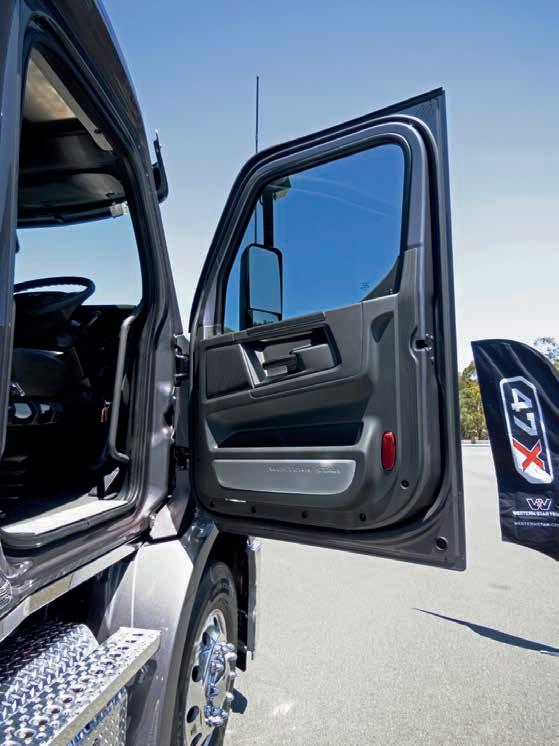

21 www.powertorque.com.au
TOYA WINNER
Looking at the dash it is a well laid out, but a standard looking array. To the driver’s left, on the binnacle, there are dials, radio and aircon controls. One step to the right is the customisable area. This is where operators can put any sets of controls they want or leave it blank. This will be the home of the screen for the entertainment system which will follow later.

SMOOTH RIDE IN THE CITY
This first test drive of the second generation Fuso eCanter demonstrates how city delivery in the latest electric truck is going to give the driver a smooth ride in the city.
22 TRUCKS ON TEST
POWERTORQUE May/June 2024 IMAGES:
DAIMLER TRUCKS

Driving and then running a Fuso eCanter will be many truck operators first contact with electric truck technology. Running a truck powered by batteries and being charged, either en route, or back at the depot, plus the importance of cooling systems, modularity, and weight distribution.
The development of this next generation of electric vehicles from Fuso, has taken key learnings from the earlier generations, and this is the third iteration of the eCanter which PowerTorque has had a chance to drive, and the major steps forward at each step are very clear.
The first prototype we saw was a novelty, but a bit rough when it came to accelerating. The progress made on the first eCanter to be sold here, three years ago, was striking, with the computer controlling the application of power through the drivetrain to such degree that driving it felt smooth. This was Australia’s first taste of an electric truck from a major manufacturer and there are now around 50 on Australian roads
The arrival of the second eCanter may not be so strikingly different, but it does demonstrate a genuine level of sophistication in electric truck design. The addition of the eAxle means this is the finished article, with the emphasis now on improving the communication and integration between the batteries, electric motor and final drive. On the evidence of this test drive, the engineers have done an excellent job. As the cost calculations change over time, we can expect to see many more appearing on our roads in the next few years.
Advanced safety features in these new truck models includes side guard assist with active braking, stopping the vehicle to prevent accidents with people, vehicles or objects on the nearside of the truck.
Operators do now understand the need for advanced systems to stop vehicles in emergency situations. Concerns about the reliability of these systems, potential benefits. the effectiveness of audible warning systems and the challenges of
norm in our fleets.
“All of our experience with the first generation eCanter, with the first generation OEM electric vehicle (EV) into the market has informed this new eCanter,” said Romesh Rodrigo, Head of Vehicle Homologation, Regulatory Affairs and Future Mobility at Daimler Truck Australia Pacific. “It was also very evident about its first mover advantage, and the fact that we only offered it in one variant shows how much effort went into the vehicle itself. The first generation units have clocked up over 8 million km, globally. There’s a lot of key learnings come out of that and fed into the next generation eCanter.”
“It’s been really interesting hearing the feedback around the applications where they have targeted, saying, this is where it’s at, this is what does the job and some of them have had carved out a special job for it.
“The good thing about eCanter having been introduced into our market for a period of time is the fact that our dealers have had experience

23 www.powertorque.com.au
TEST
TRUCKS ON
TRUCKS ON TEST

comes in, it’s not going to be foreign to the network.”
Fuso has confirmed the next generation all-electric eCanter will be launched in Australia this May with a full model line-up consisting of 14 variants.
SPECIFYING AN ECANTER
The basic specifications of the eCanters includes all of those, outside of the driveline, offered in the existing fossil fuel vehicles that are on the market. Nothing has been subtracted from the specification purely because it is a different powertrain.
The payload available on the eCanter varies from 500kg with one battery on the lightest truck up to a 4.5 tonne GVM with a body where the payload is around 600-700kg. When you go up to six tonne GVM, there’s a payload of around 2.5 tonnes. Each battery weighs roughly 500kg, so moving from two to three batteries will reduce payload by around 500kg.
The other side of a payload calculation is the fact that the range is changing as you add each battery (there’s a choice between one and three). Each extra battery will increase range by, at least, 100km. As a rough rule of thumb one battery limits range to just over 100km, with two batteries that’s 200km and with three, 300km.
The caveat here is, of course, driving style. A smooth and frugal driver will get much further and someone who goes hard and is constantly on and off the brakes, is going to get no more than the projected range.
Fuso expect the eCanter sweet spot will be around the six tonne GVM model, which offers enough payload to make it more viable and also offers
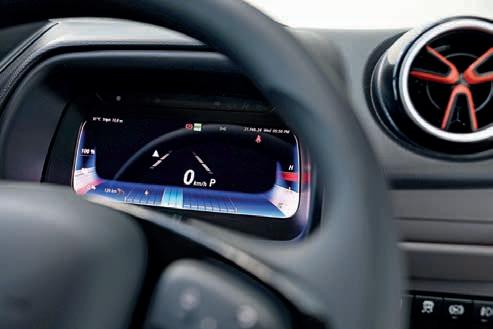
the choices around batteries. An operator can choose to go with one battery and get more payload, if they concentrate on city centre deliveries and only need 100km plus range.
If they want more range the second battery doubles that range, but knocks off 500 kg of payload and a third battery gets a much better range but further compromises payload. You pays your money and takes your choice.
The big ticket item in the move to this second generation of eCanter is the inclusion in the design of the eAxle concept. This is a technology which makes logical sense and we can expect it to roll out across all truck designs into the future. However, currently Fuso and Mercedes Benz are the only brands offering this kind of technology in Australia. The eAxle is, of course, heavier than a conventional differential, but does allow for more flexible weight distribution towards the front of the vehicle.
Because this removes the need for a drive shaft from the motor/engine under the cab, chassis real estate becomes available allowing the batteries to be mounted well within the perimeter of the vehicle. This mitigates the safety scenario where there is a danger of a battery cell being ruptured in a side-on collision, and a risk of fire. The extra space available on the chassis is also going to give bodybuilders more room to bring a design down beneath the main body level if required.
The eCanter is fitted with thermally controlled battery packs, with cooling liquid lines in the battery pack itself, integral in the structure of the battery packs.
One of those topics which will
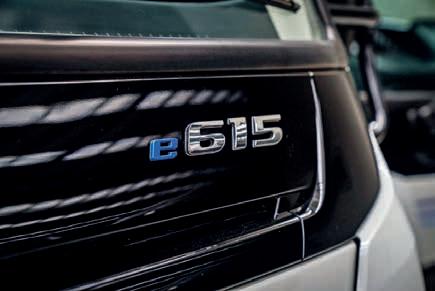
be front of mind will be the safety features of a new vehicle, and battery safety and their protection from impact and fire will be high on the agenda. Around the batteries are mounted deceleration sensors, which will detect any side impact and immediately kill the high voltage system, reducing the risk of fire.
In terms of charging, Fuso covers all of the bases, it can use both AC charging, from a three phase socket and DC charging, which is much quicker, but requires the right electric infrastructure on site. This means that it can be used in a back-to-base scenario and charge up overnight on AC, which is generally available. However, when working in a more time pressured task it can use DC charging, which would enable a truck to work shifts, but comes with expensive infrastructure.
These new eCanter models have independent front suspension(IFS) on both narrow cab and wide cab, but not on the heavier 7.5 and 8.5 tonne GVM models. These revert to the typical Fuso beam front axle. Driving the eCanter on some the the wonderful(?) Melbourne roads sees the IFS smooth out the worst of the bumps and adds to the serenity in a cab, which is already eerily quiet.
“What this new design has given us the ability to do, is offer 14 variants of the eCanter, and a lot of it comes down to this modularity,” says Romesh “Going all the way from four and a half ton from a single battery. You can run a dual battery at 4.5 tonne, but payload starts to come down. This is obviously a challenging segment, for, these trucks in general, all the way up to eight tonne.
“With all of these you have the ePTO option, which can be either
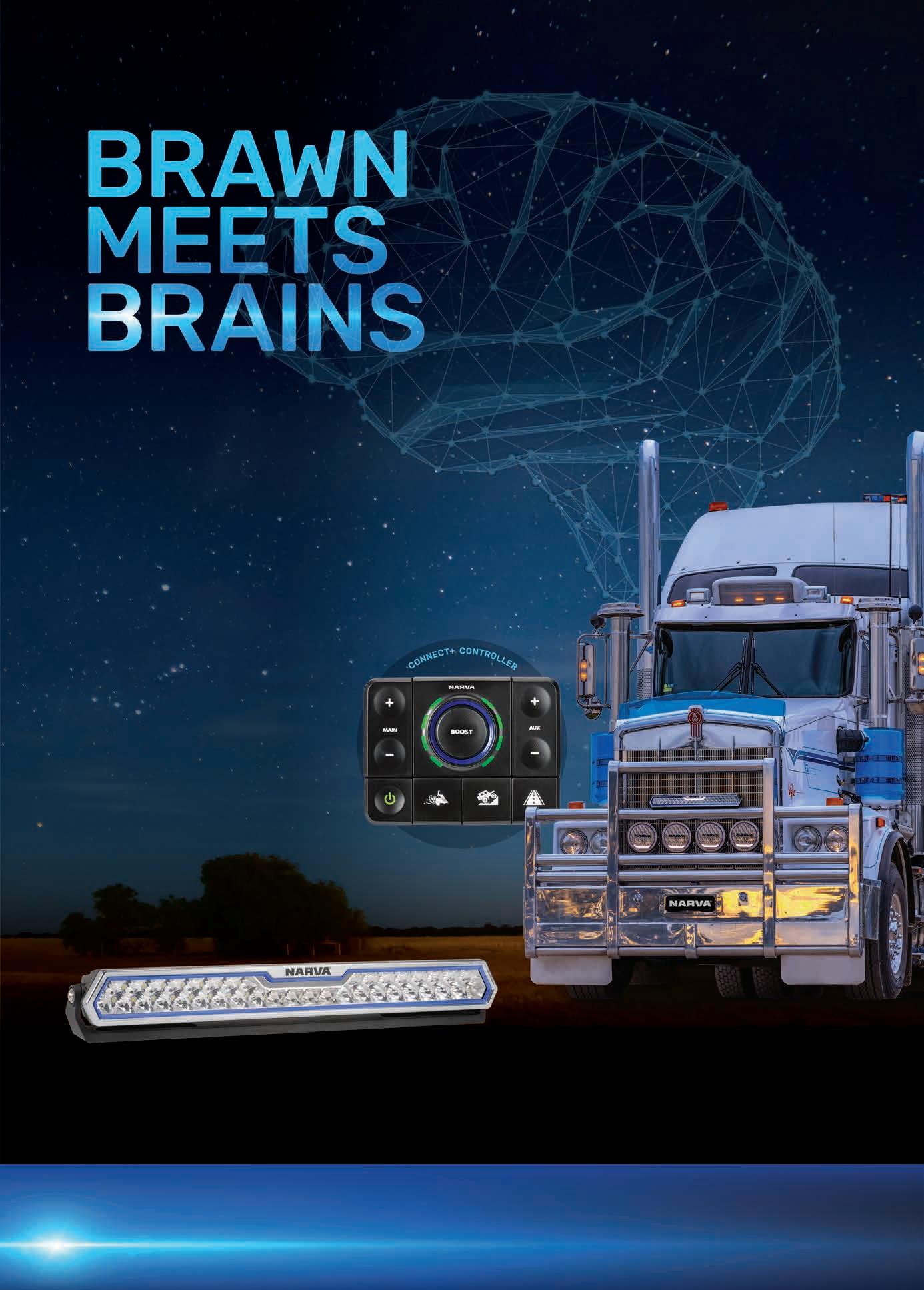
24 POWERTORQUE May/June 2024
Superior construction and performance; now with intelligent control.
Unlock your Ultima light bar’s full potential with a revolutionary new Ultima Connect+ Controller.* Featuring 3 customisable driving modes, boost mode and the ability to connect multiple lights, Connect+ gives you total beam control.
Ultima High Performance Light Bars are the first in Narva’s innovative Ultima Connect+ range.
BRAWN: Ultima Light Bars
• Market-leading beam performance
• 2 beam pattern options available
• Unprecedented 10-year warranty
BRAINS: Connect+ Controller
• Adjustable brightness
• Boost mode – 15% more power for 30 seconds
• Single unit to control all Connect+ enabled products




ULTRA-WIDE FLOOD BEAM PATTERN LONG & WIDE HYBRID BEAM PATTERN YEAR WARRANTY CONNECT+ IP68 IP69K CUSTOM TRIMS SCAN TO SEE THEM IN ACTION narva.com.au/Ultima
*Sold separately
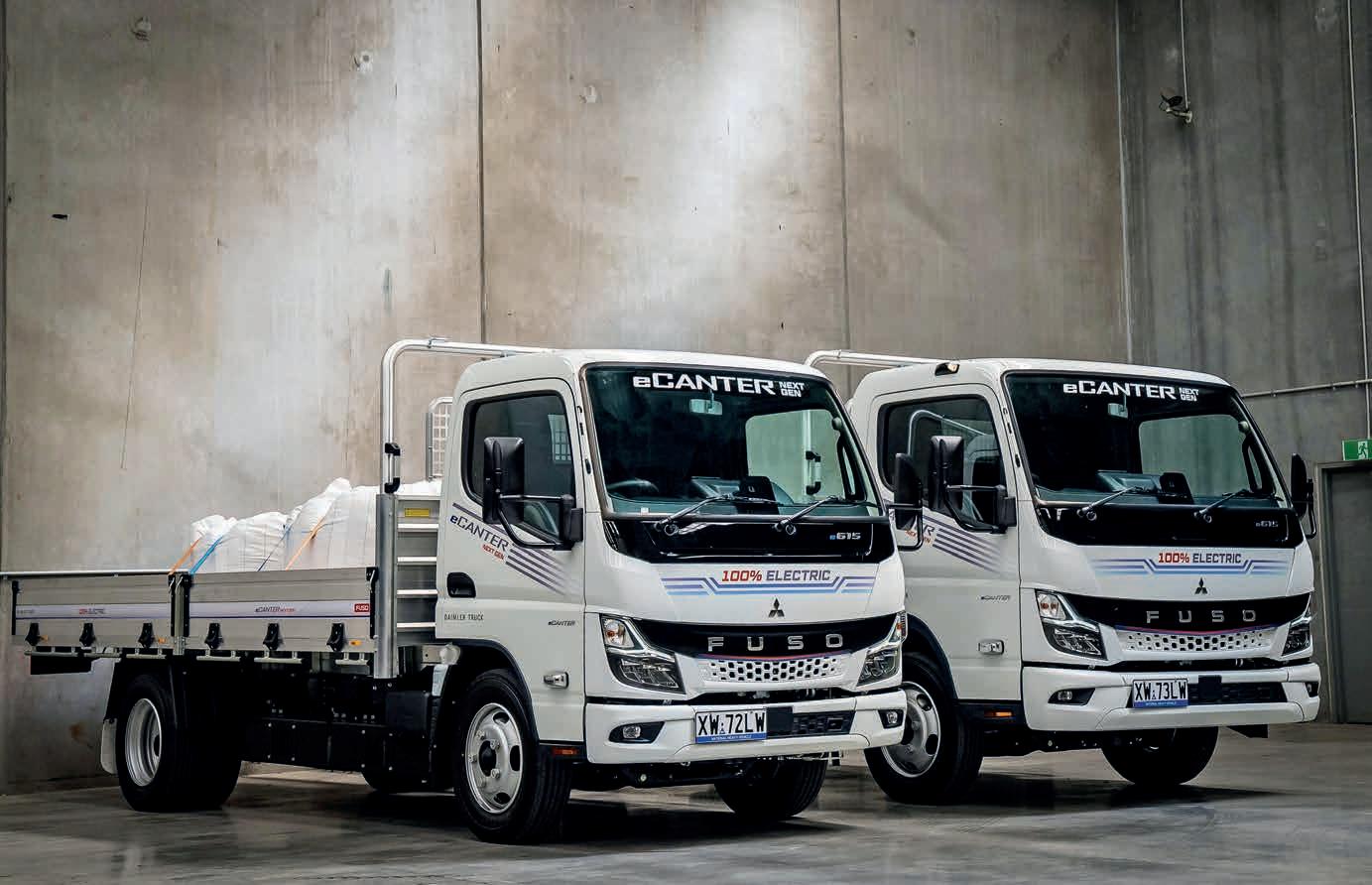
a pulley drive, which is not a super high torque output more for refrigeration compressors, and then you also have direct close coupled which obviously increases the capacity a lot.”
ON THE ROAD
PowerTorque took both of the models available for testing for a drive of around 50 plus km route in and around the city in Melbourne, on roads which will probably be the kind of workplace these trucks will be handling day-in day-out when they
Sat in the driver’s seat, the driver does feel relaxed, due to low noise levels and the access to really powerful torque, under the right foot. This feel of the truck and the way it seamlessly accelerates when needed, will probably aid drivers in adopting a more relaxed style, and then be better able to get more range.
The design refresh retains a walk through cabin, the eCanter and Canter share a cabin design, so there is still the dash mounted gearstick for the diesel powered version. However, on the eCanter, that control
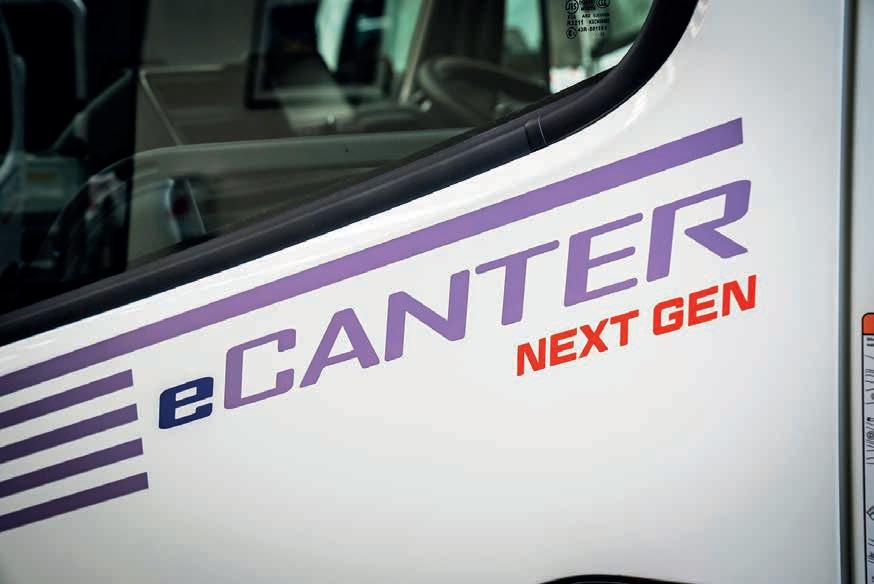
option. Position three regenerates the most and works very much like an engine brake or retarder on large diesels, it brings the truck up quite quickly.
The new generation eCanter comes with an active safety package, here we see the full Daimler safety suite included in one of the smaller members of the company’s wide ranges of trucks. Here is all of the fruit which is becoming common currency at the top end of truck ranges, but now available here on a truck you can drive with a car license.
There are cameras and radar enabling the automatic emergency braking with which truck owners are now becoming familiar. Out on the highway, the adaptive cruise control, which also relies on this system makes life easier for the driver to let the automated system navigate the stop-go traffic of suburban Melbourne.
The eCanter does also include, for the first time on any Canter, side guard assist, which is offered higher up in the weight range by Fuso and displays a tell-tale red triangle on the A pillar on the passenger side, if there is a vehicle in the blind spot. The system will actively intervene and actually stop the truck, if it

TRUCKS ON TEST




















































TRUCKS ON TEST
detects a major problem. It goes through iterations of warning before braking.
Again, the fact that the driver doesn’t have to concentrate hard on the stopping and going from traffic to traffic light, adds to the serenity induced by the relative silence in cab. The combination of low noise levels from the driveline, smooth acceleration and deceleration modulated by automatic systems, and the smooth ride from the IFS, makes running on these bustling road a much more relaxing and comfortable experience than it is for many drivers fighting with a manual gearbox and a diesel engine while travelling these same routes.
This next generation of the eCanter and new Canters includes an improved interior feature like Apple CarPlay, which is accessible on the central display.
The overall experience from behind the wheel is a relaxed one. The peaceful nature of the driving
is added to by the smart way the different aspect of the driving experience are integrated.
The calm way the truck goes about its work, while, at the same time getting the job gets done quickly, safely and efficiently adds to this impression. The various instruments and screens tell the driver what is going on and the quietness of the cab also means the instructions from Google maps don’t get lost in a gear change.
All of the controls become second nature once the driver works out how each of them functions. The only one which could be improved is the lever for activating and setting the regenerative braking levels. It is currently a repurposed gearstick on the dash, it would work much better as a button under the driver’s thumb on the steering wheel.

and less carbon emissions, at the same time as being a pleasant and relatively peaceful drive.
Outside of that minor criticism there is little to fault in the truck. We have seen the Canter develop over time to a solid performer.
This is the first entrant from a major truck manufacturer into the light duty zero emission market in Australia and it will set the benchmark which others will have to, at least, match going forward. It will come at a premium price, but we can be sure that this
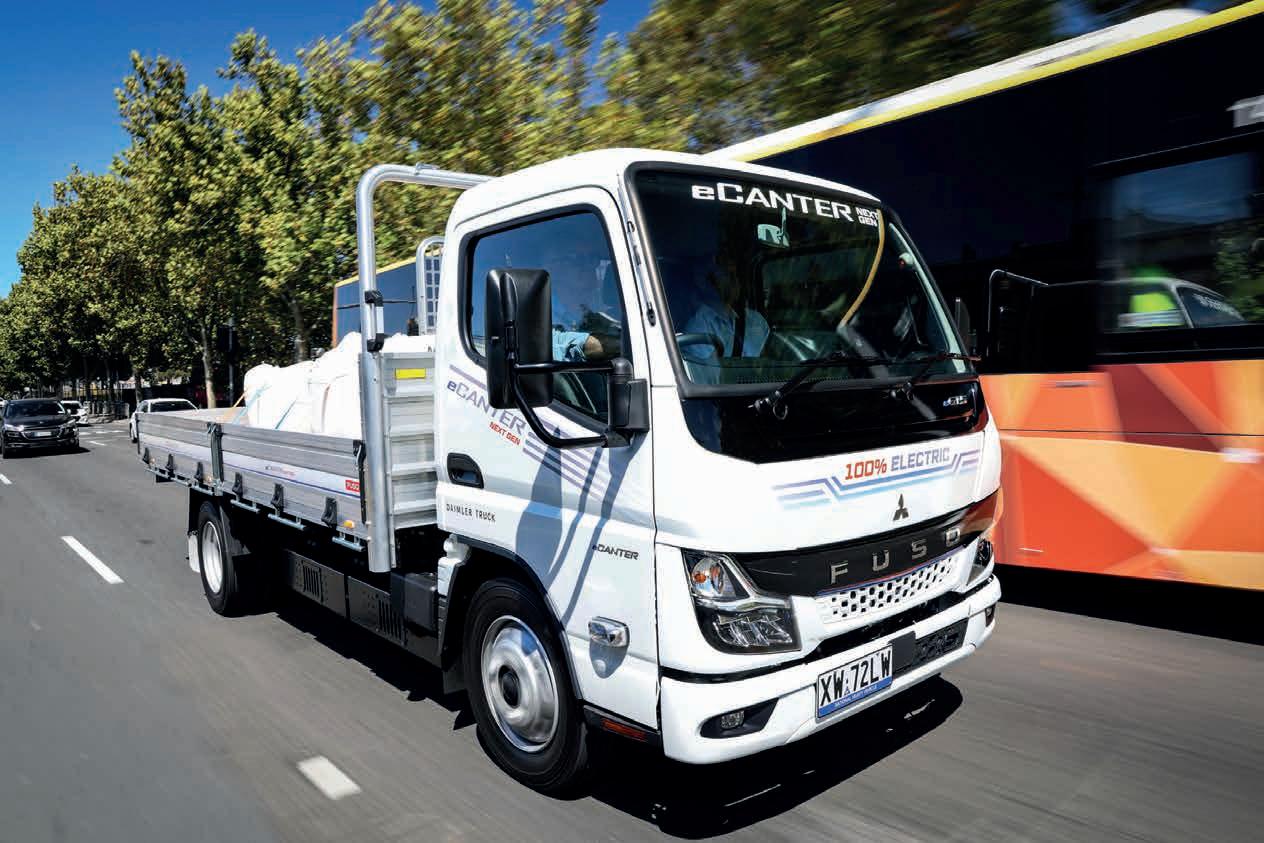

28 POWERTORQUE May/June 2024 C M Y


THE ECONOMICS OF TRUCKING’S CARBON ZERO
Looking at the realities which will face transport operations as they migrate across from fossil fuel dependency to the zero carbon economy, one of experts in the field examines some possible scenarios.
Australian trucking operators are currently in various stages of decarbonising their businesses. Some are a taking the first few steps on the road to zero carbon, while others are looking at the options for the future, then some will wait on the sidelines and see how the radical changes in the industry play out.
The Alternative Fuel Summit, organised by the Victorian Transport
Association, was aimed at informing operators and suppliers participating in the industry, helping them to make informed decisions on the next step for their business. The process of decarbonisation needs to clearly defined, in order to give the business owner confidence to be able to make the first steps on the road financially sustainable.
Professor Russell Thompson is
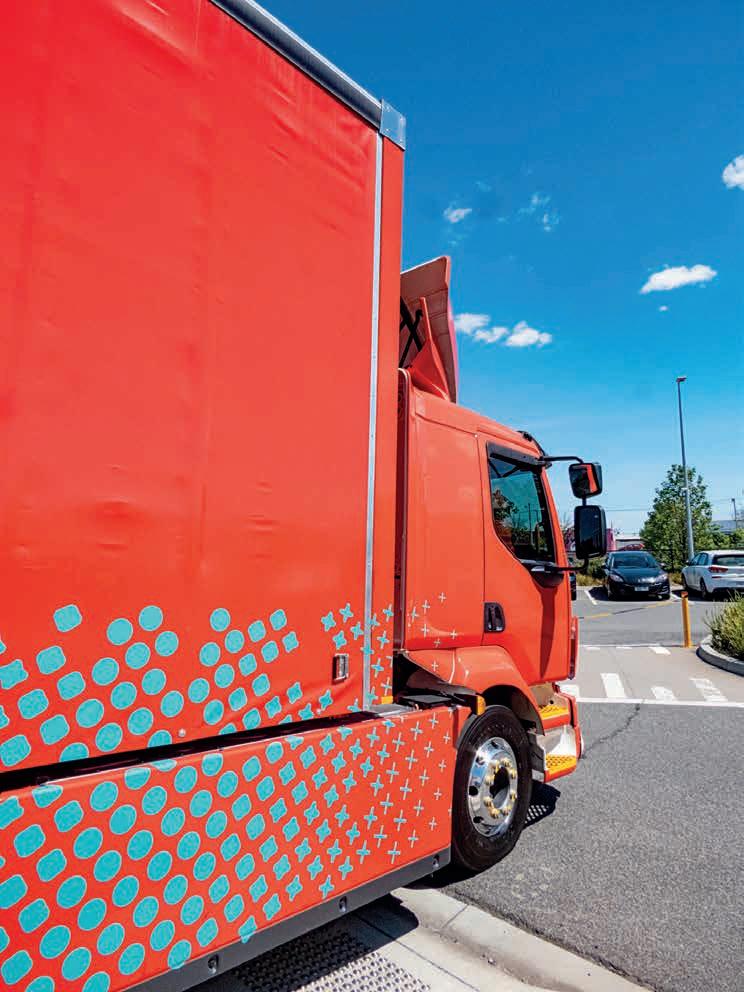
and Department of Infrastructure Engineering at the University of Melbourne. His main research areas are city logistics, physical internet, resilient transport systems and Intelligent Transport Systems.
“I’m trying to outline some areas where I think there’s some opportunities for some of the work, that I’ve been involved in, to assist the trucking industry,” said Russell. “How we make decisions is very important and there’s a lot of decisions made by an industry, associated with trying to decarbonise. It’s good to reflect on who are the decision makers because they’re very complex systems, we’re talking about here.
“There’s a lot of different types of decision makers. We’ve got businesses, families, government, but I want to talk about how we can use computers. Being able to exchange our knowledge and learn from each other is important.
“There’s a lot of interest in alternative fuels, technologies and engineering, but I’m going to talk about networks and how networks can play a very important role, in this transition to net zero emissions. We’ve got a very dynamic mix of technologies and a very fast changing environment, a lot of uncertainty in terms of the future, a lot of automation opportunities, but also a lot of computer technology and a shared economy.”
Russell done a lot of work in mathematical modelling about reducing total emissions. He has been working on a set of equations around emissions produced per vehicle kilometre. The distance the vehicles are travelling is a major influence on the total emissions.
His team has been studying networks and how they can be
30
ALT-POWER
POWERTORQUE May/June 2024
IMAGES: PRIME CREATIVE
Professor Russell Thompson, Professor of Transport Engineering and Department of Infrastructure Engineering at the University of Melbourne

transformed as part of the transition to net zero emissions. They have looked at the concept that it’s how far these vehicles are traveling and the nature of the networks that they’re operating on, which is important. Where the terminals are, where the warehouses are, where the customers are and where the demand is. He has also worked on utilisation of the vehicles, and thinks this is very important and can have a major role to play.
“I’ve only got one formula in this presentation, for the concept of network efficiency, tonne kilometres divided by the number of kilometres travelled,” said Russell. “Tonne kilometres represents demand, we move stuff and we move it over distances and this is not going to change. It’s actually increasing, we actually need more stuff and demand it should be transported. We get some scary predictions about how it’s going to grow dramatically and asking how
the industry is going to cope, and that’s the scary part.
“However, the denominator in terms of efficiency is the vehicle kilometres travelled, how far the vehicles are traveling to satisfy this demand. If we can start to think about our vehicles and their capacity, and how that capacity can be utilised more, and how these networks can be transformed, this provides a significant opportunity to lower our emissions.
“What we should think about is how we can deliver the same freight, but running over fewer kilometres. We can start thinking about how these networks are designed and configured and operated to reduce the amount of movement and the distances of overall travel. This is an important concept, I believe, and this introduces the physical internet.”
Russell has been involved in this area for over five years, and it’s an
emerging area of concepts, based on an analogy with the digital internet. He points out that we’re not worried about how the data is transmitted, and don’t care about where it goes, all we want is information that we can request quickly, fast and accurately.
This concept of a physical internet has been around for about 10 years, with the aim of trying emulate a lot of the characteristics of the digital internet in terms of the compatibility and integration into the physical world of road freight. Looking at the integration of the standards, to try and get that efficiency into the network. looking at open and shared networks, which are more collaboratively orientated.
“Things are going to have to be standardised because, there’s a lot more exchange and sharing of resources,” said Russell. “Compatibility of goods and load units are very important, and we’re
31 www.powertorque.com.au ALT-POWER

know where things are, and to know when things might be coming.
“This is a an advanced concept and an Australian company called GS1 Australia have developed some really good standards for allowing the information exchange necessary, for these exchanges and for this transparency to be implemented. We’re working with GS1, and they’ve really got some amazing standards to be able to track at low cost and to be able to share this information, to be able to get that confidence that the goods, when they are trans-shipped and are moving around with different vehicles, we know where they are and what’s going on.
“The concept of the physical internet is that we have got loads of different units and they need to be exchanged and transferred, so they need to be standard. We are moving to the concept of the right mode for the right load. The idea is to actually recognise that often this needs to involve multiple modes. We need to think about how much of this available capacity we’re using within our vehicles and the inevitability that we need to do this efficiently, revolves around exchanging our goods at hubs
about a large urban area where they are distributing to a number of retail outlets across a metropolitan area. The example had 48 delivery points in the area and, typically, these deliveries would come from a number of depots warehousing to service these outlets.
The routes are quite efficient, independently, in their own right. However a more collaborative network with a compatible, integrated shipping concept, with transfers occurring between warehouses, with each warehouse receiving goods and
all the collections back to the local warehouse and later transferring the freight to the other other hubs in a consolidated form.
This shared network works out to create a 78 per cent reduction, in terms of transport distance travelled. This is gained just through the collaborative system. There are no new vehicles, no new facilities, the wholesalers and distributors simply agree to share the workload and achieve a significant reduction of 78 per cent.
“This result is quite remarkable

32 POWERTORQUE May/June 2024
ALT-POWER
and and of course, the network efficiency gain is quite a lot higher,” said Russell. “This is very good news for trying to promote the collaborative network in terms of the scale. Those costs in terms of distance, translate to emissions, and financial cost savings as well. No new facilities, no new technology, no new vehicles.
“In logistics we’re quite often criticised because we want to build new terminals, we want to have more fancy trucks, but in this case, we improve by using existing networks, just with sharing and collaboration.
“Similarly, if we’ve got a lot of freight moving across between our production and warehousing areas, a lot of the trips are returning back to the depot or back to the plant empty, and going quite considerable distances. So we looked at how we might be able to use our high productivity freight vehicles, and to look at local pickups and local drop offs with shuttles between these different areas. So we did the modelling, we did this for Melbourne’s key freight areas, and we were able to design a collaborative shared network consisting of hubs with high capacity freight vehicles running between them.
“We looked at the number of movements, the frequency and the volume that they’re traveling. We were able to get the kilometre tonne number down, to 27,000km travelled, down from 190,000km. This is an 85 per cent reduction again, just by sharing, collaboration, hubbing and using those high capacity freight vehicles.”
Quite dramatic savings can be achieved, and these equate to major emission reduction within the supply chain. The key freight areas in Melbourne offer huge opportunities to reduce emissions. Also total cost of ownership is very important for the trucking industry, and the researchers did calculate these alternatives, the return on investment, the present values, the total cost of ownership, weighing up the variables, particularly with electric freight vehicles.
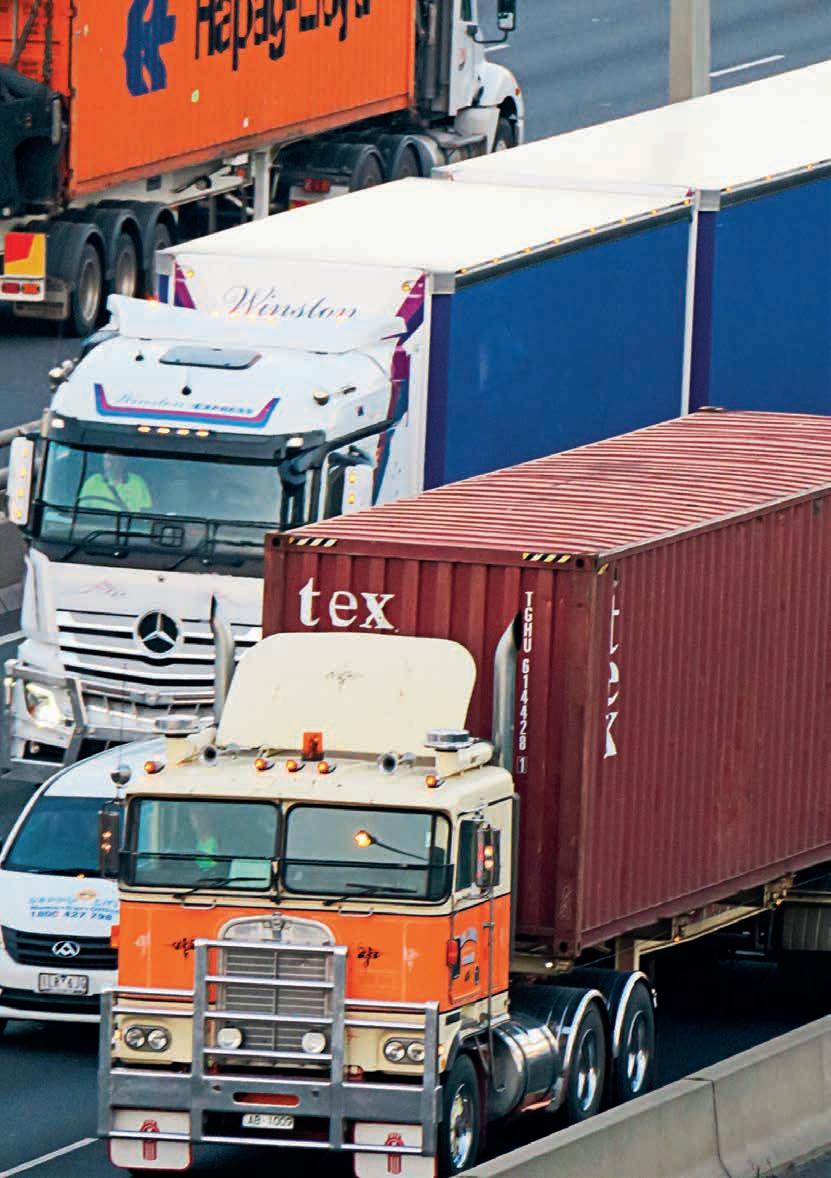
The number of variables make it difficult, no-one knows the price of energy in the future, whether electric or hydrogen or something else will dominate, or if any technology will do so. As a result, Russell is trying to work with mathematical methods which are able to encapsulate a lot of this variability, uncertainty, and can help the industry with its modelling, because it’s just so complex.
“We’re looking at a range of techniques, multi criteria analysis
looks at different attributes for the different alternatives and compares them and looks at the different preference weighting,” said Russell. “So we’ve done a lot of work in multi criteria analysis. We’ve also done a lot of work in robust optimisation, which tries to determine the best solutions when you acknowledge the variability and you can actually develop scenarios to look into the future, and see what these are likely to be”
33 www.powertorque.com.au
ALT-POWER

FINDING SUCCESS IN LEASING
Penske Leasing’s influx of new MAN models have proved popular with customers, and has launched the company strongly into 2024.
The last time PowerTorque spoke to Adrian Beach from Penske Leasing, the truck rental company was excited about its order of MAN TG3 models that were set to arrive on Australian shores last September.
Like many other sectors of the transport industry, the final quarter of the year is when business is busiest for leasing companies, and Adrian says 2023 was no different.
The new trucks came in at the perfect time for Penske Leasing. After continually facing shipping issues and factory shutdowns, the final months of 2023 have sparked massive growth leading into 2024.
“We usually like our brand new trucks to hit in the fourth quarter, where we kind of flex up to match the increased demand that comes in the fourth quarter with all the Christmas deliveries and stuff like that,” Adrian explains.
“I wanted to have some that were on the ground in operation, but they were still going through production, the build up and everything like that.
“The new TG3s coming in have been huge for business, and
customers love them. And with the lease business, now that we have this pipeline of inventory, we can really go after some of those lease deals.”
Adrian says that since the TG3 models joined the Penske Leasing rental fleet, demand for the trucks has increased massively.
“Now we’ve got people requesting TG3s, which is hard, because they still only make up 10 or 15 per cent of our fleet, we still have to replace our older models,” he says.
“When the drivers get dropped off to pick up their rental truck, they’re always asking if they can get one of the new ones.
“The TG3s are really easy to get in and out of, they changed the whole configuration of the door and the steps. Our GM cabs in the TGX 540s have got a flat floor and a really high roof, and a lot more room for the driver.
“They’ve brought the windscreen down and the window levels down.
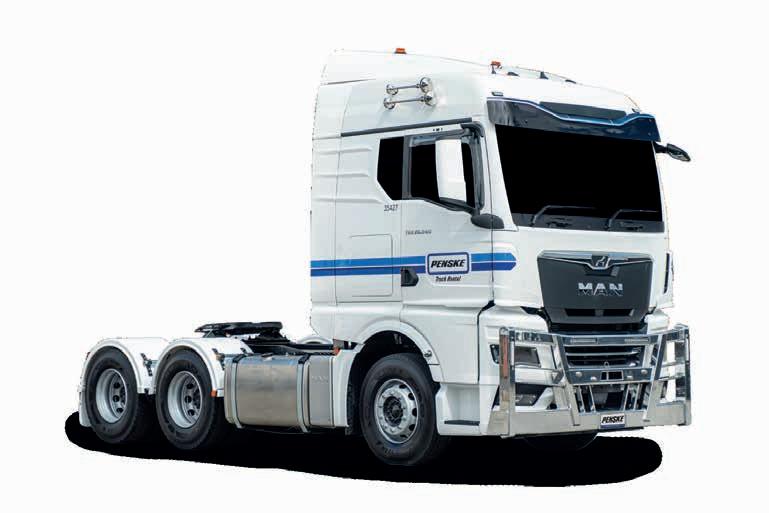
34 TRUCK LEASING
POWERTORQUE May/June 2024
IMAGES: PENSKE LEASING

The visibility is really good.
“The TG3s have got everything that we loved about the TG2s, it’s the same engine and drivetrain, they’re just stiffening up the front suspension a little.
“They’re still just as reliable, and fuel economy is great. But now they have a really flashy interior, it looks a lot more like a premium truck on the inside now. We can’t get enough of them.”
REFRESHING THE FLEET
With demand continuing to arise for the MAN TG3 models, it’s called for even more to be added to the fleet.
Fortunately for Adrian and the Penske Leasing team, the used truck market is probably stronger than its ever been. They work in conjunction with Penske Australia New Zealand to send models that have reached the end of their five-year leasing lifespans to used truck dealers, continually refreshing the fleet.

Germany.
“We’re having so much success with the lease product line lately, and some of that has to do with this pipeline of inventory we have.
It has paved the way for newer models to keep the Penske Leasing fleet fresh.
“I’ve got 100 TG3s on order. We’ve got some of them that are right here in the back, in Wacol, waiting to go through the process,” Adrian says.
“We’ll deliver to the dealership where they can do the final bits and pieces and retail them to us. And then we’ve got some that are already ordered that are on a boat in transit, and then we’ll have production slots.
“We don’t want to get them all at
“We can quote a customer, and we can say, ‘I actually have three of them in Wacol that match your spec’. So we can get those pulling trailers in service in just a couple of months.”
Adrian says that the TG3 models have seen so much success due to their versatility, able to service a range of different jobs for customers with various needs across the transport sector.
But for those in need of something heavier-duty, Penske Leasing is addressing that too.
“We do have some Western Star
before the launch because we just needed to get in line and get our slots. We’ve got a group coming in that are landing in July.
“They’re 48X models, with the 40 inch sleeper, the DD16, and then D12 automatic transmission. We’re looking forward to those.
“Those will be available in Brisbane, Adelaide and Perth. That’s where we kind of see the demand for big customers, road trains, a little higher weights, longer distances.
“Our South Australian customers, a lot of them service Darwin. So they’re going all the way up the middle and back. They’ll really love the bonneted truck, and the bigger cab and even more room for the driver.”
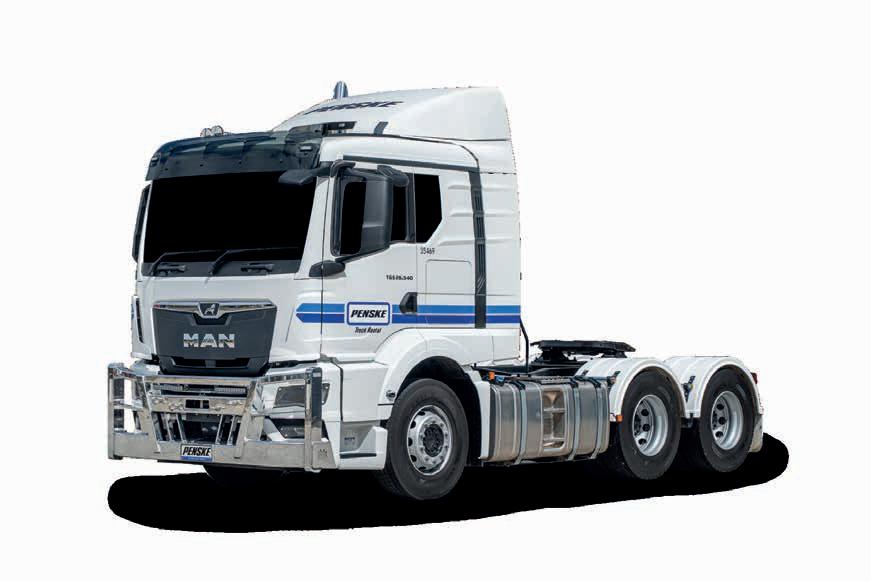
SERVING TO SUIT NEEDS
Another area where Penske Leasing has found recent success is in the type of customers they have been working with.
The rental market suits specific businesses better than others, Adrian explains, and they have been able to build working relationship with companies who aren’t as experienced in running their own fleets.
“We’ve really made progress with some manufacturing companies who aren’t necessarily transport companies,” Adrian says.
“We like transport companies, they use a lot of trucks and everything like that, but a bigger transport company has got fleet
35 www.powertorque.com.au TRUCK LEASING
TRUCK LEASING
experts and maintenance experts, and procurement experts. Because trucks and transport is kind of their core competency, there’s not as much value that we offer them.
“Whereas if we’re talking to a company that manufactures or produces something, processes something, they just need to have trucks, either as a customer service tool, to better service their customers to deliver equipment or tools or materials from one plant to the next. That’s where we really add a lot of value.
“A lot of those, fleet managers, there are operation managers, and they’re managing people and the plant equipment, and they got 20
different hats that they’re wearing in that company.
“With the lease deals we can offer them, we’re customising that program, it’s very bespoke.
“The base spec that we start with is maybe one of our five flavours of rental truck. If they want it blue, we’ll paint it blue. We put their livery on the side.
“If they want a different bull bar or a ballrace turntable, we can totally customise the spec. We structure the financing around how they’re actually going to use the truck.
“Our rental fleet reflects the fact that the needs are not the same in every location. The rental fleet in each location kind of reflects the
needs of the customers that are based out of there.
“That’s one of the things we like about the MAN TG3, and especially that 13 litre range that they have there. It’s a great little local truck for a customer.
“That’s one of the fun parts of the of the job is when you meet with a customer, and they’re not a truck expert.
“And you ask some questions about what they’re doing, where are they going? What’s the cargo? How is it secured, how they unload and unload?
“Then helping them pick the right tool for the job, that’s one of the fun parts of the job for me.”

36 POWERTORQUE May/June 2024

PERFORMANCE & ECONOMY
DD16

NO COMPROMISE 500-600 HORSEPOWER
@ 1,800 RPM

1,850-2 ,050 DIESEL ENGINE 15.6L INLINE 6 lb-ft @ 975RPM
Extreme duty and heavy hauling for your biggest jobs
Detroit’s most powerful truck engine ever, the DD16 boasts up to 600 horsepower and 2,050 lb-ft of torque. The big bore workhorse provides efficient and dependable power and performance without compromise.
Advanced combustion and aftertreatment technology exceed future emissions requirements whilst retaining exceptional fuel efficiency and uptime.
This power, performance, and efficiency are backed by the most comprehensive warranty and extended coverage packages, ensuring the highest level of support for our customers.
When you buy a Detroit product, you’re buying billions of miles of engineering excellence. Tried and true, Detroit engines are built to ride the roughest roads.
With Detroit, there’s no compromise.
detroitaustralia.com.au
detroitanz

COMPLIANCE 80/04 EMISSIONS ADR
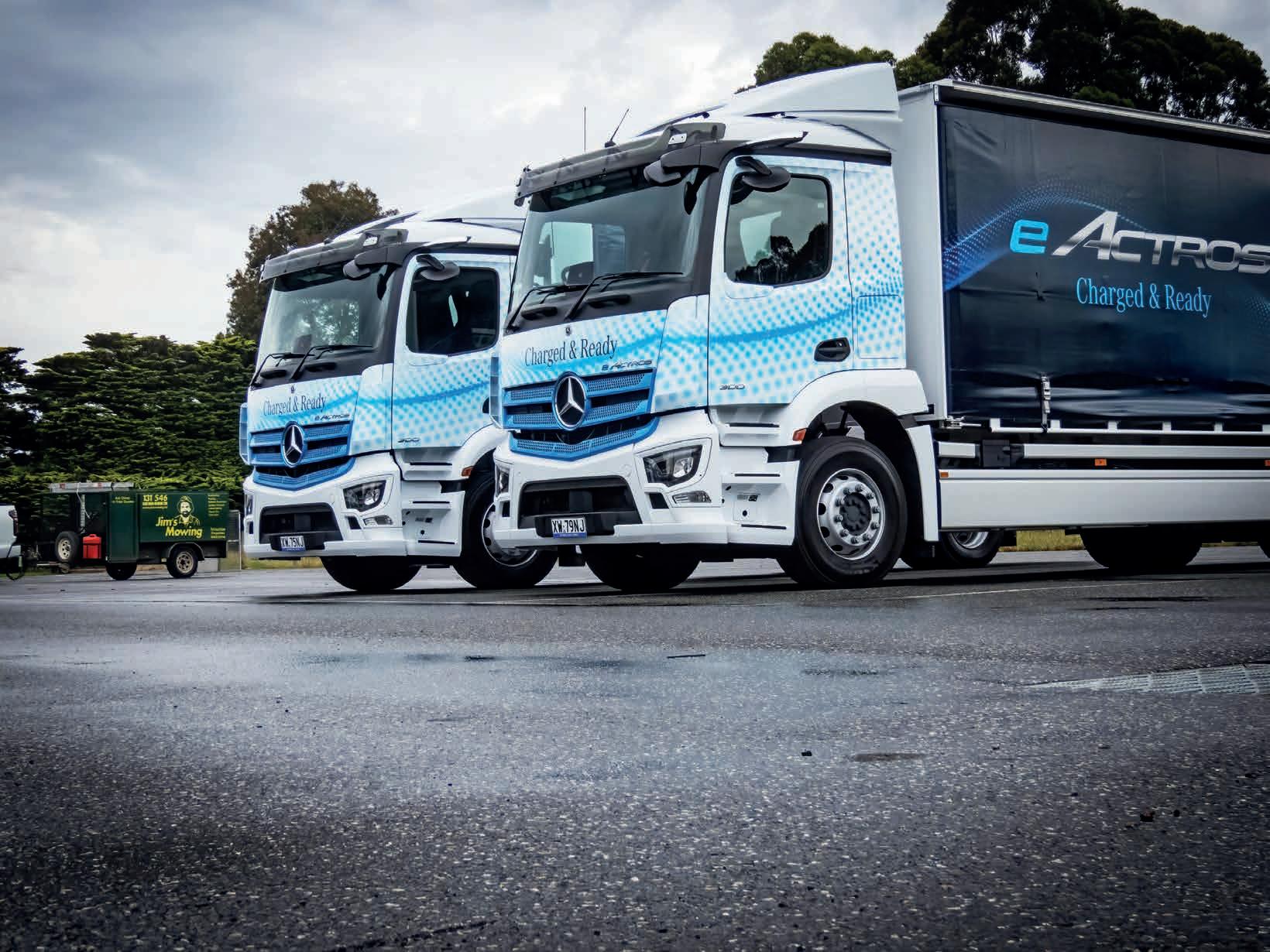
A NORMAL ELECTRIC TRUCK
The integration between the new technologies and the driver interface makes taking a trip in the new Mercedes Benz eActros more like driving a normal electric truck
The first generation of the Mercedes-Benz eActros looks like it’s going to be the basis for the design for the next 20 or so years, in the development of the new line of trucks the German truck maker.
The eActros was previewed in 2022 at the IAA Exhibition in Hanover, Germany, and includes several aspects of its design that we can expect to see in virtually all of the electric trucks arriving in our market over the next decade or so.
New models that we have been discussing in the last few years are much simpler electric trucks. They have been, basically, a diesel truck, which had the diesel engine and tanks removed, and the space has been filled with an electric motor, control and cooling systems, and power batteries.
Where the eActros differs from most of these is that, like the eCanter third generation, being released by Fuso around the same time (another company in the Daimler truck group), this truck includes an eAxle.

Development of the eAxle is a weight and space-saving technology that replaces the rear differentials on the drive axles with a large unit containing electric motors, a transmission, and a differential. This innovation frees up much more
space for the truck manufacturer to fit more batteries and also enables them to distribute the weight in a better way within their existing design. We can expect almost every single truck manufacturer moving into the electric space to eventually adopt something
38 TRUCKS ON TEST
POWERTORQUE May/June 2024
IMAGES: PRIME CREATIVE

like an eAxle drive and differential, instead of using a drive shaft being driven by an electric motor in the position of the previous diesel engine.
The eAxle driven for this test has two electric motors, plus a two speed transmission and a planetary set to control and directly feed power into the drive axle. It still uses the original housing used before, but with different equipment inside. On trucks designed to run at higher masses the transmission will be a four speed.
FIRST EXPERIENCE
Looking at the eActros from the outside, it is almost impossible to tell that it has electric power. However, that is not the aim of exercise. The point is to demonstrate that MercedesBenz does have this technology and that it is capable of handling a variety of freight transport tasks in the future.
Signage on the trucks, the blue flashes of paintwork, which Daimler chooses to put on all of their electric vehicles, and the casing in which the batteries are held give away what type of truck this is.
After climbing in the cabin, the thing that does give the game away is the fact that when you sit in the driver’s seat drop the key fob into a tray and press the start button, there is very little noise emanating from anywhere, a major departure from the traditional diesel powered truck.
Looking around inside the cabin, it is all very familiar to anybody who is given any of the more recent act Actros models a try. It’s not until you start looking into the detail that the tell signs of this being an electric vehicle, rather than one powered by diesel, come to mind.
Looking at the dash, which is like a large computer tablet mounted directly in front of the driver, there’s speed on the left, while on a the right, a circle. It shows charge, braking and then zero to 100 per cent. Underneath there’s the words ready and boost. There’s also an Auto and Power indicator, showing the driver which mode they are driving in. There can also be an Economy mode to conserve a bit more energy, if required.
Out on the road, this right hand dial becomes a really useful tool
for the driver, if they want to drive conservatively, conserving battery power, and avoiding that call to the boss to say the batteries are flat. The dial on the right comes to life, and moves to the right, when the driver engages drive and hits the accelerator. The amount of power being used, from nought to100 per cent is indicated. The higher the percentage, the faster the acceleration, the more power you are drawing down from the battery.
That calculation is quite obvious, but it is when the driver powers off and slows the vehicle when this dial comes into its own. Taking the foot off the pedal brings it back to zero, no energy being used. To slow, simply apply the brakes gently and the regenerative braking comes, slowing the truck and also charging the battery back up.
The first pushes to the brake pedal simply engage the regen, which ramps up as you push, there are five levels of regeneration available. Push the brake pedal harder and the service bakes are blended in with the retardation to bring the truck to a halt. The left hand side of this dial shows the amount of regen being used and also when the brakes are being applied, giving the driver a clear idea of what’s going on under the bonnet.
There is also a steering column stalk to control the level of retardation, and experienced drivers will probably feel more comfortable using that, as it’s more familiar to those used to a conventional engine brake. However, the brake pedal will also be needed to bring the truck to a halt so, perhaps, just relying on one control rather that two might turn out to be easier. It’s relatively simple to drive with the pedal, especially when keeping an eye on the right hand power dial.
This neat instrumentation should be an antidote to the range anxiety which seems to grip electric truck owners and drivers. The visibility and design of the system, enables the driver to maximise battery life, and thus, reduce the anxiety levels. The display also has a live read out of the expected kilometres left in the batteries, this will vary over time, but proves to be another useful antidote to range anxiety.
To the left of the driver is a second,
larger, screen with other information about what’s going on in the trucks, but data that is not needed instantly. There are tyre pressures, axle masses, an energy flow graphic which looks nice, but it is not clear how useful it would be, plus other data for the driver and maintenance team. Cameras can also be connected, PTOs controlled etc.
There were also two other screens in the cabin for this test drive, and they are the mirror cam screens fitted to the A pillars. The technology exists and is available on most brands, but the level of take up of the concept has been low, so far, even in Europe. Tthese are the latest iteration and are an improvement on the previous ones tested. The jury remains out on this technology, but history tells us the idea will slowly catch on and become more accepted over time.
Over the few hours of this test drive using the mirror cam became familiar, and it wasn’t a chore to use them instead of conventional mirrors. Plus, of course, we were conserving energy by reducing aerodynamic drag from normal mirrors, and, therefore, reducing range anxiety, to a small degree.
CHARGING ETC.
The test drive of the new eActros was an opportunity to actually go through the whole process of charging the truck up. The truck has to be shut down, but unlocked to be ready for recharging. The driver simply pulls the charging plug from the charger and plugs it into the charging port on the side of the vehicle. a set of pins automatically secure the charging plug in place.
Around the socket the lights begin pulsing in orange, indicating that there is now communication between charger and truck and getting all the technical information. The system is checking out which truck it is and the level of charge in the battery. In this case, the charger tells us it can charge as a maximum of 260kW. This is the handshake process the system goes though before any charging takes place.
When the charger knows the cable is correctly plugged in and it is safe to
39 www.powertorque.com.au
ON TEST
TRUCKS
TRUCKS ON TEST

proceed, the light around the charging socket goes green and the process begins. Inside the charger there’s a whirring noise, but the only real indication anything is happening is the green light at the socket.
In the background, there is an overall charging management system which will have overall control of all of the chargers on a particular site. The operator can then prioritise different charging regimes to get the best efficiency out of the set of chargers. Some may choose to ensure the system fully charges priority trucks and will charge other after the priority trucks are fully charged, or the strategy may

be to ensure all of the fleet gets to 80 per cent charged, before moving to fully charge all of the trucks. Charging a battery from 20 to 80 percent charged can be relatively quick but getting them from 80 to 100 percent can take longer, and use more electricity.
The driver can also set the maximum charge required, as a percentage, on the truck’s dashboard. This can be useful for an operation which may travel on some long downhill stretches of road, early in the journey. In that case the truck can topup from using regenerative braking on the way down, getting the energy for free, from gravity.
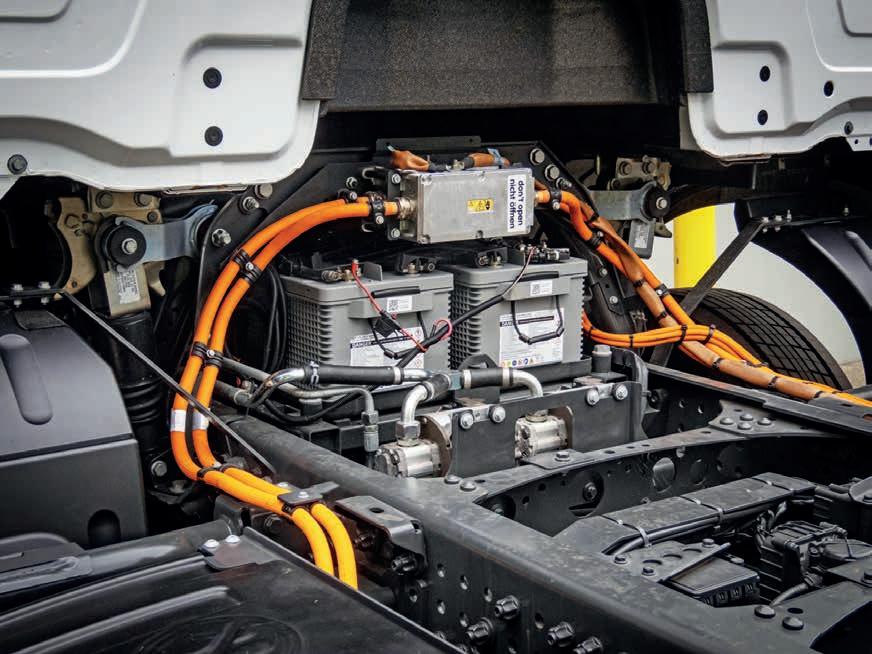

On the dash, the truck will tell you at what speed it’s charging and when it will be finished. It is even possible for the operator to set the departure time. Before the truck is started it will precondition the battery, making sure it is already at it’s ideal working temperature, between 20 to 25 degrees C. It can also turn on the air conditioning or heater, whatever would be appropriate. When the driver arrives, everything’s ready to go but using mains power rather than using the battery.
The electric system produces 600 volts, but there is a DC to DC converter, dropping the voltage down for the 24 volt electronic system for lights and control systems, which are the same as on the diesel version.
Each of the main batteries has its own battery management system and they’re mounted across the truck slung beneath the chassis rails. There are acceleration sensors which will measure any side impact onto the batteries. If there’s an impact, the sensor will pick it up and kills the electric system.
Each battery has got a little chimney through which any smoke around the battery would flow. These chimneys are fitted with a smoke detector and if any is detected, it also kills the electric system. If the battery cells are in the early stages of a runaway, killing power is the best way to stop it.
There’s also a manual switch inside the cabin for the driver to be able to kill the electric system if there is anything amiss. When you turn the
40POWERTORQUE May/June 2024
The electric truck still needs 24V batteries to runs ancillary equipment


start/stop button off the electric system is already disconnected. There is another way to disconnect it if it may be a problem getting into the cab. There are two cable on either side which could be cut by any fire services, and this disconnects the high voltage as

well. The fire services have been trained up on this by Daimler Truck.
At the end of the day, this test drive gives a fair idea of the typical day’s drive for a driver working in an electric fleet. The driving is different, but adapting to the new

technology is relatively painless. The relative silence in the cabin is going to reduce stress and the ease of being able to control the truck safely and efficiently just with the two pedals makes life a little less complicated.


41 www.powertorque.com.au
Comes with FREE* roadside tyre support. * For vehicles registered with TEN-24 www.ten24.com.au Scan here for details Giti Truck Tyres are your road to Safety Savings Durability 24/7 Truck Emergency Network TRUCKS ON TEST
HYDRAULIC HEROES: PIRTEK SERIOUS ABOUT SERVICE
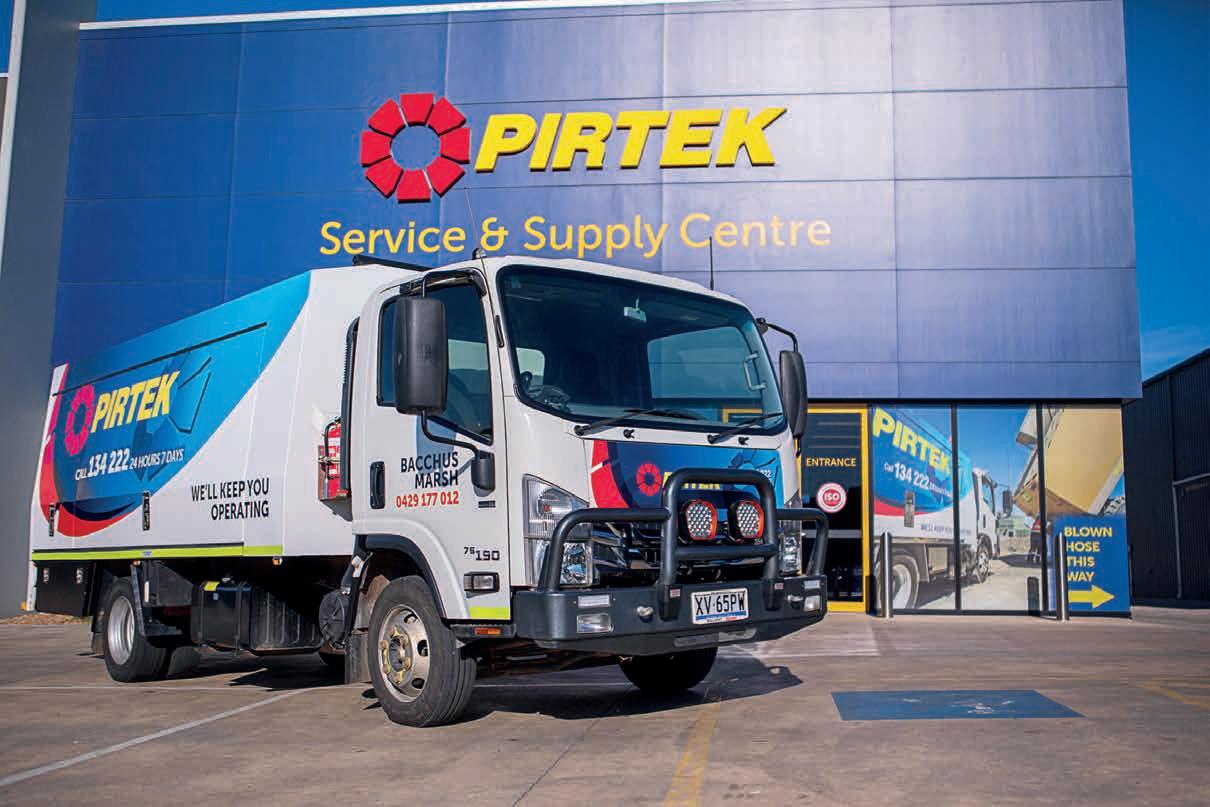
From their origins in 1980 in Rydalmere (NSW) with one outlet, through to the massive success they enjoy today as one of the world’s leading suppliers of premium fluid transfer solutions, Pirtek is a prime example of having the right people, product and services in place, at the right time.
This mantra extends to having their technicians arrive handily on-site to customers, supported with highly specified mobile service vehicles across the Pirtek network in Australia. Amongst the fleet are around 100 Isuzu trucks, the majority cherry picked from Isuzu’s 4,500 kg – 7,500 kg GVM N Series range.
The NPR 75-190 is a popular model of choice for Pirtek’s franchisees, who rely on their service trucks to meet the growing demands of a home-grown Australian customer base.
This franchise model sees service
centres and mobile units criss-crossing Australia from cities and regional areas like Ballarat in Victoria, through to true outback locations such as Newman in Central Western Australia.
IN (AND OUT OF) TOWN
Pirtek Ballarat has a wide service footprint from Ballarat central to Melton in Melbourne’s East, through to Horsham in the west of the region.
As well as owning the franchise in Ballarat, Darren has another two operations, one servicing the Whitsunday & Collinsville region and the other servicing Mount Isa to Cloncurry—this being one of the largest territories in the country.
Dealer Principal Darren Campi says their fleet of Isuzu trucks, which is cemented by the NPR 75-190 (GVM of 7,500 kg), is simply the right fit for their technicians, who specialise in the supply and maintenance of
hydraulic hoses and fittings for largescale mining machines down to small excavators on home building sites.
“The one thing we say as part of the Pirtek network is that every day is different with the type of work we undertake,” Darren detailed.
“Industry in Ballarat and the areas that we service include manufacturing, forestry, construction, agriculture and civil works, so it is very diverse.”
Jobs will often see the team taken off the beaten track, from remote locations through to crowded work sites with various technicians and trades all needing to get down to their business.
Each Pirtek mobile unit is integrated with a custom service body by Allweld Manufacturing in Queensland to allow for large volume and weight of stock. Gullwing doors allow the technicians to work under cover, and trucks sport a high-demand electrical system
44
OPERATOR PROFILE
POWERTORQUE May/June 2024
IMAGES: ISUZU TRUCKS

Behind it all is a brand that backs their business partners down to the smallest details.
In terms of vehicles that franchisees are encouraged to use, Brand Manager for Pirtek, Brian Watson, said the popularity of Isuzu product for the purpose of mobile service units comes down to the variety and versatility of models on offer.
“Pirtek has very high standards in terms of quality with our products and service, and that includes presentation,” said Brian.
assembly equipment.
“We had the team in mind when we selected the NPR as we needed a truck hardy enough for the work benches and able to support the tools and machinery for the onsite jobs,” said Darren.
“We take the trucks into some rugged places, which can feel like the middle of nowhere.
“The NPR is easy to drive, works well in tight places and the turning circle is a massive bonus in some of our trickier locations.”
TRUE BLUE PARTNERSHIPS
Aware of Chain of Responsibility and compliance obligations, and willing to take any extra steps to ensure the safety of his teams, Darren is pleased with the features on offer in the NPR 75-190.
“The safety systems including dual airbags, seatbelt pre-tensioners and Isuzu’s Advanced Driver Assistance Systems (ADAS) all add up to ensure our team is safe while out on the road.”
Aside from the reassurance offered by Isuzu’s ADAS safety, the drawcard of the NPR 75-190 is a power punch delivered from the four-cylinder, 16-valve SOHC turbo diesel engine, which provides 513 Nm of torque @ 1,600 – 2,600 rpm.
Transmission choices for the NPR include an easy-to-operate, two-pedal, fully Automated Manual Transmission and a six-speed manual for maximum driver control in any rougher terrain.
Any new additions to Pirtek Ballarat’s N Series fleet are backed by
warranty and six years of Isuzu’s roadside assist program. This is further supported by exceptional aftersales care offered by their local Isuzu Trucks dealerships.
“The trucks are easy to maintain and reliable. Outside of regular servicing we have not had to call on Ballarat Isuzu often, but there is peace of mind knowing they have our back if required,” said Darren.
MEETING DEMAND
Franchisees such as Darren, who’s focus on providing first-class service, backed by a fleet that deliver not only tools and technicians but better efficiency for the business all add up to make Pirtek what it is today. The company now enjoys an enviable international footprint that encompasses 23 countries and 13,000 product lines.
“When a Pirtek technician arrives on site, the customer quickly appreciates the professional approach, including the way the service vehicles are presented and laid out.
“Our vehicles have to work in a wide range of conditions and locations, so we work with each franchisee plus the engineering group at Isuzu Trucks to best cater for what is required out in the field.”.
Reliability of product and the backing of a trusted partner are among the key criteria for supporting the national transport fleet.
“Across the country we have over 100 Isuzu trucks in operation that ensures we offer efficient servicing and can get our customers back in business quickly,” he said.
“Pirtek is delighted that Isuzu Trucks shares the same philosophy to putting the customer first.
“Through the extensive dealer network across Australia, we are able to ensure the wheels are kept turning to meet our customers’ needs.”
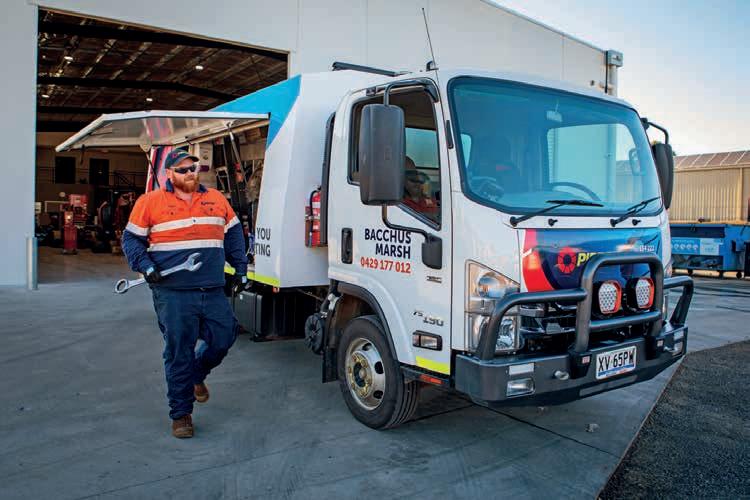
45 www.powertorque.com.au OPERATOR PROFILE
Each Pirtek mobile unit is integrated with a custom service body
A RISING RURAL STAR IS NAMED
In its second year, the Rural Transport Rising Star Award attracted another group of young people who are going to take the rural transport industry onwards and upwards into a, hopefully, bright future.

On the opening day of the combined conference of both the Australian Livestock and Rural Transporters Association and the Livestock and Rural Transporters Association of Queensland held in Toowoomba, Queensland in late March, the finalists for the Rural Transport Rising Star Award were presented to the event and a final winner was announced.
Luke Cannon of Frasers Livestock Transport in Queensland was named as the Rural Transport Rising Star Award 2024. The award judges also commended the runner up, also
in attendance, Padraig Carey of T & M Smyth in New South Wales. These two young people had been identified as the two from the field of nominations for the award most deserving of the accolade and had invited them to attend the award ceremony and the national livestock and rural transport conference.
The RTRS recognises the up and coming young people in the rural transport industry and nominees were recommended by a member of one of the state or territory-based ALRTA industry associations. They also had to be aged under 35 as of December 31 2023, and work in
rural transport in Australia.
As the winner Luke is set to receive support to the value of $5000 to undertake professional development and training to further his transport career. Both shortlisted finalists received complimentary registration to the ALRTA Conference and their travel expenses for the event covered. They also received a GME Personal Locator Beacon. All of those nominated for the award will receive a Hino gift pack.
THE WINNER IS…..
28-year-old, Luke Cannon works for Frasers Livestock Transport, a
44 RURAL TRUCKING
MATTERS
POWERTORQUE May/June 2024
Presentation of the RTRS Trophy (L to R) Athol Carter, ALRTA Vice President, Runner Up, Padraig Carey, LRTAQ President, Gerard Johnson, Winner, Luke Cannon, Rachel Smith, ALRTA ED, Cedric Boissezon, Customer & Offer Development Advisor, bp Australia and our own Tim Giles
IMAGE: PRIME CREATIVE
family-owned livestock transport business specialising in moving cattle, sheep and pigs. He works in fleet operations and sale-yard relations.
Luke’s current role sees him coordinating the day-to-day logistics of the sale-yards, servicing which can include up to 30 different saleyards weekly. While he says this can be tough to manage, he works alongside Frasers’ operations manager to ensure the smooth operations of the yards.
A career in transport was almost written in the stars for Luke. He’s a third generation truck driver, following in the footsteps of a family well and truly entrenched in rural transport and jumping in the cabin of trucks and working with his family’s livestock from a young age.
Luke has already come a long way behind the wheel, he started off driving a Kenworth T650 in a semi combination before moving up to a T659 hauling B-Doubles and B-Triples, plus a triple road train.
On winning the Rural Transport
Rising Star Award, Luke said he will put his prize towards continuing to further develop his skills within the industry, to become better educated and skilled within the supply chain logistics sector. He’s not lacking in ambition, eyeing off a big future with Frasers, hoping to eventually become the company’s operations manager.
21-year-old Padraig (or ‘Paddy’) Carey works as a HC driver for T & M Smyth Transport, a stock carting business in Wagga Wagga, driving a Kenworth 402 towing a 45ft Byrne trailer.
A farm boy at heart, Paddy is at home carting livestock to and from the Wagga sale-yards, with the occasional longer journey, and is the designated drover on sale days. It’s a job that suits him perfectly, having grown up around animals on his family’s farm.
Throughout his youth, Paddy says he was always fascinated by trucks and couldn’t wait until he was old enough to get behind the wheel of one. He joined Tim Smyth in the cab

for the first time on a job when he was 14 and knew that working in livestock transport was going to be his career path.
Paddy got his medium rigid licence as early as he was able to, and started working for T & M Smyth from there. He recently upgraded his licence in January.
While he says that moving livestock can be frustrating at times - particularly with plenty of stubborn animals - he’s learned that patience is the key to the job. And while there have been challenges, it’s already given him lasting memories, citing a 14-hour journey between Finley, NSW and Roma, QLD as one of his career highlights so far.
Paddy says that the first thing he would do if he wins the Rural Transport Rising Star Award is buy some working dogs to help him out with the livestock. He has future ambitions to become an owner driver and upgrade his licence further to be able to drive road trains, and even own his own transport business.

RURAL TRUCKING MATTERS
Luke Cannon Padraig Carey
IMAGE: PRIME CREATIVE
IMAGE: ALRTA

ALRTA COMMITTED TO DRIVING CONTINUOUS IMPROVEMENT TO ANIMAL WELFARE STANDARDS
Driver and animal welfare continues to be a principal issue for the Australian Livestock and Rural Transporters Association and its members, writes Executive Director Rachel Smith.
Asupply chain to bring about proactive measures to continuously improve standards within the industry.

Recently, ALRTA attended the National Animal Welfare Roundtable, here in Canberra with 27 representatives from across the meat supply chain including producers, transporters, regulators, processors and saleyards and renewed our commitment to working collaboratively to support a safe and sustainable meat industry in Australia.
Critical topics discussed were the need for best practice facilities that support operator and animal welfare including loading ramps, commitment to animal welfare standards and ensuring animals are fit to load and loading densities are adhered to.
From our perspective it was
interim has committed to:
• Advocating for the harmonisation of the application of legislation and regulation nationally pertaining to standards, welfare and transport
• Investing in training of drivers and operators to ensure the safety and welfare of both drivers and animals
• Working alongside regulators to uphold Australia’s high standards of animal welfare, including addressing unsafe behaviour exhibited by a minority of activists
• And continuing to develop alongside other parties in the supply chain a transport hub, which is a will be a one stop knowledge shop for everything pertaining to livestock transport,
and demonstrates the power of working collaboratively across the supply chain to proactively address driver and animal health and welfare concerns.
ALRTA is also working closely with TruckSafe, NTI and other key stakeholders to develop a livestock transport accreditation module that will continue to support our members in the critical work that they do.

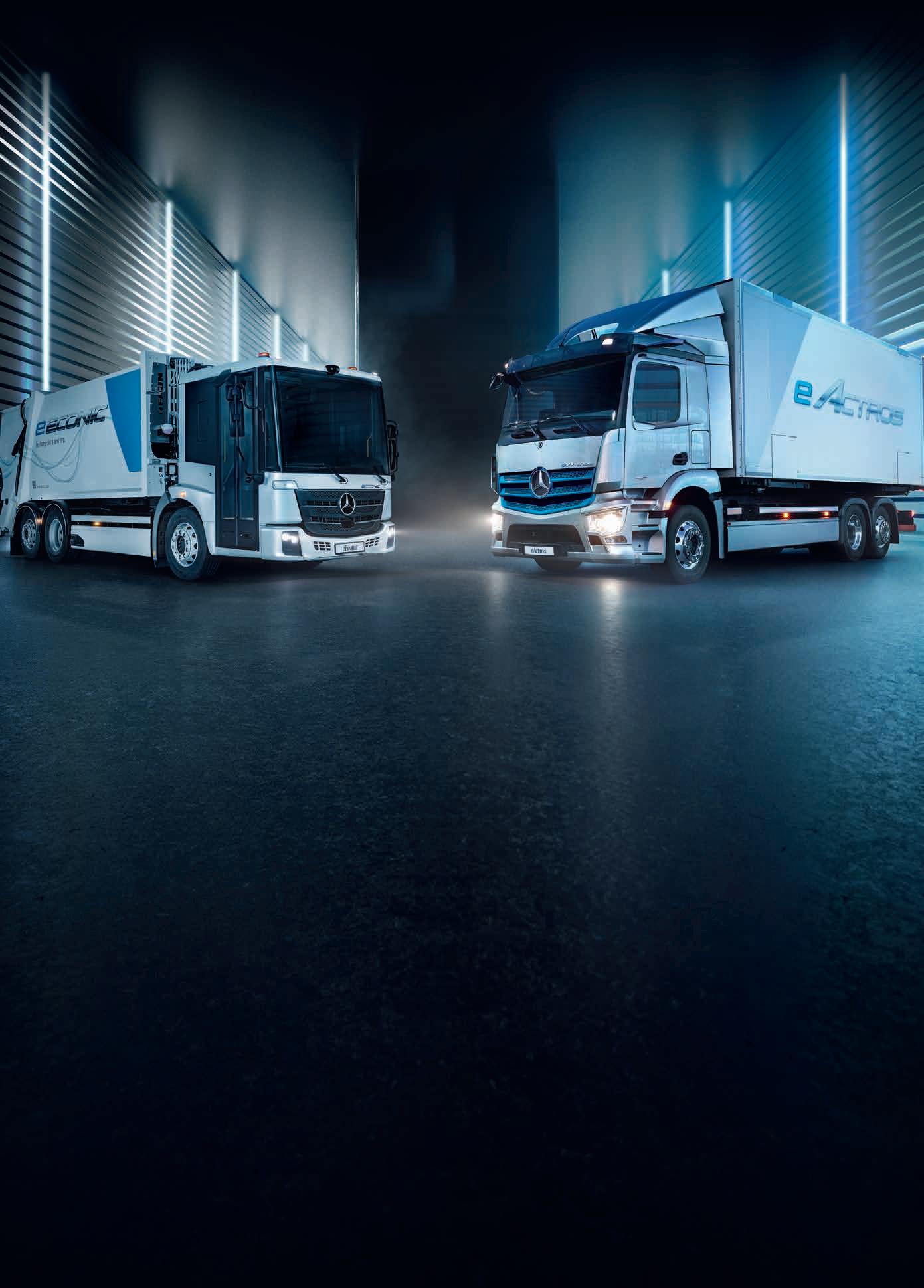
46
POWERTORQUE May/June 2024 RURAL TRUCKING MATTERS SCAN THIS QR CODE FOR MORE INFORMATION
L to R, Athol Carter, Compliance and Central QLD Manager, Frasers Transport, Jennifer Rotoli, Manager – Codes of Practice Safety and Productivity, National Heavy Vehicle Regulator, Graeme Hoare, Chair ALRTA Driver and Animal Welfare Committtee, Rachel Smith, Executive Director ALRTA, Alina Hawkins, COO LRTAV and Russell Borchard, President LRTAV.
IMAGE: ALRTA

CHARGED AND READY.
Introducing the all-electric Mercedes-Benz eActros and eEconic
and Mercedes-Benz
Group AG. Overseas model shown.
are trademarks of Mercedes-Benz
CLOSING LOOPHOLES EXPLAINED
In her report back to the Livestock and Bulk and Rural Carriers Association conference, the Executive Director of the Australian Livestock and Rural Transporters Association, Rachel Smith’s speech saw the recent act passed in Federal Parliament on closing loopholes explained.
One of the commitments that the current federal government made coming into the last federal election was to enact some significant industrial relations reform. This followed the problems caused by the failed introduction of the Road Safety Remuneration Tribunal which was eventually thrown out. Rachel Smith contends the new bill that has been passed includes some elements of the previous scheme, but there are a lot more safeguards.
“It will empower the Fair Work Commission to make orders on the road transport supply chain, but there’s a lot more protections built in this time,” said Rachel. “There has to be 12 months of consultation, plus the Minister for Workplace Relations can actually intervene if an order is unfair, and can’t be applied. He can tell them to go back to the drawing board or repeal the order in its entirety. This
wasn’t possible under the previous scheme.
“Some of the positives that industry can take from the Fair Work Commission is that an order could be made, for example, to set payment timeframes of small operators. So, I think that’s something that the Australian Trucking Association will push for and, as a member of the ATA, we will advocate for small businesses to get paid on time, not 90 days after the 30th of the month, because we all know that cash flow issue is critically important.
“Other areas that may be touched on would be fuel levies, terminations, cost recovery, and I guess the most contentious one for industry is that there may be an application to set a minimum rate for freight. How that will be applied and calculated is yet to be determined. The unions will tell you it’s the setting of the minimum rate, not the ceiling, but we’re yet to see


how that will play out.”
Areas that the Fair Work Commission cannot touch are overtime, rostering, deeming a contractor to be an employee of someone else, WHS matters, Heavy Vehicle National Law matters, and most importantly, matters set out in previous regulations.
The ALRTA were able to achieve a livestock transport exemption, but that is in the regulations, not in the legislation. At the moment, the ALRTA is advocating to have a rural transport exemption as well. In fact, the ALRTA were the only association, in partnership with its state associations, to achieve any kind of exemption in the regulation.
“We’ve put a flag in the sand,” said Rachel. “It also leaves us in a good position, because we can sit back and see how some of the things are going.
If it’s good, livestock transport carriers may opt to be in the legislation and have that exemption removed. But if things aren’t working out well, we
48
RURAL TRUCKING MATTERS
POWERTORQUE May/June 2024
Executive Director of the Australian Livestock and Rural Transporters Association, Rachel Smith’
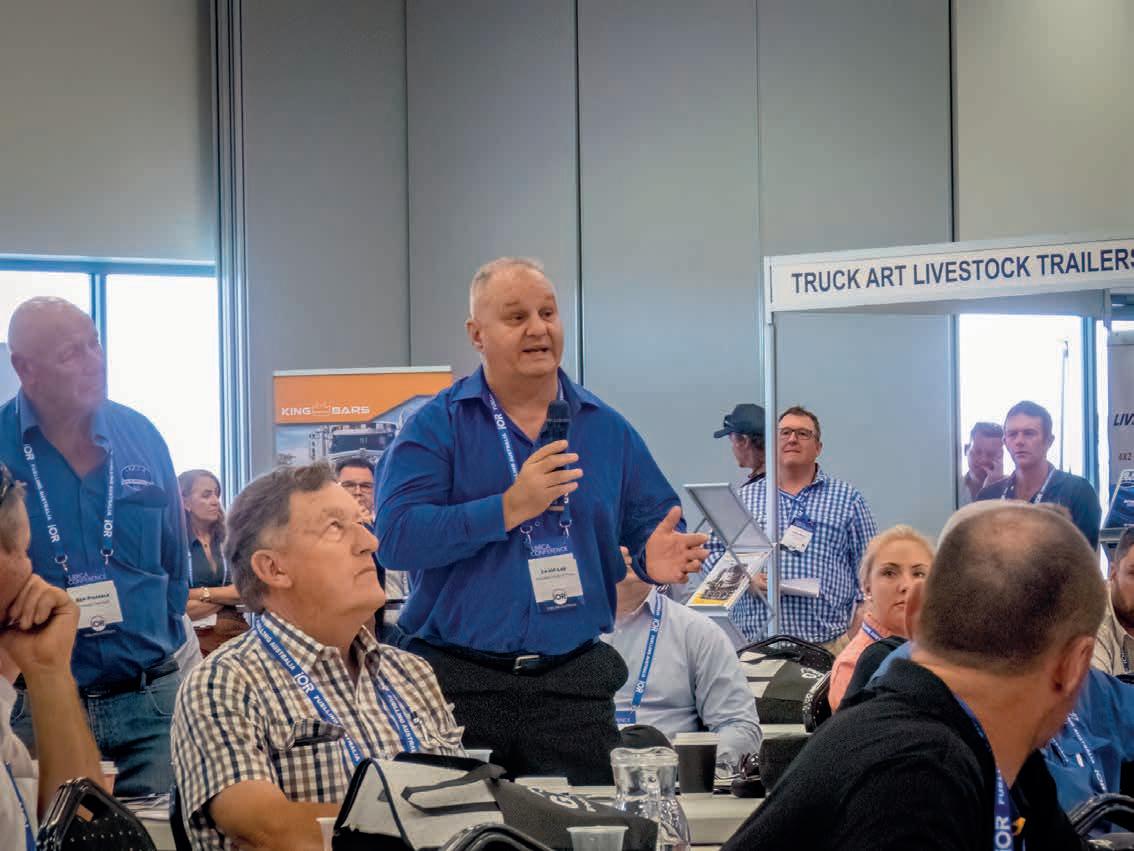
that exemptions can be done, and that we can get an exemption for parts of our workforce that these orders or this legislation is not working for.
“In terms of what is next, we will continue to work with the cross bench to ensure that this legislation doesn’t negatively impact the association’s membership, whether you’re a rural carrier, or you’re a livestock transporter.
“We’re also speaking to the minister’s office a couple of times a week at the moment, and I’ll continue to do so. They seem open to feedback, I think they learned a lesson last time with RSRT that it wasn’t workable. Industry rightly, strongly lobbied hard to have that piece of legislation repealed. I think they’ve learned they need to do genuine consultation and take on feedback.”
DISCONNECT
The other area of the Closing Loopholes legislation which has been
to choose not to answer an employer’s phone call after hours, but it’s based on what is reasonable and ALRTA, in partnership with the its state associations, is set to consult with the government on scenarios that are specific to transport where it would be reasonable for an employer to contact an employee after hours.
It might be a truck is broken down. It might be checking in on mental health and wellbeing. It might be a change in roster. Road transport is a 24/7, 365 days a year industry. ALRTA will recommend and submit some guidelines, then if a claim is made or an application is made to the Fair Work Commission, vexatious employee claims can be quickly dealt with.
“This is actually a bit of contentious last-minute legislation which was only put up by the Greens in the last 24 hours of the bill actually passing the house,” said Rachel. “The government needed their support to get the bill
expectation within an industry that after-hours contact is required, that is deemed reasonable.”
The Fair Work Commission for the road transport section sector has yet to be appointed, and probably won’t happen for another six months. Once the commissioners are appointed, there’ll be another 12 months of recruitment of agency staff that sit below the commission. Only after that will they actually start accepting applications for orders.
Once an order application is submitted, there’s a mandatory 12-month consultation time on that order. This means that nothing in this field will appear until, potentially, 2026. In that time there could be a change of government.
“I bet my bottom dollar that the coalition would throw this piece of legislation out as soon as they get the chance to,” said Rachel. “We will pass on information when it does come to hand.”
49 www.powertorque.com.au
RURAL TRUCKING MATTERS
IMAGES: PRIME CREATIVE
INDUSTRY ISSUES
NHVR TRANSITIONS INTO QUEENSLAND REGULATION
The NHVR is now seen across Queensland, following the transition of heavy vehicle safety services, writes Sal Petroccitto OAM, NHVR CEO
This year marks 10 years since the National Heavy Vehicle Regulator (NHVR) commenced and from this time we have worked diligently towards improving road safety across Australia, placing a major focus on building consistency in our regulatory operations on a national scale.
Beginning in 2016, the National Heavy Vehicle Regulator’s (NHVR) National Services Transition program has successfully transitioned heavy vehicle regulatory services from the relevant state and territory transport agencies in the Australian Capital Territory, South Australia, Tasmania, Victoria, and New South Wales, to the NHVR.
The program has now reached completion following the transition of services from the Queensland Department of Transport and Main Roads (TMR) to the NHVR on 20 April, the final participating jurisdiction to transfer responsibility for the direct delivery of heavy vehicle regulatory services.
The transition marked the next stage of a more streamlined approach to how heavy vehicles are regulated across the country.
As a result of the transition, industry will now benefit from consistent regulation across all participating states and territory. The NHVR now has a borderless operating model, allowing more flexible deployment of resources to address the greatest risks on our roads.
As Australia’s regulator, the NHVR is providing nationally consistent education, enforcement and resources, and is committed to undertaking more complex Chain of Responsibility and primary duty investigations into duty holders

across the supply chain.
As part of the Queensland transition, we have established the NHVR’s Northern Region with 14 regional homebase locations across the Sunshine State, and two satellite offices, with our operations head office located in Townsville.
Industry travelling across Queensland may have already spotted a new uniform, badge and vehicles, with NHVR Safety and Compliance Officers (SCOs) working roadside and at heavy vehicle inspection sites across the state.
Industry can expect an increased on-road presence across Queensland, particularly in regional and remote areas, including the far north and western areas of the state.
Industry must still meet the same safety requirements as they have done in the past, with our SCOs authorised to stop heavy vehicles and check for compliance with the Heavy Vehicle National Law (HVNL) as well as some other heavy vehicle
related state-based laws. They will check compliance with mass, dimension, load restraint, vehicle standards, access conditions, driver fatigue and work diaries, as well as some state requirements like dangerous goods, licensing and registration.
We are now delivering our inform, educate, and enforce approach to Queensland roads. The NHVR is committed to this regulatory intervention strategy – we place a strong focus on educating heavy vehicle drivers and operators, whether it’s via our on-road compliance activities or industry engagement. We understand the importance of reserving our regulatory powers for those who consistently do the wrong thing, to ensure we maintain the highest safety outcomes.
However, while we believe education is a powerful tool in preventing accidents, the NHVR doesn’t hesitate to enforce the

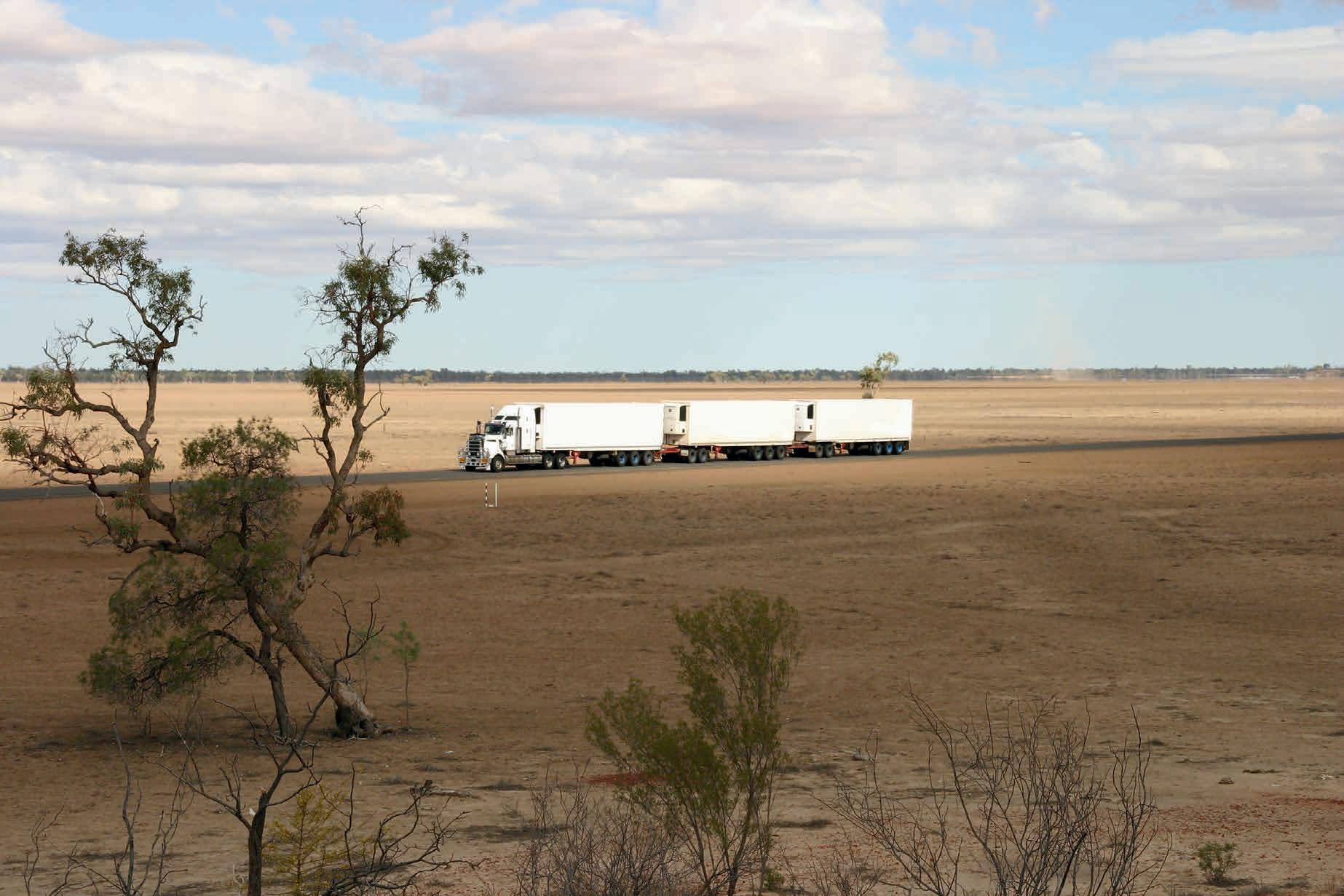
50
POWERTORQUE May/June 2024
IMAGES: PRIME CREATIVE

HVNL where required. We are authorised to issue infringements and prosecuting for serious offences in Queensland, in addition to issuing defect notices where heavy vehicles do not comply with safety standards.
We have formal agreements in place with jurisdictions and policing agencies to support cooperative operations. We continue to build and maintain strong relationships with police and work collaboratively to address the risks on our roads.
Following the Queensland transition, the NHVR is also responsible for collecting and analysing data relating to heavy vehicle movements, and monitoring and responding to non-compliance with the Intelligent Access Program. This means we now have the ability to improve safety through investment in technology and innovation.
As a modern regulator, the NHVR is increasingly using data to target the biggest safety risks on our roads. We now have national data to inform
more targeted compliance activity, and better capability to deliver timely, national responses to critical compliance issues.
It’s safe to say the benefits of the Queensland transition are immeasurable, with the NHVR now providing industry with a more consistent approach to compliance and enforcement, from the roadside to interventions, and a single point of interaction for consistent, reliable information about the HVNL and issues facing drivers or businesses.
To ensure a seamless one-stopshop approach for heavy vehicle regulation in Queensland, the NHVR is now also providing Programmed Vehicle Inspections (PVI) on behalf of TMR, including at regional and remote PVI locations. Industry can continue booking a PVI through existing TMR channels, but fleet bookings must be organised through the NHVR Contact Centre.
With the number of NHVR staff growing significantly through
INDUSTRY ISSUES
transition, so too has our collective knowledge and experience. The Queensland transition has seen 110 TMR employees transfer their employment to the NHVR, bringing with them years of expertise of the heavy vehicle industry in Queensland.
The NHVR directly employing its authorised officers means all SCOs will receive the same training, aiding the consistent delivery of regulatory service and can deliver services seamlessly across borders.
The NHVR’s focus now lies on accelerating harmonisation, as we continue working towards a safer, more productive and efficient heavy vehicle industry.

SCAN THE QR CODE TO FIND OUT




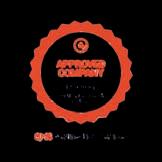




powerdown.com.au The Powerdown Supershock just got bigger and better. When the oads get heavier & the terrain gets more demanding Large 45mm bore size Upgraded dampening orces Extreme temperature shock uid 02 4949 0000 Powerdown Australia COMMERCIAL VEHICLE SUSPENSION SPECIALISTS Supershock Shock bsorbers Bonded rubber exib e mounting bushes NEW P102HD Heav Dut Suitable for fitment to Neway AD suspensions
MORE

ROAD STANDARDS REFORM NEEDS A SHORTER JOURNEY
A shorter journey for road standards reform is achievable, writes National Road Transport Association CEO Warren Clark.
The journey to delivering better policy outcomes can feel like a long and winding road.
The reform of the Heavy Vehicle National Law is a good example. The HVNL review has stretched on for six years and governments recently gave themselves another extension. New legislation will not pass parliament until 2025, at the earliest.
You don’t have to look hard to find a longer running journey where industry is yet to see meaningful outcomes delivered on the ground.
Heavy Vehicle Road Reform (HVRR) focuses on how heavy vehicle charges are determined and infrastructure spending is made. It has been in the too-hard basket for 17 years.
In 2007, the Productivity Commission found heavy vehicles are the logical starting point for road user charging and investment reform.
Responding to the Commission’s report, the then Council of Australian Governments (COAG), agreed to a three-phase reform plan, the COAG Road Reform Plan.
2009 brought an initial report and by 2011 a feasibility study was delivered. In 2012, five years into the journey, the program was renamed to Heavy Vehicle Charging and Investment (HVCI).
HVCI had a short life in terms of branding, ultimately becoming Heavy Vehicle Road Reform (HVRR) by 2014.
And while COAG did not survive the COVID pandemic (replaced by National Cabinet), HVRR is still with us today. 17 long years with little delivery.
In 2017, a detailed consultation occurred focused on setting up independent price regulation of heavy vehicle charges. At the time,
NatRoad said the reform was long overdue. Nothing came of this consultation.

undertaken for the HVRR, resulting in a 2021 pathway agreed by ministers. The steps in this pathway have not been achieved.
The introduction of National Service Level Standards Framework (NSLSF) is one of the first steps in the pathway.
The NSLSF would provide clear and transparent metrics on the road and facility quality standards transport operators experience firsthand every day. Standards should be established for road quality, road safety, provision of rest areas, and heavy vehicle access, placing priority on road maintenance.
The standards were intended to be implemented by 2024 but remain on the drawing board.
By shining a light on the state of our roads we can utilise evidence based data to prioritise road funding where it is needed most and fixing gaps in road quality.
There have been numerous reports concluding the way road projects are selected for funding needs reform. Record funding levels will achieve little if the right priorities are not
about delivering better-quality roads, improving safety, and productivity for all road users.
NatRoad makes the case for moving forward with the NSLSF, as the first step, to guide infrastructure investment decisions by no later than 2025. This is achievable by establishing a phased approach starting with the national highways and key freight routes.
If governments don’t make the decision to prioritise implementation of service level standards, then we’ll get to the 20-year reform anniversary with nothing to show.
Our drivers and the public deserve better. It is time to prioritise implementation of service levels to deliver better quality and safer roads.
*Warren Clark is the CEO of the National Road Transport Association.

52
POWERTORQUE May/June 2024 IMAGE: PRIME CREATIVE INDUSTRY ISSUE SCAN THE QR CODE FOR MORE FROM NATROAD


PowerTorque is a bi-monthly magazine that has shaken up the Australian road transport magazine sector with a format of sharp news stories and bold feature articles on the diverse character of the Australian trucking market.
It presents the people and products of the Australian road transport industry in a style and format that is modern, informative and entertaining. With a circulation that covers the full spectrum of the trucking community, PowerTorque is the leader in a highly competitive industry. POWERTORQUE BENEFITS + 6 PRINTED EDITIONS A YEAR + WEEKLY ENEWS UPDATES + SAVE UP TO 30% OFF THE STORE PRICE + NEVER MISS AN ISSUE + FREE DELIVERY DIRECT TO YOUR DOOR
www.powertorque.com.au/subscribe
@PowerTorqueEd /PowerTorqueMagazine
SUBSCRIBE & SAVE ISSUE 140 9771445115000 MAY/JUNE $8.95 including GST TRUCK OF THE YEAR AUSTRALASIA RURAL TRANSPORT RISING STAR TWO NEW ELECTRIC TRUCKS TRUCKS ON TEST AND THE WINNER ….
AND NEVER MISS AN ISSUE!
30% SAVE OVER

TAKING PBS FORWARDS
One of the most influential movers in the development of Performance Based Standards explains how the scheme is preparing for the next twenty years, taking PBS forwards and developing it further
Les Brusza, now with the National Heavy Vehicle Regulator, as Chief Engineer, but earlier working as an engineer based in Brisbane for Queensland Transport (now TMR) has been at the forefront of the development of Performance Based Standards (PBS).
Many would regard him as the father of PBS, as he played a major role in its development, but also worked strenuously as an advocate for the increased use of higher productivity vehicles, in a period when prescriptive vehicles were the only game in town.
“I’ve been in the industry for more than 30 years,” said Les, speaking at the NatRoad Conference. “What PBS has created over the last 15 years, but mainly in the last 10 years is very unique for the transport sector. My first job was working with Toll Group, and that was putting the 25m long
B-doubles on the road in Melbourne, back in the early 90s.

are running everywhere, but that development is nothing compared to the development of the PBS scheme. Now we can think about what’s possible, even a crazy idea like the
based on PBS principles and carries four 40ft or eight 20 foot containers. “How can we have 7.4m high vehicles traveling in certain areas?
54 INDUSTRY ISSUE
POWERTORQUE May/June 2024 IMAGES: PRIME CREATIVE

What it shows is that PBS provides a framework to optimise a vehicle for a particular freight task, in this case, carrying large number of empty container boxes around the port.”
The PBS scheme started to function in 2008, and when the NHVR took over management of the scheme in 2013, there were 1050 PBS combinations on the road. That number is now approaching 19,000, safer and more productive trucks out on the highway.
“When I worked for Toll, Paul Little told me that in the transport industry, productivity is the name of the game, productivity is extremely important,” said Les. “We are all concerned about safety, and we have to make sure that our vehicles are the safest on the road. Productivity for the transport sector is critical, and it’s critical for this country’s economy.
“In terms of the trends, what we see is that there are a large number of new combinations, we have more than 90 new combination types, which weren’t available to the industry when the PBS scheme started. There is a large range of new combination types which have been introduced under PBS.
“We see an increased number of A-doubles and larger B-doubles, the 30m long A-double combinations are replacing B doubles in many operations, because they have good performance characteristics and they are more productive. Sometimes they have better access possibilities, in terms of low speed performance.”
EXTENDING PBS VEHICLES
“We also see an increased number of larger combinations, which are longer than the conventional length limits,” said Les. “In Victoria and Tasmania, we see an increased number of A-doubles, which are longer than 30m. Then we have split axle groups, which is another way of increasing productivity, and then some other new technologies.”
New ideas about design are emerging regularly. There are now A-doubles with split axles, and some now include another extra axle group. One combination, able to carry carry 97 tonnes, is only at B-double length. Comparing this combination versus the 68 tonnes GCM for a B-double

demonstrates a huge increase in terms of GCM.
The longer B-doubles and the introduction of quad axle groups in different combinations is also a growing trend. These innovations are proving to be very efficient, not just for volume based products, but also for for heavier loads.
“What’s interesting now is that we have a PBS combination in almost all of the different areas,” said Les. “There is a PBS version for all the different freight types, even concrete mixers, trucks carrying tyres, logging vehicles or containers. That means the PBS scheme is providing a framework for operators to optimise a combination for a particular freight task.
“The number of combinations with two axle groups or split axles is growing. The idea behind this is to increase the payload on those vehicles. Unfortunately, in this country, we have haven’t had any significant increase in axle loads, basically, since 2001, when the Higher Mass Limits system was introduced.”
This means the only method of improving the productivity of vehicles is for operators to begin putting more axles under the vehicle or more axle groups. The mega van, for instance, can carry the load of a B-double, and it’s a semi.
“Just think about it in terms of how you operate this vehicle, in terms of the loading issues and maintenance,” said Les. “Obviously, the problem with this is that it’s completely new,
we don’t have rules, nationally accepted rules, which would give us guidelines around how these vehicles should be designed, and what are the requirements. So at the NHVR we had to develop those technical requirements.
“Even if you just think about a definition of a vehicle, we are still having issues because the definition in the ADR says that a semi has a trailer with with one axle group towards the rear, so what happens if you have a semi trailer with two axle groups?
“We are using technology on a PBS combination which is a 42m long, B-triple for instance, using steering axles to improve the the low speed performance of the vehicle. So you’ve got this 42m long B triple, which can comply with Level 3 PBS standards.”
Time and again PBS demonstrates it improves the performance significantly, enabling operators to optimise combinations.
The NHVR have been researching, with the Truck Industry Council, super single tyres, in the belief that these tyres can make a considerable contribution to improved performance and productivity. They are widely used in North America and Europe, but, currently, Australian and state regulations mean they are restricted in terms of how much load they can carry.
Research funded by the Heavy Vehicle Safety Initiative has demonstrated that super singles can improve the stability performance of a vehicle enabling them to withstand
55 www.powertorque.com.au INDUSTRY ISSUE
Les Brusza, NHVR Chief Engineer
rollover more effectively. PBS is the only framework inside which the NHVR can approve the use of super singles.
TARGET ZERO
“Decarbonisation of the industry is happening, you can see all these different ideas of how we can reduce the carbon footprint of the industry with electric trucks and other zero emission vehicles,” said Les. “They are coming, but there is a significant problem with them, because they are normally a little bit heavier. They need different axle loads, so how can we provide access for these vehicles.
“Some of these axles used on those vehicles are generating electric power, for instance, for the refrigerated trailers, they need to run on super singles, the technology is not available on dual tyres. With the higher axle loads, you might need high inflation pressures in those tyres. Currently, Australia is one of the very small number of countries which would limit the inflation pressures for tyres, meaning those tyres cannot be utilised on those vehicles effectively, which is a risk.”
A combination has been designed, which is is 30.5 meters long, able to run at 63 tonnes, and it meets PBS level 1 requirements. Theoretically, this vehicle should be able to run as a general access vehicle, with the caveat that there are specific issues, in terms of the length, for railway crossing stacking distance.
“This shows the opportunities that PBS is opening up for the industry to be more innovative,” said Les. “We’ve got more than 5,100 transport operators who are running PBS combinations. It’s not the niche market anymore. It’s not just for the big boys anymore, because industry is turning towards these combinations. PBS combinations deliver a 30 per cent improvement in productivity and are 60 per cent safer than the prescriptive combinations that they replace.”
PBS OF THE FUTURE
Scott Britton, Project Manager of the PBS Review at the National Heavy Vehicle Regulator explained the next step for the scheme, at the NatRoad Conference. The project to map out the

axle groups.
“Truck and dog still represents roughly 50 per cent of the scheme, but that’s changing. A bigger and bigger portion of the overall pie is the A-double, year on year growth for the last three years has been around 40 per cent.”
Looking at the scheme’s future, there is a standards review in which progress has been painfully slow. Les Brusza and some international experts have spent a lot of time proving that operators do not need to have tyres on PBS combinations nominated by position, by brand and by model, simplifying the process.
Looking at the future of the scheme itself, the PBS 2.0 project, is NHVR’s flagship for the future direction of the scheme. A lot of work has been done to pre-consulting with the jurisdictions
with a solution, a lifecycle for a PBS combination. We’re looking at a process from conception of an idea though to moving these vehicles out of an innovation space and putting them into a normal fleet.
“The PBS scheme itself was not designed as a regulatory mechanism. It was designed to allow industry to innovate, to test concepts, to put them out there, prove that they are safe, prove that they’re productive, and then for them to enter into mainstream service.”
NHVR would like to get the scheme back to those origins, get the scheme to innovate more and create a mechanism alongside it that then can take that proven work and then just make that readily available to industry.
At the moment, the design goes through a design approval, building,

56 POWERTORQUE May/June 2024 INDUSTRY ISSUE
Scott Britton, Project Manager of the NHVR PBS Review
certification, vehicle approval and access permit process. The plan is that, as a combination comes through the scheme, then grows in popularity and matures and its safety performance becomes known, the NHVR takes that experience and does the work to create a master design approval, which the NHVR are calling it a template.
This template would be made readily available on the website for anyone within the industry to download and then take this blueprint to a manufacturer and get a combination built. Each truck will have to go through the certification process, when built.
Once the truck evolves through that second stage and there is absolute certainty about the safety and productivity benefits, then the NHVR want to take it out of the PBS process completely and put it into what they plan to call the ‘high performance fleet’.
“Effectively it’s still part of the PBS scheme, but it’s just removed from the PBS process itself,” said Scott. “We can think of PBS, as being an overarching policy umbrella and there’s one bucket underneath that umbrella and everything’s in it. We effectively want to split that bucket into two, so that you have that innovation bucket where everything comes in. It’s new, it’s tested, it’s going through the process of proving itself, but once done, we throw it into that second bucket.”
“Operators can pick up a template,
build it and operate. The reason why we’ve gone with this system is to deliberately work in the current law context, so we can deal with the access certainty. We’ve done extensive work to develop networks for PBS combinations under notice.”
Eventually, those blueprints for the ‘high performance fleet’ would be a library of a series of templates, operators would pick that template and then own and operate the truck. As the templates are in the PBS scheme, they can evolve over time, as the standards and ADRs evolve.
“Our view is that we need to have a process that is supported by technical experts from industry, who can come
GOING FORWARD
The question on the minds of operators is likely to be around whether the various jurisdictions involved will agree to this radical change. At the moment they hold the whip hand with strict control of access. Under this proposed change, there will be a route through which operators will automatically be allowed access.
“We do want to be more ambitious,” said Scott. “We think that PBS can go further. We think that PBS should be there as the testing ground for the next best thing. When Les Brusza comes up with his wild ideas and they get built, we can




INDUSTRY ISSUE
CROSSING THE TRACKS RIGHT
Level crossings pose unique safety challenges for truck drivers, especially when some crossings don’t have flashing lights and boom gates. The Australian Trucking Association is at the forefront of advocating for improved safety measures at these critical junctions. We are working tirelessly to enhance level crossing safety across the country, and we want to see zero deaths and serious injuries at these intersections of road and rail.
Action recently taken by the government has reinforced the urgency of this issue. The release of the Australian Government’s National Level Crossing Safety Strategy in February, and the National Level Crossing Safety Roundtable held in March have highlighted the need for collaborative efforts between the government and industry stakeholders to address level crossing safety comprehensively. Both government and industry have acknowledged the ATA’s proactive stance and its constructive engagement in finding solutions to enhance safety measures.
The ATA has launched several initiatives aimed at improving level crossing safety. One notable effort is the development of educational material with the NHVR targeting truck drivers, highlighting the importance of adhering to safety protocols when approaching and traversing level crossings. By promoting awareness and responsible behaviour among drivers, the ATA aims to help manage the risks present at these intersections.
Furthermore, the ATA has been actively involved in advocating for signage, infrastructure upgrades and greater visibility measures on trains, such as beacon lights and conspicuity markings. These upgrades are crucial in alerting drivers to approaching trains and facilitating safer navigation through level crossings. We will continue to
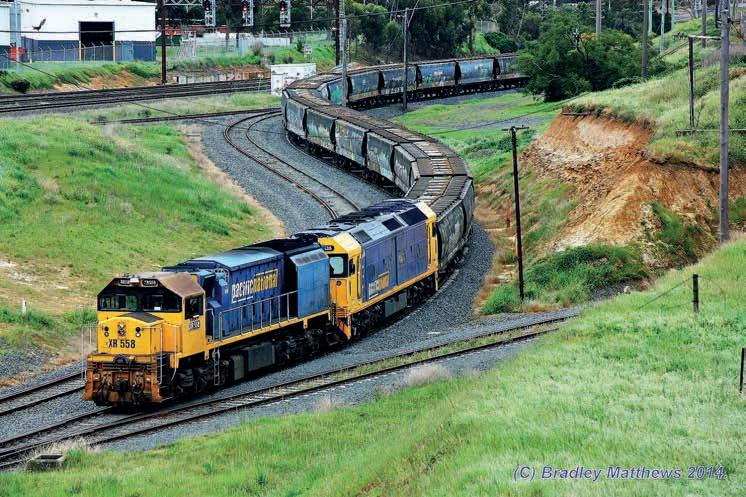
consult with the rail industry on their standards and codes of practice to make crossings safer for all.
News stories documenting level crossing incidents serve as urgent reminders of the importance of these safety initiatives. Tragically, lives have been lost, underscoring the urgent need for preventive measures to avoid such accidents in the future. It is simply not acceptable that any lives are endangered while using these crossings.
Our advocacy efforts have gained support from various quarters, including industry stakeholders, government officials, and safety advocates. By fostering collaboration and consensus-building, we will continue to be instrumental in driving meaningful change in level crossing safety standards. We will continue to prioritise public safety and do what it takes to prevent avoidable tragedies on our roads.
One of the key challenges in improving level crossing safety lies in addressing the diverse factors contributing to accidents. From poor visibility at crossings to inadequate infrastructure and deficient regulatory frameworks, a multifaceted approach is required to tackle this complex issue effectively. The ATA recognises the need for a holistic strategy that includes education, rolling stock upgrades,
reform, and greater utilisation of technology.
Government support is pivotal in driving systemic changes and allocating resources to address critical safety concerns. The ATA’s collaborative approach, coupled with government support, represents a shared commitment to improving level crossing safety nationwide. As policymakers consider legislative reforms and funding allocations, the ATA remains a vocal advocate for robust measures that contribute towards zero harm at level crossings.
Looking ahead, the ATA’s advocacy efforts are poised to shape the future of level crossing safety in Australia. We are championing innovative solutions, fostering partnerships, and maintaining a steadfast focus on outcomes. With collaboration and commitment, our vision of zero fatalities and serious injuries at level crossings is within reach, building a brighter and safer future for road and rail users alike.

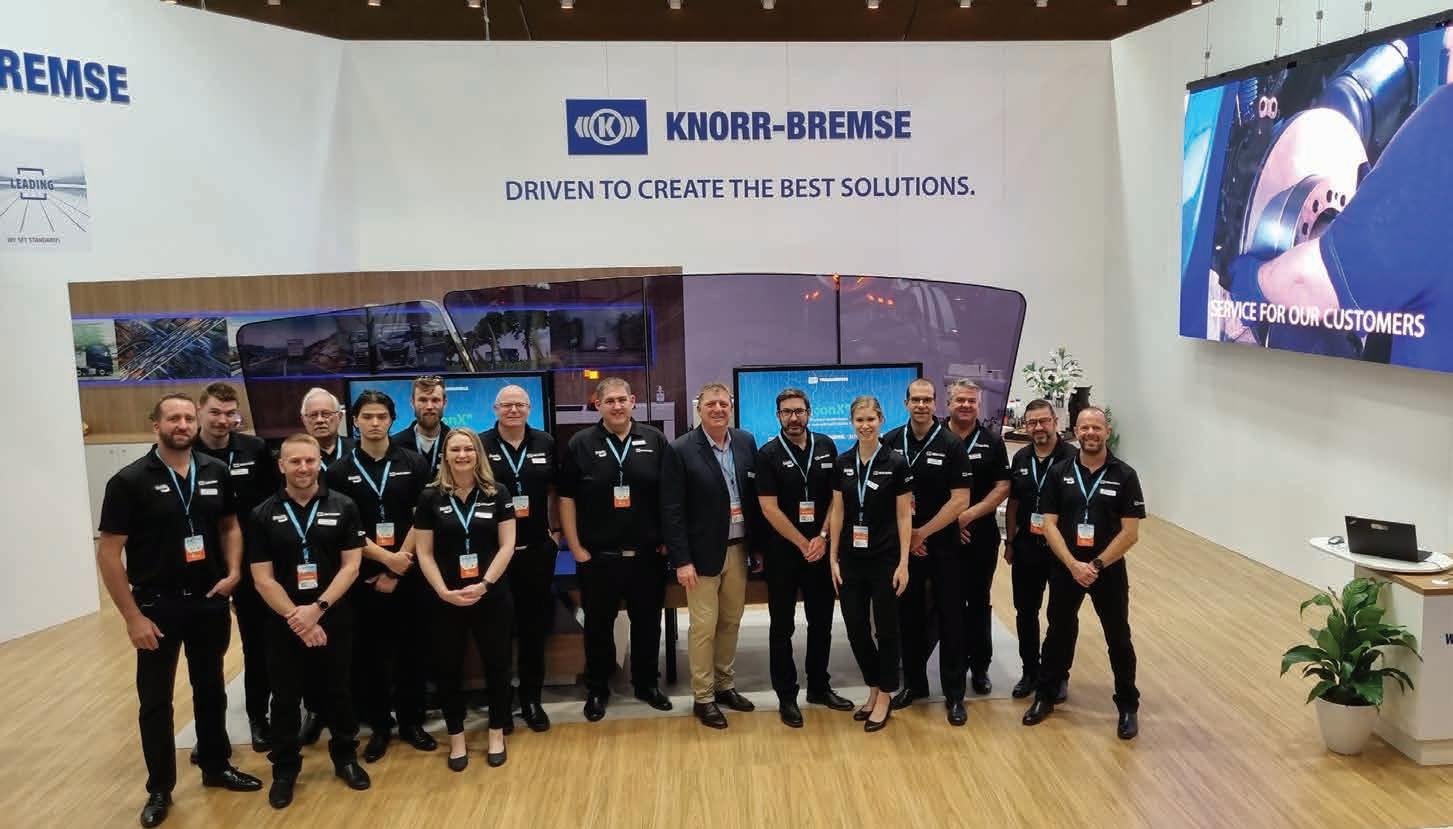
62
POWERTORQUE May/June 2024 INDUSTRY ISSUE SCAN THE QR CODE FOR MORE INFORMATION IMAGE: PACIFIC NATIONAL

TCA WEIGHS IN ON SMART OBM
PowerTorque sat down with Transport Certification Australia to find out more about smart on-board mass and what transport operators need to know before investing in the technology.
If you are driving a higher productivity freight vehicle, you are already familiar with smart on-board mass, otherwise known as Smart OBM.
Smart OBM provides greater assurance to road managers that heavy vehicles are operating within the approved mass limit for specific parts of the network and on routes that have been approved as suitable for their use.
When coupled with the Telematics Monitoring Application, these digitally connected on-board weighing systems are being used to introduce higher productivity access arrangements for heavy vehicles.
New South Wales and Queensland both require Smart OBM on specific kinds of Performance Based Standards (PBS) vehicles from 1 June 2024.
This follows the earlier introduction of Smart OBM in Victoria for Higher Productivity Freight Vehicles and specific PBS vehicles in Tasmania. More recently, Smart OBM is being used in Victoria and South Australia to enable increased mass limits for low and zero emission heavy vehicles.
PowerTorque caught up with Transport Certification Australia (TCA) to talk about some of the finer detail associated with the use of Smart OBM systems.
“The first thing to know is that not all Smart OBM systems are the same,” says Gavin Hill, General Manager Strategy and Delivery at TCA.
Although all Smart OBM systems are type-approved by TCA against performance based functional and technical requirements, there can be differences in the way different systems operate in practice.
Being an informed user helps to avoid potential pitfalls when purchasing and using Smart OBM systems.
YOUR PRIME MOVER NEEDS TO TALK WITH YOU TRAILERS.
The mass measurements derived from Smart OBM systems need to be shared with the telematics device fitted to the prime mover.
Smart OBM suppliers offer different ways of connecting prime movers and trailers – which respond to the diverse needs of the transport industry.
The two primary methods of connecting prime movers with trailers are: wired and wireless connections.
It’s important for heavy vehicle drivers to know what kind of connections are used, and that operating instructions provided by Smart OBM suppliers are followed.
“Like any technology, it is important to follow the manufacturer’s instructions to optimise the performance of a Smart OBM system,” says Gavin. “We’ve heard feedback from some drivers that they’ve had problems with Smart OBM systems. However, these problems typically emerge from drivers not following the operating processes provided by Smart OBM suppliers. If in doubt, contact your Smart OBM supplier.”
DON’T MIX AND MATCH SMART OBM SYSTEMS
Whatever Smart OBM system you choose to use for your fleet, you should use only one Smart OBM system for each heavy vehicle combination.
This means that, for multi-trailer combinations, different Smart OBM system types cannot be used on different trailers.
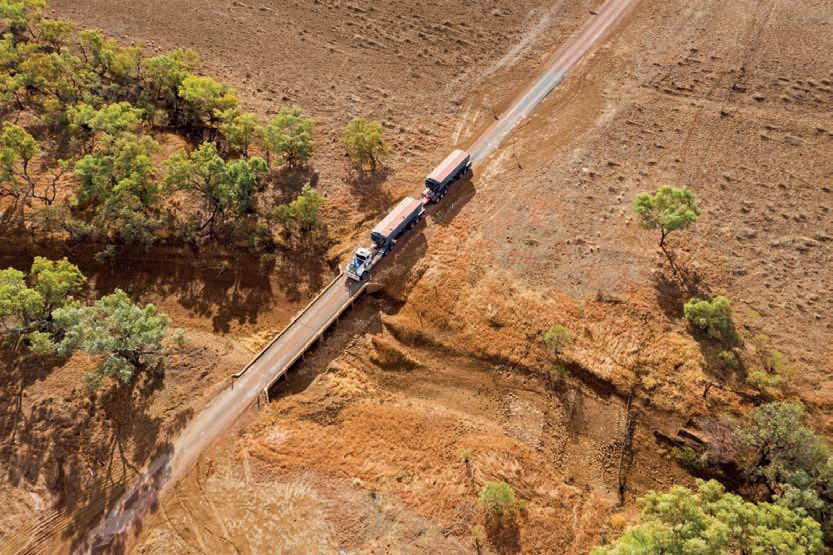
Mixing Smart OBM systems on a single multi-combination will mean the vehicle does not satisfy the Smart OBM operating requirement set by road managers.
More information on TCA-approved Smart OBM systems, as well as the existing pairing arrangements between Smart OBM systems and TCA-approved telematics devices can be found at: tca.gov.au/smart-obm-systems

60 CONVERGENCE
IMAGE: GETTYIMAGES / 1278566855
A WIRED OBM SOLUTION
While many operators are using Smart OBM which uses some form of wireless connection to report mass on line, there is also a wired system available, via electronic braking systems (EBS)
Fleets or operators who need to meet Telematics Monitoring Application (TMA) compliance requirements to run Higher Productivity Freight Vehicles (HPFVs), have a choice of possible technologies on offer, all of which will need some form of Smart OBM.
All of these systems are monitored and validated by Transport Certification Australia TCA) which assesses SMART OBM and Telematics devices on offer to meet the TMA requirements. The TCA website has a wealth of information around TMA and what is required to meet the various obligations for HPFVs.
On the TCA website there is a matrix which shows the compliant SMART OBM and Telematics solutions and also which pairings have been approved. Fleets or operators should not be put off by providers who have not yet paired as sometimes the pairings are already happening in the background and the approval may be imminent.
There are roughly eight or so SMART OBM providers on the market, as of the beginning of 2024, which can be found on the website.
TEBS based SMART OBM solution available, however other providers may well follow.
Trailers fitted with Knorr-Bremse TEBS will need calibration and reprogramming, they must also be semis or dollies fitted with airbag suspension to work with the iMass product which is on offer at this time.
Prime movers will require a prime mover retrofit kit which will be able to automatically pick up TEBS Trailer information via the CANbus and hence interpret the trailer mass. The prime mover kit also allows for fitment of airbag sensors and a levelling sensor to measure the prime mover mass and meet the TCA SMART OBM requirements.
One benefit of a TEBS based SMART OBM system is the fact that the vehicle unit is able to automatically pick up and display trailer masses, when the TEBS power harness is connected. This can benefit fleets who may not have dedicated truck/trailer combinations and require the flexibility to mix and match trailer and prime mover combinations. As long as all trailers are fitted with the Knorr-Bremse TEBS and it is powered up, the iMass mass information via the truck/trailer








•
•
•
•
•
•

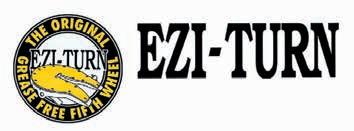
IS MANUFACTURED IN AUSTRALIA BY: EZI-PRODUCTS PTY LTD 2 RUTHERFORD ROAD, SEAFORD VICTORIA, 3198 PH: (03) 9775 0766 Email: info@eziturn.com www.eziturn.com WE STOCK AFTER-MARKET REPLACEMENT KITS TO SUIT MOST GREASELESS OR LOW-LUBE FIFTH WHEELS.
30 + years in the
Clean, grease-free fifth wheel
•
market place •
More cost effective
Easy to fit
Consistent steering
characteristics
Environmentally friendly
Australian designed & manufactured
Used by some of the most highly respected companies since 1990 EZI EURO 16B EZI JGL 37 IMAGE: KNORR BREMSE
GETTING ALL THE ELECTRONICS TO TALK TO EACH OTHER
Trucking operators are now adding more and more electronic equipment to their combinations and need to ensure they can all talk to each other when needed, especially when they are used for compliance.
Bluetooth and the connectivity is one of the issues which we may need to think about to get the most out of electronic monitoring.
Often, good communication depends on the structure of the network. If a system uses point to point bluetooth, like we use between our phone and CarPlay in our car, then the range has to be taken into consideration. With more sophisticated communication, like that between onboard mass measuring devices used for mass monitoring, the best way to get good communication of the data is using a bluetooth mesh network.
The mesh works like a wireless router does in your home, using multiple nodes to aid communication across the network. If a unit is not picking up a signal it can use another route to send the data. As these systems develop it is important that they keep up with the standards and are using the latest technology. If something like a Smart OBM (on-board mass) is using previous generation technologies there could be problems with accuracy in communication.
The mass measuring units on a multiple trailer combination should pass the message on from one to the next, making sure the data makes

its way to the main monitoring unit which handles communication for compliance. Point to point communication from the rear trailer of three to a telematics blackbox in a truck cabin may have intermittent communication.
Each generation of this technology has gotten better. Using a mesh, it is conceivable to have 10 trailers in a row and the communication will still be effective.
The alternative to using wireless communication is to rely on wired communication, and on multi combination vehicles this also has its issues. When you have humans involved, to make sure the plugs are connected or the connections do not have issues with corrosion or moisture in the joints, issues of communication can arise there as well. A damaged cable creates issues which might necessitate rewiring to maintain proper communication and therefore compliance.
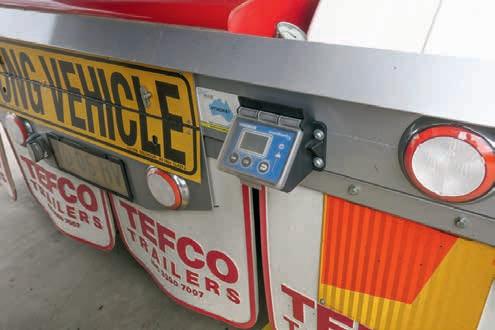
There has been some concern expressed in the industry that the technological development is moving so fast that the enforcement side of the equation are finding it hard to keep up with new technologies coming in and struggling to maintain
the same level of informed oversight to ensure all of the systems coming onto the market are going to securely meet the specifications set out in the legislation.
This then develops into a situation where the operator who buys a system, which is classified as compliant by the authorities, may find themselves in a situation where the data they are supplying to the authorities is compromised.
The delays and continuing discussions around the development of a new Heavy Vehicle National Law are also part of the problem and leave room for confusion. Once the HVNL is enacted, and that is still some time away, the guidelines for all of the compliance authorities involved should be clearer and some of the blurred lines may come into a sharper focus.
There does not appear to be a clear path on the policy side of things and the barriers to entry have been adjusted slightly to bring more players into the OBM field. This may help to satisfy the demand for this kind of equipment, but if the result is ineffective recording, and therefore, compliance, something is wrong somewhere.
62 POWERTORQUE May/June 2024 CONVERGENCE
IMAGES: PRIME CREATIVE
AIR-WEIGH: THE EFFORTLESS OBM SOLUTION
In the fast-paced world of transport and logistics, where technological advancements constantly promise to redefine efficiency, Air-Weigh emerges as a paradigm of simplicity and reliability in On-Board Mass (OBM) solutions.
For more than two decades, Air-Weigh has championed a straightforward, no-nonsense approach to vehicle weighing: a system so intuitive that it operates on the simple principle of “turn the key and go.” This editorial revisits the virtues of Air-Weigh’s technology, especially in contrast to the modern complexities introduced by Bluetooth-enabled devices in the OBM space.
A LEGACY OF SIMPLIFIED EFFICIENCY
While the recent influx of Bluetooth technologies in on-board weighing systems has been marketed under the guise of innovation, these solutions often fall short of their promise, complicating what should be a straightforward process. The reality is, Bluetooth technology, is primarily designed and best used for short-range communication in stationary environments, and struggles with the long range, openair, dynamic conditions of moving vehicles. Additionally, the use of Bluetooth technology also leads to operational inefficiencies, such as the need for drivers to manually pair devices to trailers, navigate through various apps, and ensure the correct sequence of trailers is selected before departure—a far cry from the simplicity and efficiency required in logistics.
Air-Weigh, with its rich history exceeding two decades, foresaw the potential pitfalls of overcomplicating fundamental processes. The company’s systems are designed to work seamlessly from the moment the ignition is turned, eliminating any need for driver input beyond their usual duties. This principle not only enhances the user experience
but also drastically reduces the margin for error, ensuring that each trip begins with the correct load measurements without the fuss of technical pairings or app management.
EMBRACING TRUE TECHNOLOGICAL ADVANCEMENT
True technological advancement lies not in adding layers of complexity but in streamlining and simplifying processes to achieve better outcomes. Air-Weigh embodies this philosophy through its commitment to providing user-friendly, reliable OBM solutions that stand the test of time and technology trends. By focusing on the essential functionality of providing accurate, immediate weight readings without the need for external inputs, Air-Weigh ensures that drivers and fleet managers can focus on what they do best: delivering goods efficiently and safely.
SETTING THE INDUSTRY STANDARD
Air-Weigh’s approach has not only set a high bar for what constitutes an effective OBM solution but has also highlighted the importance of reliability and ease of use in
the development of transport technologies. In an industry where time is money, and accuracy is paramount, the ability to “turn the key and go” represents a significant competitive advantage. It spares drivers from the convoluted procedures associated with Bluetooth pairing and ensures that fleets are always on the move, compliant, and operating at peak efficiency.
CONCLUSION
As the logistics and transport sector continues to evolve, the value of simplicity, reliability, and efficiency becomes increasingly apparent. Air-Weigh, with its unwavering dedication to these principles, stands as a testament to the power of innovation guided by practicality and real-world applicability. Over two decades, Air-Weigh has not just witnessed the evolution of on-board weighing technology but has actively shaped it, proving that the best solutions are those that make life easier for their users. In a landscape cluttered with complex gadgets and unfulfilled technological promises, Air-Weigh’s “turn the key and go”

63 www.powertorque.com.au CONVERGENCE
IMAGE: PRIME CREATIVE
HOW AUSTRALIA’S WORLDCLASS HEAVY VEHICLE REGULATORY ENVIRONMENT CAN POWER YOUR BUSINESS
Regulating more than one million heavy vehicles across our roads, Australia sets the standard as a global leader in transport regulation. Underpinning our regulatory environment are systems like Smart OBM and the telematics monitoring application (TMA), which provide the ability to operate at high masses across Australia’s vast road network.
Smart OBM and the telematics monitoring application (TMA), which provide the ability to operate at high masses across Australia’s vast road network.
While the regulatory system is important, the business benefits these tools provide can’t be overlooked. They allow operations at higher mass limits and on a larger number of roads, while also improving productivity, reducing maintenance costs, and creating a safer and more efficient road network.
DATA-DRIVEN INSIGHTS
The transition to Smart OBM and TMA is a crucial step towards national regulatory harmonisation and allows for cross-border efficiencies. As Anthony Laras, Teletrac Navman’s National Manager for Transport, explains, these systems give operators the ability to move more with less, which means the truck is now generating more revenue while saving on fuel, driver hours and maintenance costs.
“It means fewer trips for drivers, fewer truck movements, less CO2 emissions, less tire wear and tear, greater profit and enhanced safety,” he says.
Smart OBM, with the integration of digital scales, can take readings directly from each of the vehicle’s axle

groups to assure the business that the vehicle is compliant while maximising payload opportunities. Operators can plan more efficient routes at higher mass ratings, resulting in the ability to deliver loads more efficiently and better understand driving hours, equating to lower overall operating costs.
On the other hand, TMA provides a flexible and cost-effective approach to managing heavy vehicle access to roads that might otherwise be restricted using telematics. It monitors parameters including the location, time and identity of enrolled vehicles.
Together, Smart OBM and TMA work hand in hand to assure access, safety and efficiency for heavy vehicles using Australia’s road network.
Yet, innovation continues to drive the industry, especially with video telematics. Teletrac Navman’s IQ Camera is a TCA-type approved device that can be utilised by operators within the TMA program. This solution helps with the datadriven insights operators need to maximise safety and efficiency. It works together with AI and TN360 infrastructure to provide real-time data on driver and truck performance. If a driver is exceeding the speed limit or engaging in harsh manoeuvring,
braking, or following too closely, the driver will receive verbal prompts to modify their behaviour, while fleet managers will be notified in real-time, allowing them to coach the driver.
Subheading//The transition to TMA – Australia leads the world
Since the inception of the Intelligent Access Program (IAP), state road managers have been pushing to transition to Smart OBM and TMA to help remove barriers to entry and help the industry take advantage of these programs’ benefits.
TMA and Smart OBM work together to make Australia’s roads safer and provide authorities with the data needed to ensure road maintenance on the infrastructure used most.
For operators, the benefits are simple: greater road network access and operating at higher mass limits, meaning few trips, and having access to a greater number of roads, reducing drive time, and boosting efficiency while lowering cost. For some, it could also unlock the use of vehicle configurations that previously weren’t permitted.
Talk to your Teletrac Navman representative about how you can harness the power of Smart OBM and TMA to improve the safety and efficiency of your fleet.

64
CONVERGENCE
POWERTORQUE May/June 2024
IMAGE: MILOS-MULLER / ISTOCKPHOTO.COM
YOUR CHOICE REGULATORY PARTNER
Need assistance with a regulatory program?
Let us open up a world of opportunities as your choice TCA-approved provider for the IAP, OBM, TMA, and RIM programs.

Increase your payload to instantly boost productivity, turn around times, and profits.
Increased payload, unprecedented access, and ability to run PBS enabled vehicle configurations. TMA

Scan to learn more
1300 111 477 TeletracNavman.com.au
IAP
Smart OBM
&
RIM
Applications that provide a level of balance between compliance & productivity. NHVAS
Digital solutions to help you and your drivers comply with Heavy Vehicle requirements.
ARE YOU READY FOR THE 3G SHUTDOWN?
One of our current mobile phone networks, 3G, closes down soon and anyone operating a transport operation needs to ensure there are no remaining 3G sims in their equipment before the cut-off date.
Time in technology moves on fast. The current mobile phone network runs on three generations of mobile phone network, 3G, 4G and 5G. That all changes this year, with the shutdown of the 3G network.
The Vodafone network shut its 3G service in December 2023, the Telstra network will close on June 30 2024 and the Optus network is scheduled to shut down by August 31 2024.
More and more these days, transport operators rely on telematics devices to aid them with issues like access or run their operation through tracking and communicating with their employees and equipment. With the ending of the 3G service, operators need to upgrade any of their devices which still use 3G and replace them with those using 4G or beyond.
Failure to upgrade could mean some of the tracking or communication equipment included in an operation may no longer be compliant and the fact that the communication device is out of service would put the operator in breach of the rules.
“There’s numerous benefits in closing down the 3G network,” said Chris Meisnner, from Telstra,
speaking to the Livestock, Bulk and Rural Carriers Association conference. “The number one benefit from our perspective, when you think about a mobile network, and you think about the capacity on the mobile network spectrum, it’s absolutely key to making sure that we can provide the services that all our customers need.”
The older 3G technology uses up a large part of that spectrum. By closing 3G, Telstra frees up spectrum and can then start to redeploy that across the network to support the incoming 5G network. Telstra have committed to getting 5G out to 95 per cent of the population, by June 2025.
There are around 180 sites that have unique 3G coverage, or they only have a 3G presence. Then there are about 800 sites that will need an upgrade to make 4G more effective. Telstra has roughly 11,700 sites around the country.
“We will be turning off the 3G network,” said Chris. “Talking to some people, it still feels like there’s a little bit of doubt out there, that it might be wrong, or we might not actually keep to the date, but we are absolutely committed to it and have made a firm decision. What that looks like in the 3G network itself, is we can pretty
much shut it down in one night.
“So, if you’re hoping it will just continue on, it won’t, we will be shutting it down. We have set up all of the automation and scripting that’s in place to effectively shut down all those 3G systems on all of the sites.”
There are a number of issues around ensuring everyone is aware of the shut down. Many users wouldn’t know for certain which network any particular device uses. The array of different devices which there may be in a transport operation grows every years and some of them will be difficult to keep track of.
“The main thing that we are doing is getting the message out that you do need to engage, you do need to check and you do need to have a look at devices that you’re relying on and take action,” said Chris. “We’re just on the road now constantly, getting out there, making sure the messages are out there with all of our customers.”
Those not sure whether they are still on 3G can go to the Telstra website and it has a long list of FAQs. Customers can navigate through that site and find out whether their devices might still rely on 3G. Alternatively, they can go into a Telstra store and simply ask the question.


66 CONVERGENCE
POWERTORQUE May/June 2024

STILL A BRUTE

Steve Grahame had the greatest respect for the KTA600 in his 1994 Kenworth C501 Brute, a roadtrain prime mover he has owned since 1999 and recently repowered with a new Cummins X15 Euro 3 engine.
The Brute had clocked up 1.7 million kilometres when Steve bought it, most of those being hard kilometres hauling cattle for Alice Springs-based Tanami Transport.
Today, Perth-based Steve estimates his 30-year-old Kenworth has done close to 4 million kilometres and he talks with a definite tone of pride about the condition of the truck – testimony to the rugged strength of the C501 and the way he looks after it.
With the 19-litre KTA600 no longer sitting out in front, the focus is on the X15 which was slotted into the C501 chassis in a repower project in 2023.
“The KTA600 needed a rebuild due to a dropped valve and it was going to be costly, so when I looked at the economics I decided the X15 was the way to go,” he confides.
IMPRESSIVE AT 600 HP
Steve put the repowered C501 into service in September 2023, with the X15 Euro 3 engine initially rated at 550 hp and peak torque of 1850 lb ft.
“Pulling three trailers, the X15 wasn’t quite there compared with the KTA600,” he states. “The KTA had less torque than the X15 (1650 versus 1850 lb ft) but its big lungs
“With the X15 now uprated to 600 horsepower and 2050 lb ft of torque, it’s very impressive.”

“However, with the X15 now uprated to 600 horsepower and 2050 lb ft of torque, it’s very impressive,” he says.
“I like the improvement in fuel consumption, too,” he adds enthusiastically. “I’m consistently saving between 100 and 150 litres per 1500 kilometres.”
The X15 Euro 3 engine is becoming a popular repower option. It shares the same base engine hardware as the X15 Euro 6 powerhouse but without SCR aftertreatment; it can only be installed in pre-2008 registered on-highway trucks.
Steve Grahame – “I’m 73 this year” – has been on the road for 52 years and is a celebrity in his own right, having starred in every season of the popular television show Outback Truckers since 2012, taking viewers into some of the most remote areas of Australia.
Steve’s phone number is on the door of his truck and thanks to the show’s global success – it has been aired in over 120 countries – he has received many calls from people overseas. “The number of phone calls I get from all over the world is amazing so I’m proud to be part of the show,” he confides.
Steve Grahame’s work is mainly delivering building supplies to outback communities.
www.cummins.com/en/au/cummins-australia
CHARGING
AHEAD

From my experience truck manufacturers over-exaggerate the capabilities of their electric vehicles, says PowerTorque’s European Correspondent, Will Shiers.
68 GOING GLOBAL
POWERTORQUE May/June 2024

That maximum range figure quoted in the sales literature looks great, but tends to shrink somewhat in real world conditions, where external factors such as weather, terrain, congestion and driving style are thrown into the equation.
Apparently, this doesn’t apply to Scania, at least not according to Magnus Mackaldener, who is responsible for electrification development at Scania R&D. At the launch of its R40 and R45 batteryelectric regional prime mover units, he said: “We believe that an average 40-tonne truck in real world conditions consumes 1.25kW per km, and we have done the maths. We don’t measure on a 25-degree day with the wind behind us.”
I hope he’s right, as I’m about to drive an electric Scania semi 616km from Trysil in Norway to Scania’s hometown of Södertälje in Sweden, and the temperature is -27 degrees!
My truck for the two-day journey is a 40R regional 4x2 prime mover. Located along its chassis are six 104kWh (624kWh total) nickel manganese cobalt (NMC) batteries. They power an electric machine, comprising three electric motors with a continuous output of 400kW (544hp), which is matched to a 6-speed Opticruise transmission.
According to Scania’s calculations, when running at 40 tonnes, this truck has a maximum range of 350km. While I will be running at a slightly lighter 34 tonnes, which in theory should extend the range slightly, the sub-zero temperatures I’ll encounter throughout the drive will clearly have a negative impact.
DAY ONE
In extremely cold climates it’s important to precondition the batteries and heat the cab while it’s still connected to the grid. Getting them to their optimal temperature while the truck is still pluggedin preserves the range. Likewise, maintaining the in-cab temperature takes far less energy than chasing the temperature. So, using the Scania Driver app, this is exactly what I do a few hours before setting off. And

I’m immediately surprised at how well the Scania grips. With maximum torque available from the outset, I had expected an instant loss of traction, but the Michelin X Multi Grip tyres prove otherwise. It also helps that there’s no interruption in torque between the infinitesimally quick gear changes.
The main roads are largely clear of snow, and I make quick progress as I travel southeast towards Sweden.
I have mixed feelings about electric trucks, and am far from convinced that they’re the silver bullet the industry is searching for, especially not for long distance work. That said, I’m not denying that they’re an absolute joy to drive. With instant torque, effortless power, and lightning quick gear changes, what’s not to like?
The Scania is particularly good. I have driven battery-powered trucks before where you can hear a cacophony of squeaks and rattles from the cab, but that’s not the case in the 40R. You can’t fault the interior build quality, and without a combustion engine under the cab, you are met with almost total silence at low speeds.
The terrain is hilly, and there’s plenty of opportunities for
the battery, so extending the range. Driving an electric truck requires a slightly different driving style to diesel, and training is advised. Scania says the range can vary by 20 per cent depending on the driver.
Norway is embracing electric trucks like no other European country, and that’s because they seem to make sense here. The country produces almost entirely renewable electricity, which equates to a typical well-to-wheel CO2 reduction of 99 per cent when compared with diesel. In contrast, the European average reduction is just 55 per cent. Also working in Norway’s favour is relatively cheap electricity, and expensive diesel.
That said, I’m noticing a constant stream of V8-powered Scania 25.25m, 60-tonne logging trucks travelling in the opposite direction. Apparently 50 per cent of everything the truck maker sells in Norway has a V8 under the cab. I sense it’s going to be a long time until these have switched to electricity.
My first stop is an Ionity public truck charger on the Norwegian side of the Norway/Sweden border, some 190km from the starting point. This will be a chance to use the Scania Charging Access card I’ve been
69 www.powertorque.com.au GOING GLOBAL
IMAGES: SCANIA TRUCKS

Not helping access is a thick ridge of snow around its perimeter, left by a passing snowplough. It takes 30 minutes, but I finally manage to get the semi onto a bay, only to trip the charger as soon as I plug the truck in. The place is unmanned, and there’s nobody to advise me. Things don’t improve when I trip a second charger. In frustration I am forced to drop the trailer nearby and return with the solo prime mover.
issues, and with a delivery rate of 350kW, it takes just 48 minutes to
lack of facilities, not even a toilet.
With yellow snow in my mirrors, I cross the border into Sweden, and put Scania dealer Lecab Lastbilar’s address into the sat-nav. It’s based in the city of Karlstad, some 130km away. Despite the temperature being -18, and me using the cab heater, heated seats, headlights, radio and mood lighting, the truck returns a
nearby hotel, I can see on the app that it takes just over an hour to recharge at a rate of 197kW. Knowing that I’ll be setting off on the final leg at 8am the next morning, I set the battery conditioning and cab heater to turn on at 6.30am.
DAY TWO
It’s a balmy -10 degrees this morning, almost tropical compared with yesterday. That said, I’m still looking forwards to climbing into a nice warm cab. However, at some point in the night a security guard spotted that the truck was fully charged, and trying to be helpful, unplugged it.
Although aware that the cold cab and batteries will have a detrimental effect on the truck’s range, I’m not too concerned. Although Södertälje is 300km away, I’ll be stopping in 128km to top up the batteries anyway, so don’t have range anxiety. In fact, knowing that I’m less than two hours away from power, I’m heavier on the accelerator than yesterday. The 40R has plenty of power, and

70 POWERTORQUE May/June 2024
GOING GLOBAL
The OK Q8 charger is located on an easy-to-access industrial estate, and the 350kW chargers sit on either side of wide bays. It’s a refreshing change from yesterday’s first stop. I plug it in and watch as the battery starts to replenish – 68 per cent, 69 per cent, 70 per cent, 71 per cent, 72 per cent and nothing! The charger has tripped.
I switch bays and start again, and once more it allows me to add 5 per cent of charge before tripping. In desperation I drop the trailer and go in search of another other local truck charger, only to discover that it’s too small to accommodate the truck. Could I attempt to do the journey in one hit?
Fortunately, Scania UK’s pre-sales technical manager Phil Rootham has been following in a car, and he’s already got his calculator out.
“There is an installed capacity of 624kWh, of which we work in a 75 per cent state-of-charge(SOC) window, so if I multiply 624 by 75 per cent I get 468kWh of useable energy if the battery is charged to 100 per cent,” he says.
I don’t have a clue what he’s talking about, so just nod.
“We have 74 per cent of charge, so if I multiply the 468 by 74 per cent it equals 346kWh. Yesterday we had a worst consumption of 1.47kWh/ km, so if I divide 346 by 1.47 I get a predicted range of 235km, and Södertälje is 172km away.”
I understand the end bit – in theory it’s doable! However, it’s cold (the forecast today is a high of -4 degrees). I decide to take the risk.
As it happens, the conditions are in my favour, with undulating hills and light traffic. I set the cruise control to the legal speed limit, which ranges from 70kmph to 90kmph, and let the truck do its stuff. It behaves impeccably and has the same great driving characteristics that you’d expect from a Scania, only it’s quieter and smoother.
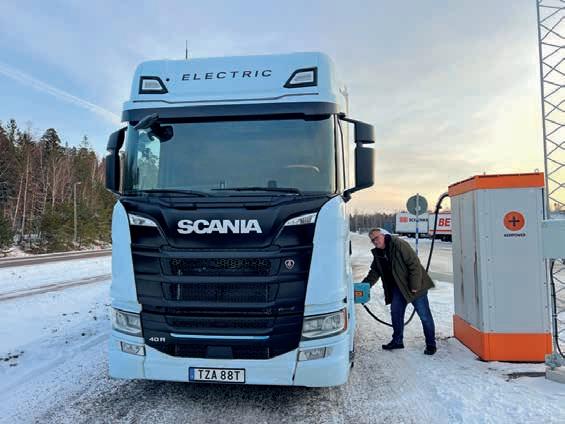
I’d like to tell you that it’s a nailbiting finish, and that I finally roll into Scania’s demo centre with just one per cent of charge left, but the truth is far less exciting, and I arrive with 26 per cent to spare. For this leg
it’s consumed 1.249kwh/km, which equates to a possible maximum range of 374km. Admittedly I’ve been running at 34 tonnes instead of 40 tonnes, but then there’s the temperature to consider.
All in all, it’s a fantastic performance, and if anything, Scania has underestimated the truck’s range. Now that makes a refreshing change.
Say goodbye to complex paper-based safety management systems.
Hubfleet is a paperless, NHVR approved system that streamlines the way you manage your business. Our smart and intuitive dashboard shows you everything you need at a glance and our automated tools let you delve deeper when you need more insights. The


complete digital compliance system.
• Fatigue Management • Mass Management
www.hubfleet.com.au GOING GLOBAL
• Maintenance Management • Vehicle Tracking
HEADING INTO THE TRUCKING FUTURE
Industry stalwart, Bob Woodward, looks back on the developments in technology and wonders...
Over the past 35 years there has been significant improvements in productivity longer combinations with heavier axle groups within the Australian road transport fleet. Increased axle group mass has been concurrent with developments in suspension systems, longer new combinations have resulted from research and broadened knowledge of vehicle dynamics. But there has also been significant development in emissions (cleaner engines) and safety technologies ABS and EBS.
There has been much learning along with many frustrations, but in the main, perseverance won through. There continues to be operators who believe that they are are superior to safety systems such as EBS, but I guess no matter the technology there will always be a minority who think that they are smarter.
Autonomous vehicles have been on the horizon and they will come but one of the many issues in this vision is that of interfacing of guidance and information standards. Many new vehicle smarts such as technologies that interrogate speed signage and, if active, can limit the speed of the vehicle accordingly, but only functions if the driver chooses to do so.
on the standard of the signage and its installation. Unlikely to function when the sign is located behind an overhanging tree branch. Another is the auto dimming of high beam on rural roads, but this can a significant hazard when the high beam dims because of roadside signage reflection.
AXLE GROUP MASS
In the past 35 years single steer axle mass has increased from 5.4 tonnes to 6.0 tonnes to 6.5 tonnes and even more than 7.0 tonnes (in some jurisdictions at a fee) driven by larger vehicle combinations requiring greater horsepower in conjunction with more stringent engine emission standards. Australian road designers and maintainers are constantly critical of heavy vehicles damaging roads; but with inadequate design standards, poor maintenance and overprotective attitudes it will continue to be a challenge.
were opposed to increases in mass (Higher Mass Limits) supposedly because of infrastructure deficiencies, then the Intelligent Access Program arrived and suddenly these same structures suddenly got stronger, another example of red tape bureaucracy.

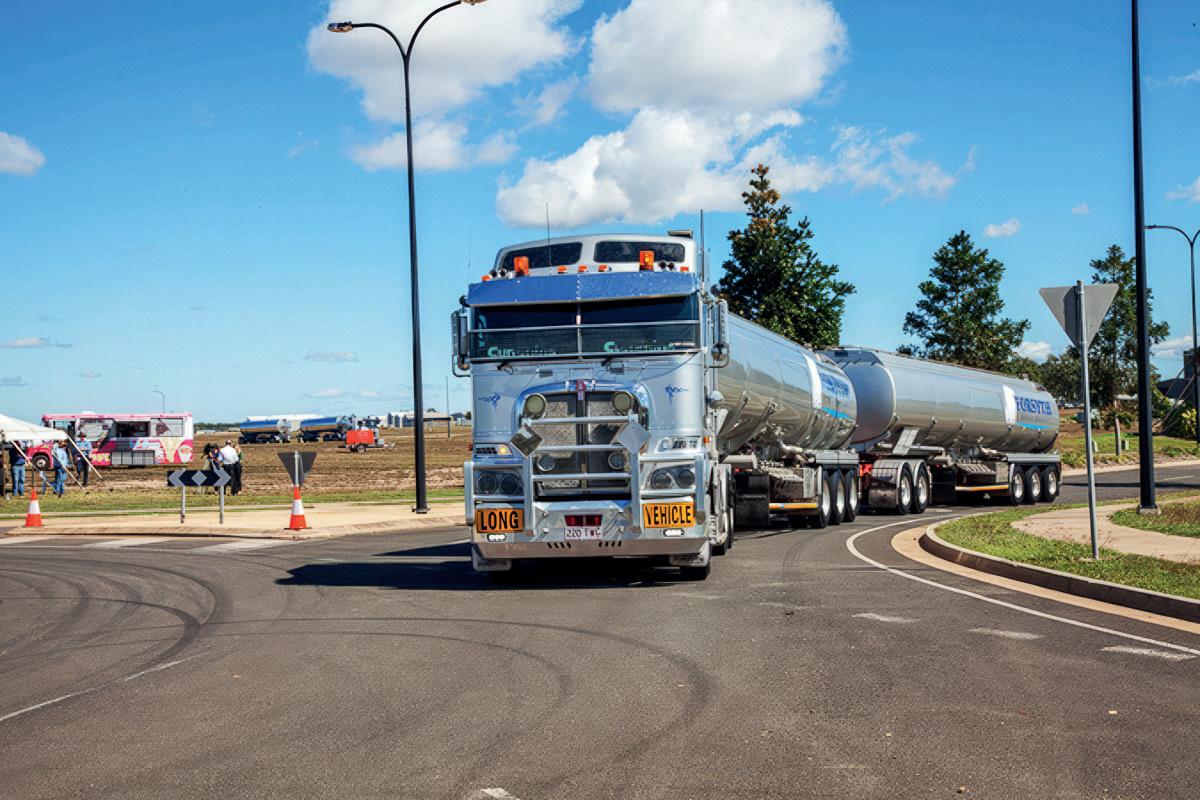
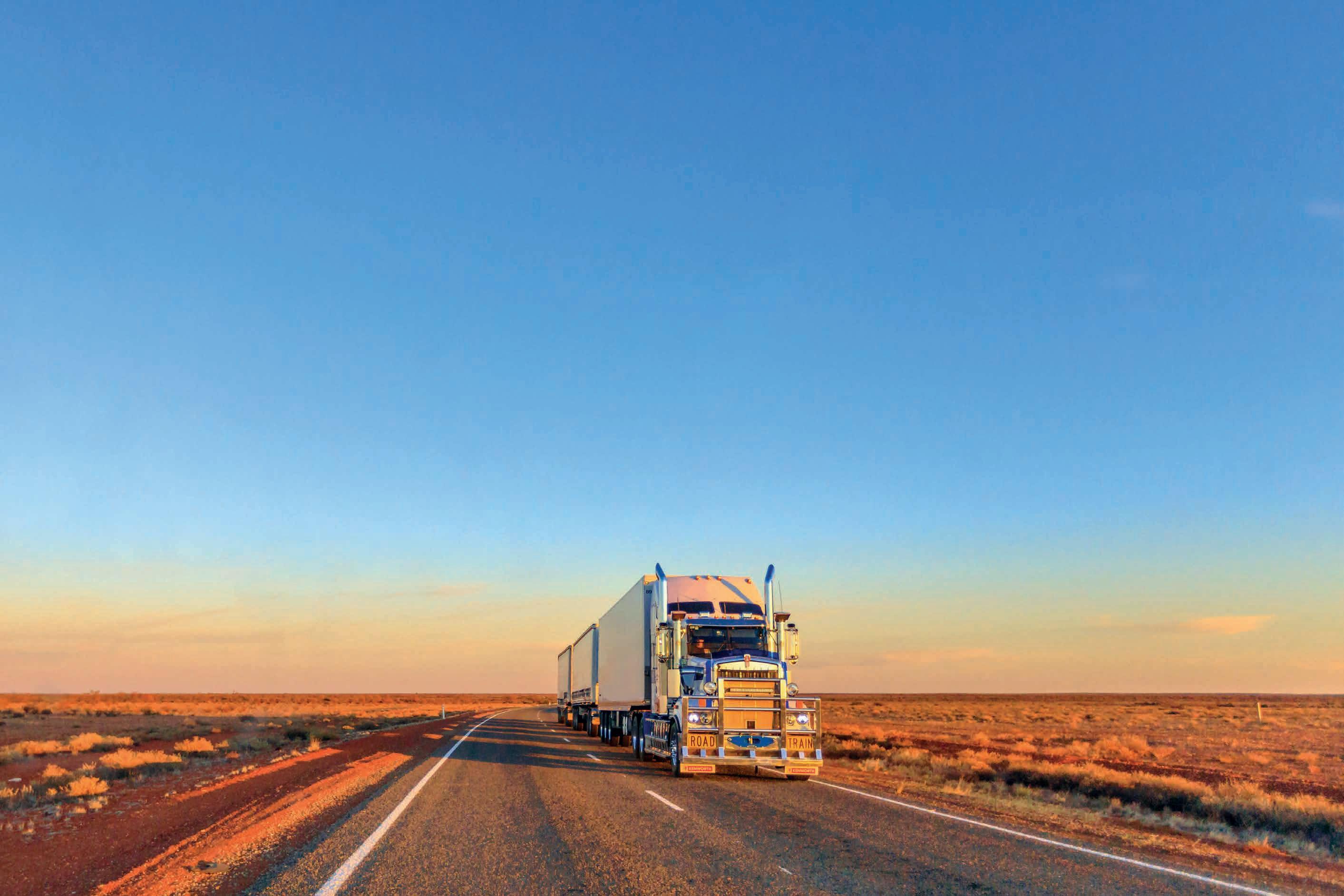
72 TECH KNOW
POWERTORQUE May/June 2024







YOUR NATIONAL STATION 24/7 Visit us on www.australiantruckradio.com.au Scan and LISTEN NOW For advertising opportunities contact tosan.popo@primecreative.com.au or call +61 481 260 352
the steer-axle quick fix of 2006! The solution needs to be 100 per cent technical. Eight tonnes on a single tyre steer axle will require something like a 315/80R22.5 tyre at around 125 psi (850 kPa). If 850 kPa is OK for the thin chip seal then publish that as a figure as a National Standard (no secrets) and progress. Don’t overlook the twin steer configurations, comparatively, these need to be a minimum of 12.5 tonnes (6.6 tonnes per axle), a 295/80R22.5 or a 305/70R22.5 at 850 kPa.
There are Local Government jurisdictions that still do not allow CML/HML, what will their position be on these mass concessions?
If a zero-emission prime mover is used in a B-double what is the implication of these mass increases on axle spacing mass schedule – and let’s not continue to play games (like VicRoads do with structures – when the group axle spacing is 1180mm rather than 1200mm).
There are technical solutions to the rubber on the road issues, but where do bridges and culverts stand? Will there be a minimum clear space between a single steer axle and the first axle of the prime mover tandem group?
EMISSIONS
Recently there has been much hype about emissions of larger SUVs and tradesman utilities and emission

standards. Australia is not the architect of any emission standards the ADR 80 suite of emission standards are, in the main, an adaption of Euro or other international standards. None of these vehicles are manufactured in Australian and no manufacturer develops an engine in Australia specifically for Australia.
There is much talk about battery electric vehicles, but it seems technical convenience isn’t providing answers for the hard questions.
• What is the source of power to charge these vehicles coming from, especially at night if it’s not coal/ gas?
• What happens to the out of service batteries?
The recharge for BEV’s will need to come from the grid. Regional areas already pay more for access to
the power grid and supply than do metropolitan suburbs. So once again, the regional areas will pay for the city centric ideals.
Solar doesn’t produce power at night and wind generators don’t produce power in calm conditions. The ACT promotes renewable energy, the ACT 26 turbine wind farm can reportedly generate 390 GWh of clean energy per year.
In 2021 Australia reportedly generated 265,000 GWh of electricity, of which 71.7 per cent was being generated from coal (52.9 per cent) and natural gas (18.8 per cent), that’s 190,000 GWh, in simple terms Australia would require 500 ACT wind turbine farms to replace coal/gas. However, none of this addresses the issues of suitable grid distribution in getting the electricity to the transport recharge site.
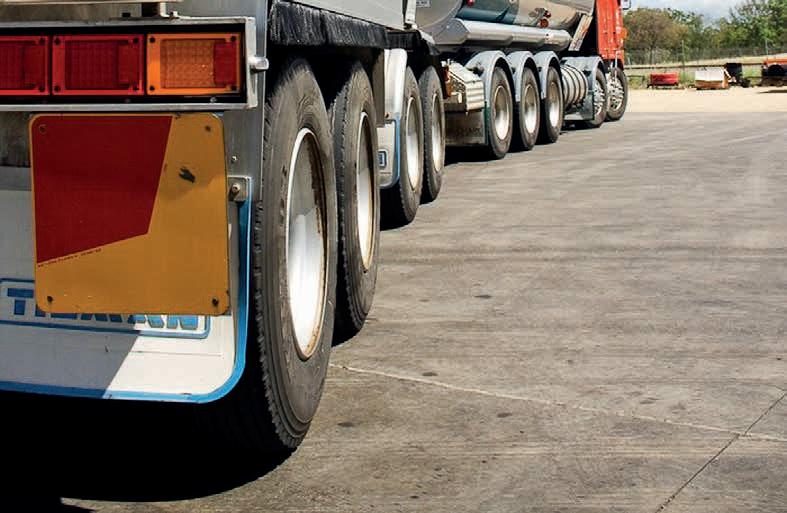
To the end of 2020, the Australian rigid and articulated vehicle fleet reportedly annual consumption was 7,465 megalitres of diesel. Assuming an ICE diesel engine thermal efficiency of 40 per cent this equates to an actual transport task energy equivalent to 2,986 megalitres of diesel.
To substitute transport diesel with electricity, there is a need for a further equivalent of 82 ACT wind farms; and, much of this energy requirement will be at night, hence solar will be of little benefit, thus the grid will be very dependent on wind generators. With this zero-emission wind power generation, when will the promoters be specific on what happens to the life expired wind turbine blades?

74 POWERTORQUE May/June 2024
TECH KNOW



ZMD ™ Shockless Ride Technology Actual product performance may vary depending upon vehicle configuration, operation, service and other factors. ©2024 Hendrickson USA, L.L.C. All Rights Reserved. All trademarks shown are owned by Hendrickson USA, L.L.C., or one of its affiliates, in one or more countries. Reduces Maintenance Reduces Maintenance hendrickson.com.au Never Change a Shock Absorber Again
WORN HANGER REPAIR
Hangers are not an item that normally wear. However, they may become gouged or worn from a loose pivot bolt or wear washers that have worn through.
Any hanger wear or gouging will need closer inspection to determine the repair needed. Hanger wear less than 1 mm deep will usually be acceptable, provided there are no cracks or sharp ridges that cannot be smoothed out.
Hendrickson has developed repair kits to restore considerably gouged or worn hangers. Each kit includes two adaptors, bolt, nut, and washers to repair one hanger.
However, the hanger should be replaced if the damage is severe.
Additional QUIK-ALIGN pivot hardware and wear washers should be purchased as required. To do so, follow these steps to safely replace your hangers.
1. Support axle to prevent it dropping and remove the pivot fasteners.
2. L ower suspension trailing arms away from hangers.
3. Discard used fasteners and wear washers.
4. Remove hanger alignment collar by grinding off the weld. Do not use a cutting torch because the heat will alter the strength of the hanger. Ensure that no hanger material is removed when removing the alignment collar.
5. Cut pivot bolt openings in hanger to suit step in repair adaptors. Openings must be level horizontally and approximately 78 x 58 mm in size.
6. Install the two new QUIK-ALIGN hanger repair adaptors onto the hanger. Position the adaptor with the alignment guides on the outboard side of the hanger. For the wide bush suspension guides, ensure the stamped “TOP” marking is facing upwards. The narrow bush adaptors are symmetrical, so they can be fitted in any orientation.
7. Clamp adaptors in place, ensuring they are level horizontally and as far forward as possible.
8. Measure the distance of the adaptors from the bottom of the hanger to ensure they are level within 1 mm.
9. Weld the adaptors to the hangers with complete all-round 5 mm fillet welds.
10. Assemble suspension trailing arms with new QUIK-ALIGN pivot hardware and wear washers. Ensure the eccentric flanged washer is outboard, with the square adjusting hole at the 12 o’clock position.
11. Tighten pivot bolt to around 100 Nm to hold in place until the alignment is completed.
12. Reassembly trailer and align trailer axle(s) to manufacturer’s specifications.
13. When axle is properly aligned and at ride height, fully torque the wide bush QUIK-ALIGN repair kit 1”-14 UNS bolt to 850 Nm. Torque any standard and narrow bush pivot bolts until the Torx head shears off, which is approximately 800 Nm.
14. After alignment, paint all affected areas to the trailer manufacturer’s specifications.
15. Recheck trailer components and

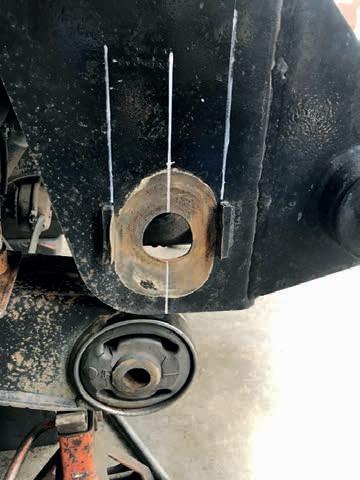
damage like this, the best approach is to prevent the damage from occurring in the first place.
Regularly inspect the pivot hardware to ensure that it is properly torqued and replace any wear washers that have worn through.
Taking these preventive measures can help avoid costly repairs and downtime.


76 TECH KNOW
POWERTORQUE May/June 2024
Marking Hanger To Cut Pivot Openings
Typical Worn Hanger
Welds for Worn Hanger Repair
IMAGES: HENDRICKSON


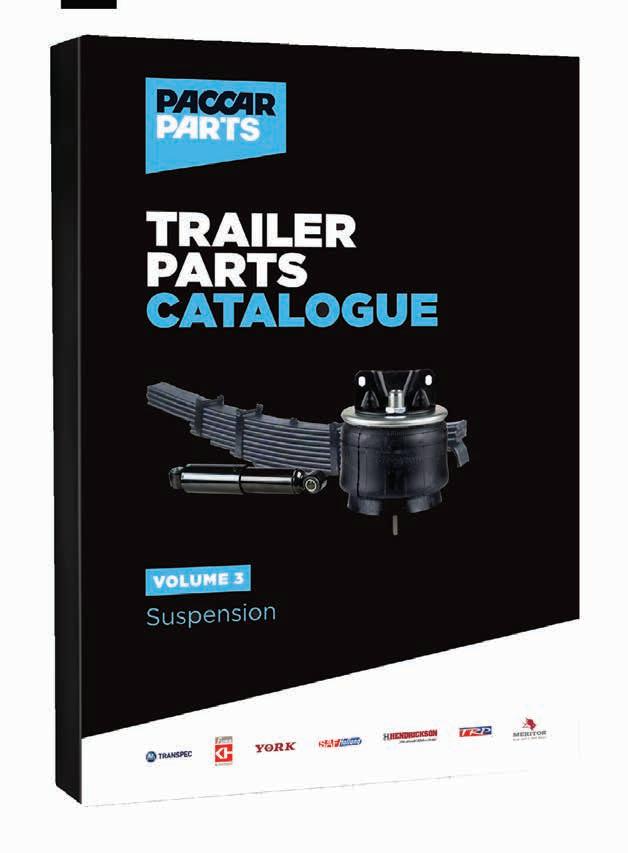


TRAILER PARTS CATALOGUE Parts for Trucks... & Trailers too! VOLUME 3 OUT NOW! The all-new one-stop reference guide for all your Trailer Suspension needs. To order your hardcopy contact your nearest dealer Freecall* 1800 PPARTS (772 787) Calls from Australian landlines are generally free of charge whilst calls from mobile phones are typically charged based on the rate determined by the caller’s mobile service provider. Please check with your mobile service provider for call rates. Volumes 1 and 2 covering Axles / Slack Adjusters, S-Cams / Braking & Wheel-End also available. * Visit paccarparts.com.au/trailer or scan the QR code to download your copy now! NEW
REFRIGERATION TRANSITION PART THREE
In this final instalment of our three part series of articles exploring the transition of refrigerated transport across to zero emission running, we will explore some of the solutions we will see on our roads in the near term.
In this series so far we have explored the challenges and options available to refrigerated freight fleets. Now we switch our focus to what zero emissions solutions we are likely to see on our roads in the next 18 months.
The first thing we can be sure of is that there will be more electric refrigerated trucks hitting the road in coming months than ever before, we are at the very beginning of the steepening curve of exponential growth. This is in both trucks on the road and models available.
As mentioned in the our past articles, not all segments of the refrigerated rigid truck sector will be electrified, payload and range will restrict the largest of trucks. Twin steer chassis, which are relied on for the largest 14 pallet trucks are not set to electrify in the near term. The action will be at the lighter end of the market, as payload requirements can typically be met and short distance urban delivery are perfect for electric vehicles.
Hydrogen powertrains still remain a little way off for this application. Much of the limited stock of the larger hydrogen trucks will go to other applications like waste, concrete and semi trailers. As this technology finds its niche in these heavier applications, those learnings will filter into applications like refrigerated transport.
The refrigerated vehicles we will see in larger volumes will be supporting home grocery delivery and urban food delivery (cafés, restaurants etc). An example of the confidence in this end of the market is Woolworths’ order for around 130 Foton T5’s for their home delivery services across several sites.
Another popular segment that we

have seen adopt EVs are eight pallet trucks delivering fresh products to stores across metro areas, typically using a Volvo FL. Expect to see several more deployments like this throughout 2024.
Several new to market EV models and brands will join our roads by the end of 2025. Refrigerated EV specialists Eurocold/Revora have been monitoring the market for over 12 months now and expect the available models to double in 2024. However, the jury is still out on their suitability.
“Not all EV rigids are built the same and some are not refrigeration ready,” says Nathan Gore-Brown, Revora GM. “Cold freight fleet managers will need to look closely at the viability of each chassis they consider. Expect an influx of new brands you have never heard of offering compelling electric rigid trucks, its time to consider your approach to these new choices.”
The two other areas we will see action around are, charging solutions and financial packaging of
is a sometimes-hidden challenge for a transition, often compounded by site specifics. If you are looking to go electric, get onto your charging solution early and talk with your truck solution partner and engage with several providers before selecting a solution.
Renting or leasing your EVs might be a way to manage the risk and reduce the impact of increased capital expenditure, when compared with diesels. Operating the asset but not owning it is expected to increase rapidly in the electric trucking future.
Whatever your journey with electrification in the coming 18 months it is likely to include seeing many more refrigerated EVs on the roads, plenty of online discussion and lots of learning.
Eurocold/Revora aims are to show they are aligned with refrigerated transport companies and offer leadership and support to the industry in all aspects including the zero emission transition.
78 COLD CHAIN
POWERTORQUE May/June 2024
IMAGE: PRIME CREATIVE


































































































































































certified

SAFER CLEANER CONNECTED
THAT’S ANOTHER HINO

THE 700 SERIES, BUILT FOR THE FUTURE.
The Hino 700 Series rewrites the rules in safety, emissions and connectivity. It’s our safest truck ever, with an enhanced Hino SmartSafe package including Pre-Collision System, Pedestrian Detection, Lane Departure Warning System and Driver Monitor. Designed to meet Euro 6 exhaust emission standards, it’s the cleanest Hino heavy-duty yet.
With Hino-Connect on board, benefit from superior business intel and support, it’s next-generation telematics delivered in real-time. The 700 Series is the truck of the future, here today. Find out more at hino.com.au

XAVIER_HINO39678





































































































































































































































































































































































































































































































